Part 1: Get Started on Parent's End
Get started with AirDroid Parental Control by first installing and registering an AirDroid account on the parent's device.
- Step 1.Download AirDroid Parental Control
Directly search for AirDroid Parental Control on Google Play or App Store to download it. You can also download the app by clicking the download icon below.
- Step 2.Register an AirDroid Account
Install and launch AirDroid Parental Control on your devices. You will be directed to the sign-in page. If you haven't registered for an AirDroid account, please click "Create one" to sign up.
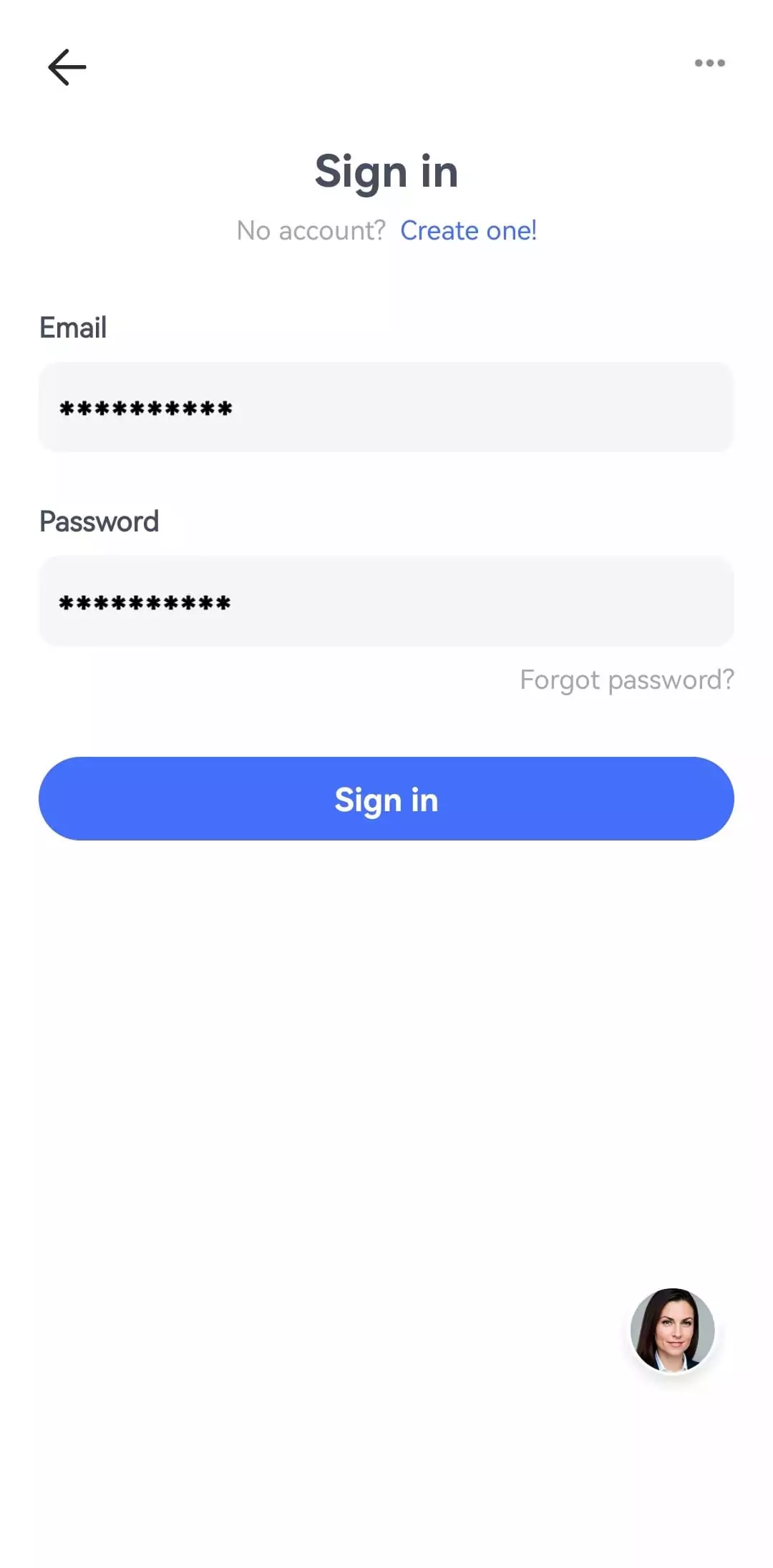
- Step 3.Select Device Owner
Follow the on-screen instructions to select "Mine" and click the "Agree" button to proceed to the next step.
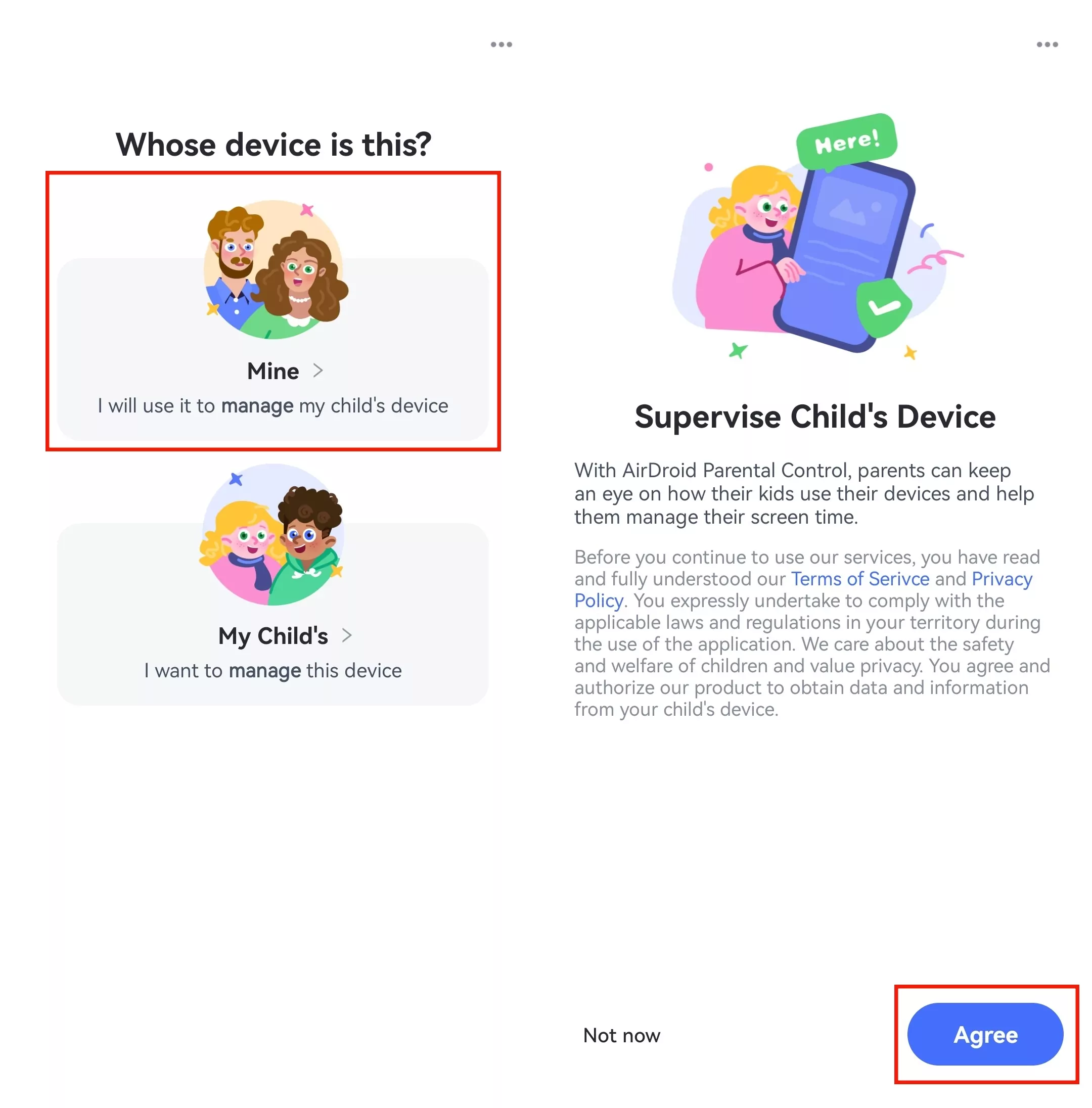
Part 2: Connect Kid's Device
Below are the detailed steps to tie up your kid's Android device.
We have also created a YouTube video to help you understand this guide better and faster.
Video Tutorial: How to Connect Kid's Android Device in AirDroid Parental Control
- Step 1.Download and Bind AirDroid Kids
- 1. After installing AirDroid Parental Control on your device, you will be directed to a binding page with a QR code and a URL.

- 2. Use your child's Android device to scan the QR code or enter the URL in a browser.
- 3. The screen on your child's device will be guided to the download page of AirDroid Kids Wizard. Tap "Download anyway" to begin the download. If the download popup does not appear, tap "Click to retry."

Tips:
- Android devices require users to enable the "Unknown Apps/Sources" setting if the app is not available in the Google Play Store or the native app store. Please rest assured that it is safe to download and install AirDroid Kids Wizard.
- If you see a popup about “unknown apps” during the installation of AirDroid Kids Wizard. To continue installation, tap on Settings > toggle on “Allow from this source.”

- 4. Click on "Open" > "Install," and it will start installing AirDroid Kids Wizard on your child's device.

- 5. Tap on the "Open" button and you will see the windows to set up AirDroid Kids Wizard. Continue by tapping on "Start."

- 6. You will see "Install unknown apps" for AirDroid Kids Wizard in seconds. Toggle on the switch and then go back to the setup page. Tap on "Install" to start downloading AirDroid Kids.

- 7. Tap "Done" after the installation. Then you can open AirDroid Kids by tapping on the button. You can also use the below ways to open AirDroid Kids next time.

- Step 2.Set up AirDroid Kids
1. Tap the "Accept" button to enter the child profile page. After editing, click "Done."
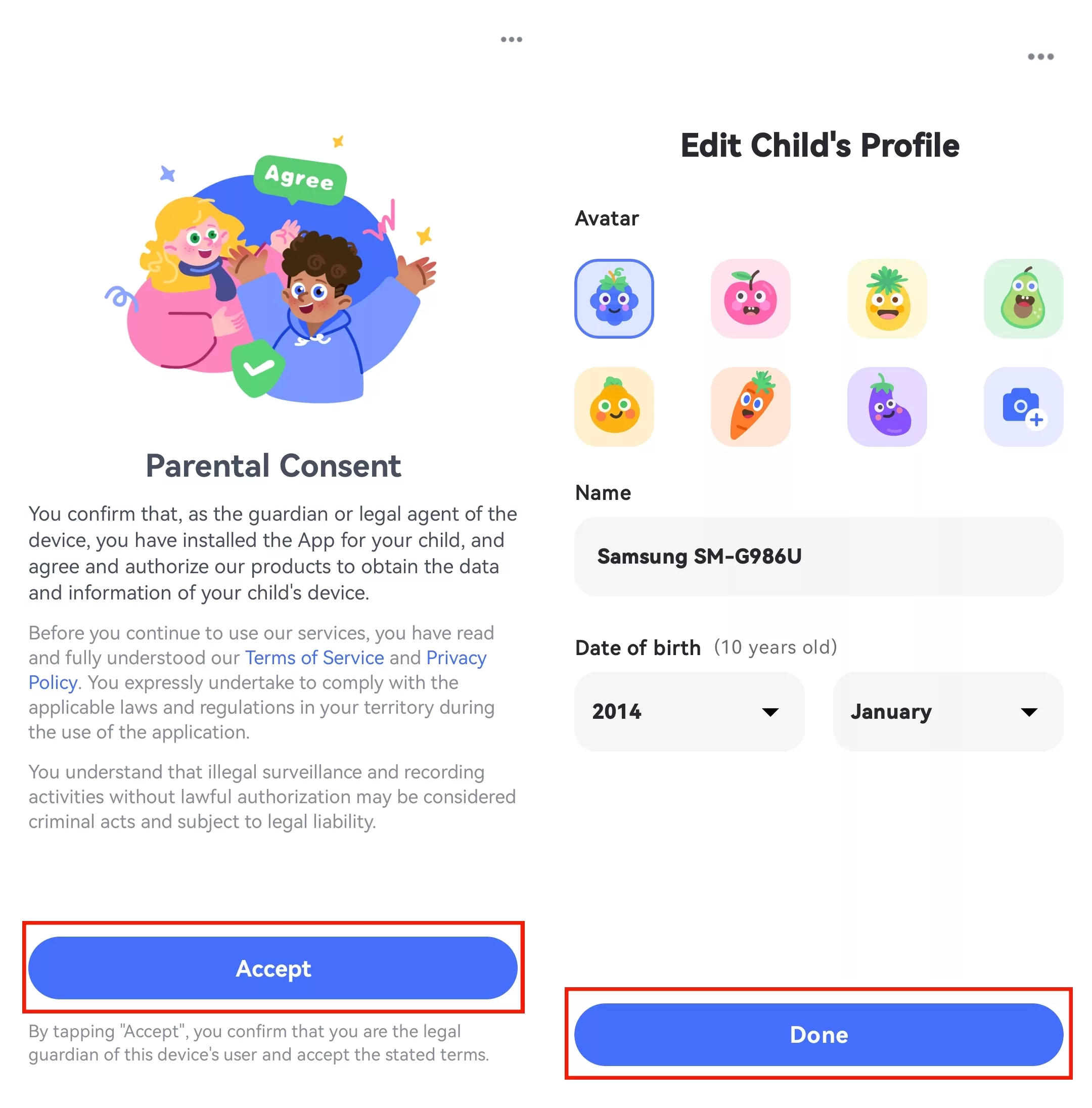
2. Please follow the on-screen instructions to grant the necessary permissions.
3. Now, your child's device is now successfully bound. You can choose to hide AirDroid Kids on the child's device by selecting "Hide Icon" below.
![]()
💡Cannot Find AirDroid Kids Icon?
If you can't find AirDroid Kids on the home page of your child's device, refer to the following steps to open it.
Method 1. You can enter *#*#247543#*#* on the dial pad of your child's device to open AirDroid Kids. Please note this method is only available on some devices.
Method 2. Enter the following URL in a browser on your child's device to open AirDroid Kids.
Part 3: Start Supervising
Manage Calls
Function
- Block or only allow certain calls on your kid's device.
- Monitor whether your child has made or received harmful calls.
Note: If you are an old user and want to use the new feature, please access your child's device to enable corresponding permissions. Here's how:
- In AirDroid Kids: Visit airdroid.com/openkids to open the app, tap Calls & SMS Monitoring to toggle on the switch with contacts and SMS.

- In the Settings App: Select Apps and tap on it, find AirDroid Kids, and enable the permissions for contacts and SMS.

How-to-Use
Once the permissions are ready, tap the "Calls & SMS Monitoring" option on the parental dashboard.
- Step 1.Select Mode for Calls Management
- Unrestricted Mode: No restrictions for the calls on your child's device.
- Blacklist Mode: Blocking the incoming and outgoing calls from the numbers on the blacklist.
- Whitelist Mode: Only allowing incoming and outgoing calls from emergency numbers and that on the whitelist.
By tapping "Mode" in "Call & SMS Monitoring," you can manage the call in three different modes.
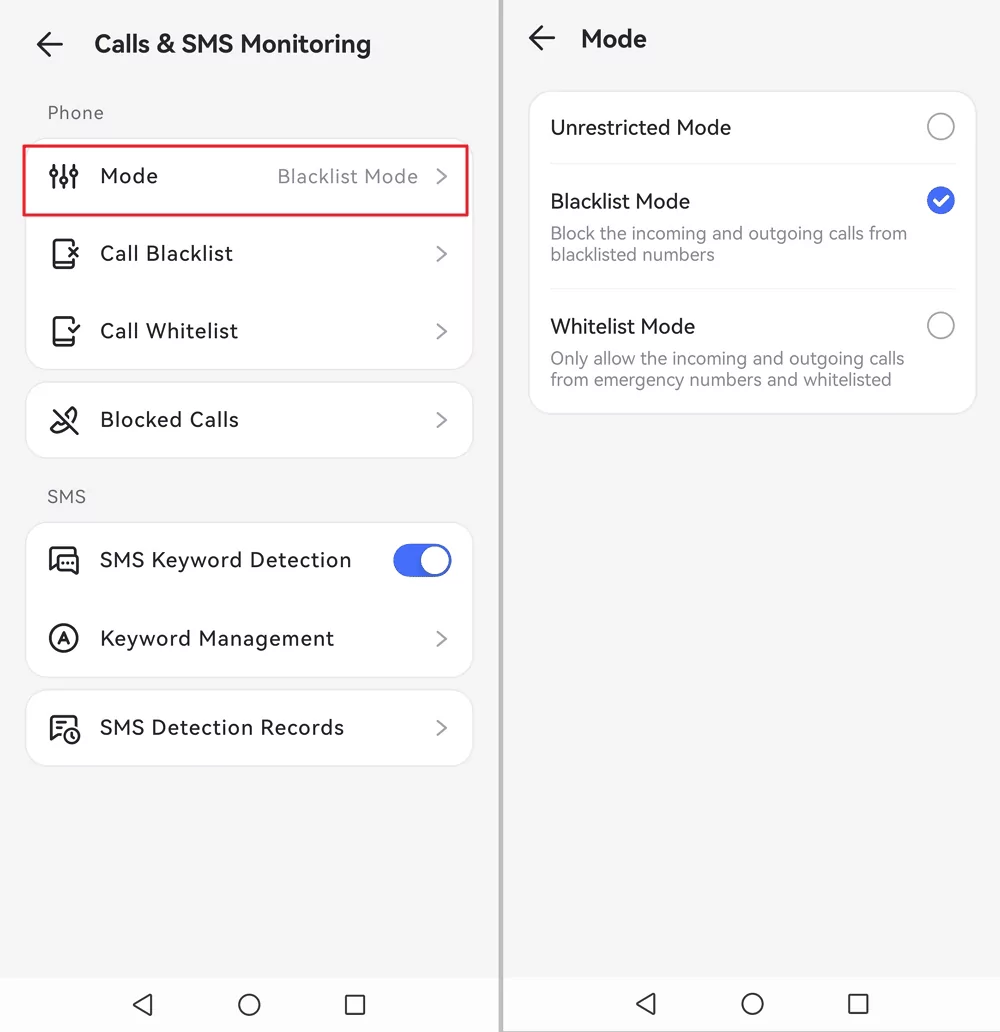
- Step 2.Add the Number to Blacklist and View the Blocked Records
Block Mode is the default mode. You need to tap "Call Blacklist"> "Add Phone Number," and then you can add the phone numbers you don't want your child to receive or call.
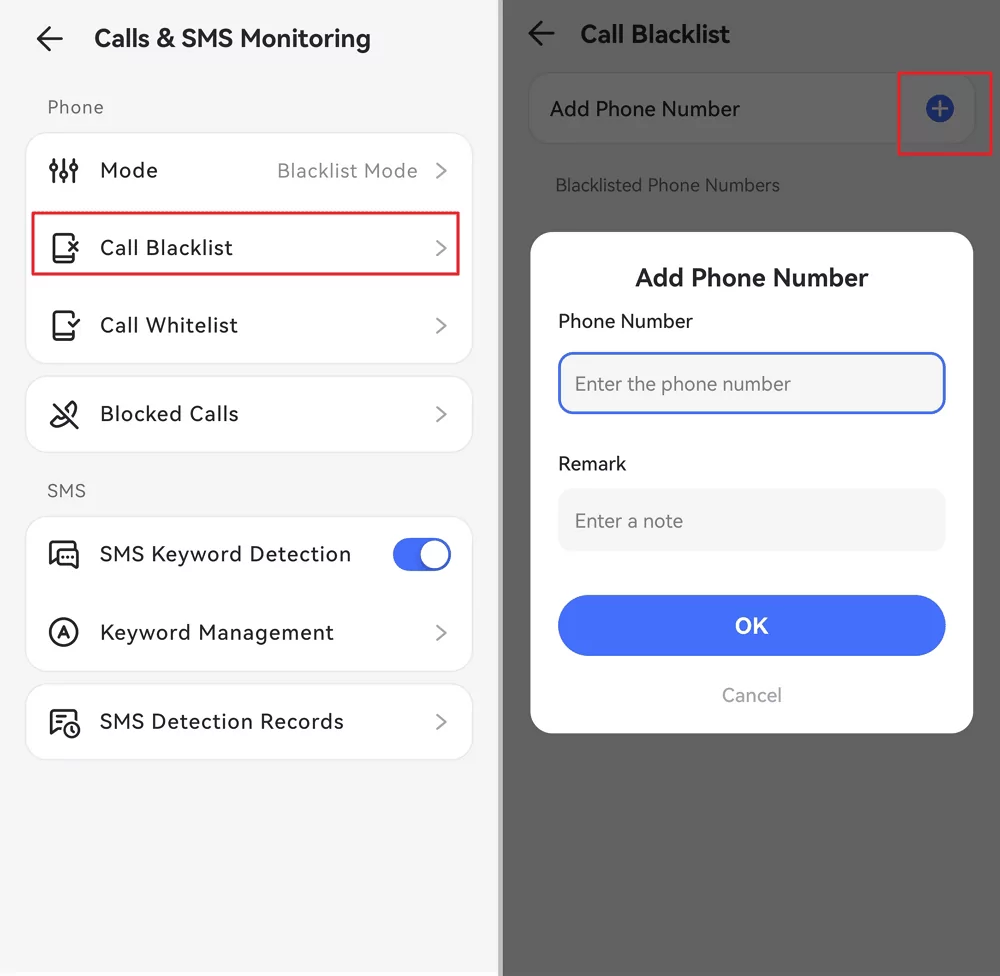
If the number contacts your child via phone call, it will be listed in the blocked records.

Tip: If you want to view all call history, go to the "Notifications" section and search for "Calls."
- Step 3.Add the Number to Whitelist
If you want to use Whitelist Mode, you can add phone numbers to the whitelist. Then, your children can only contact the numbers in the list via calls.
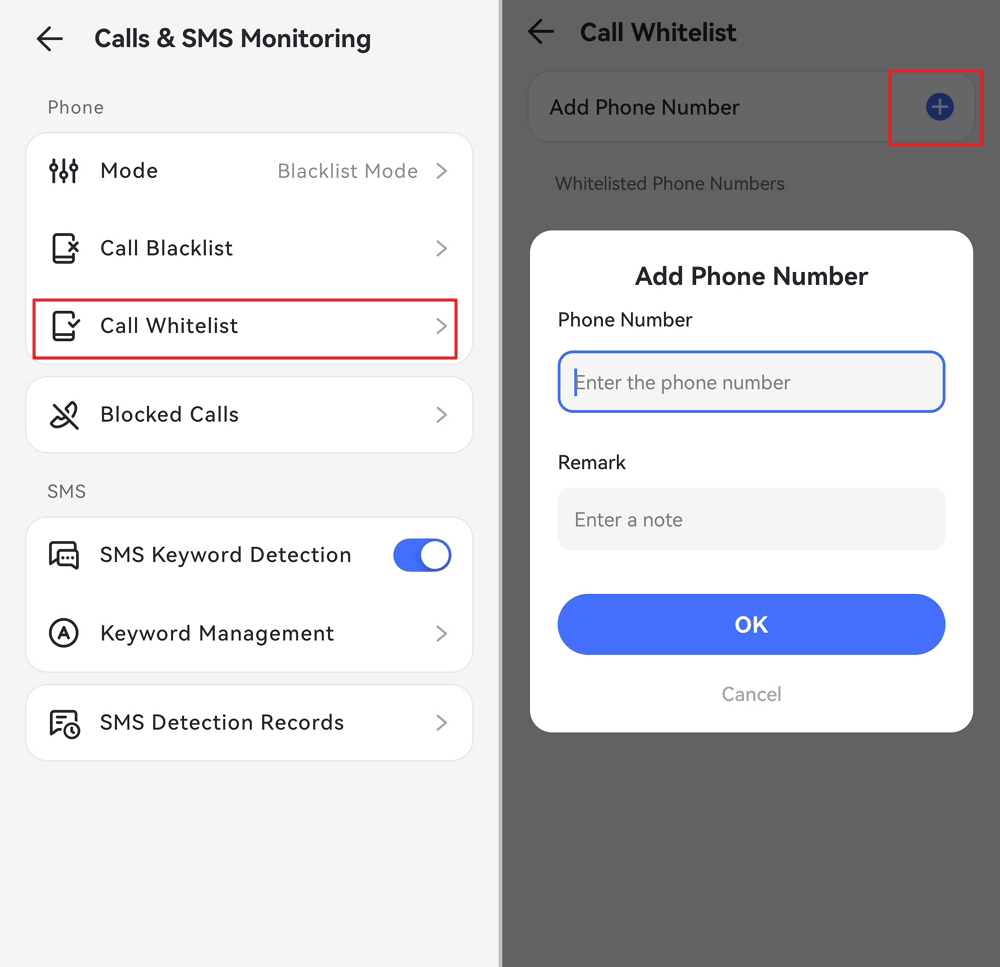
Monitor SMS
Function
- Detect whether your child receives harmful or inappropriate content in SMS and send alerts.
How-to-Use
- Step 1.Set Up Keyword Detection
Go to "Call & SMS Monitory" as before. In "Keyword Management," tap "Create keyword category." Enter the category name, add keywords you want the get alerts on your child's phone, and hit "OK" to save.
Tips: If you have added keywords in "Social Content Detection," the app will sync the keywords and vice versa.
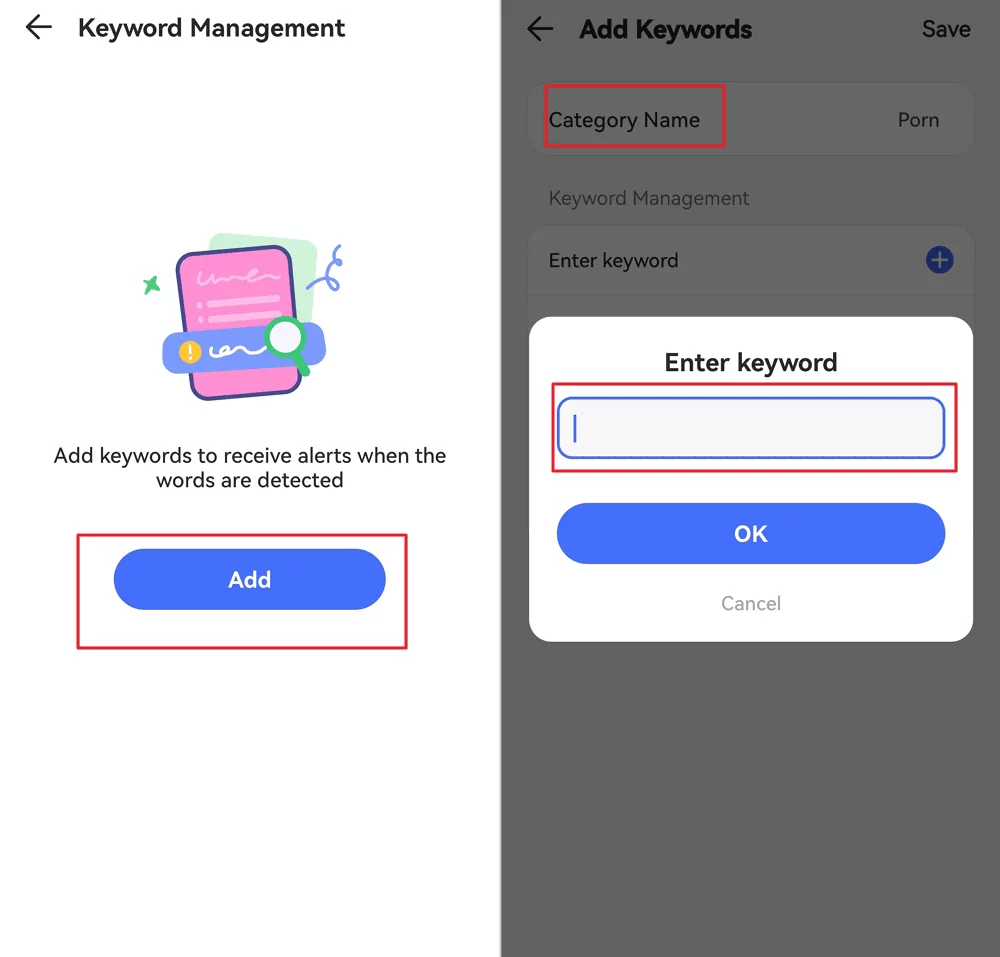
- Step 2.View SMS Detection Records
If your child sent or received text messages with the keywords, you will get alerts. You can tap the Message icon to view or see it in "SMS Detection Records" of "Calls & SMS Monitoring."
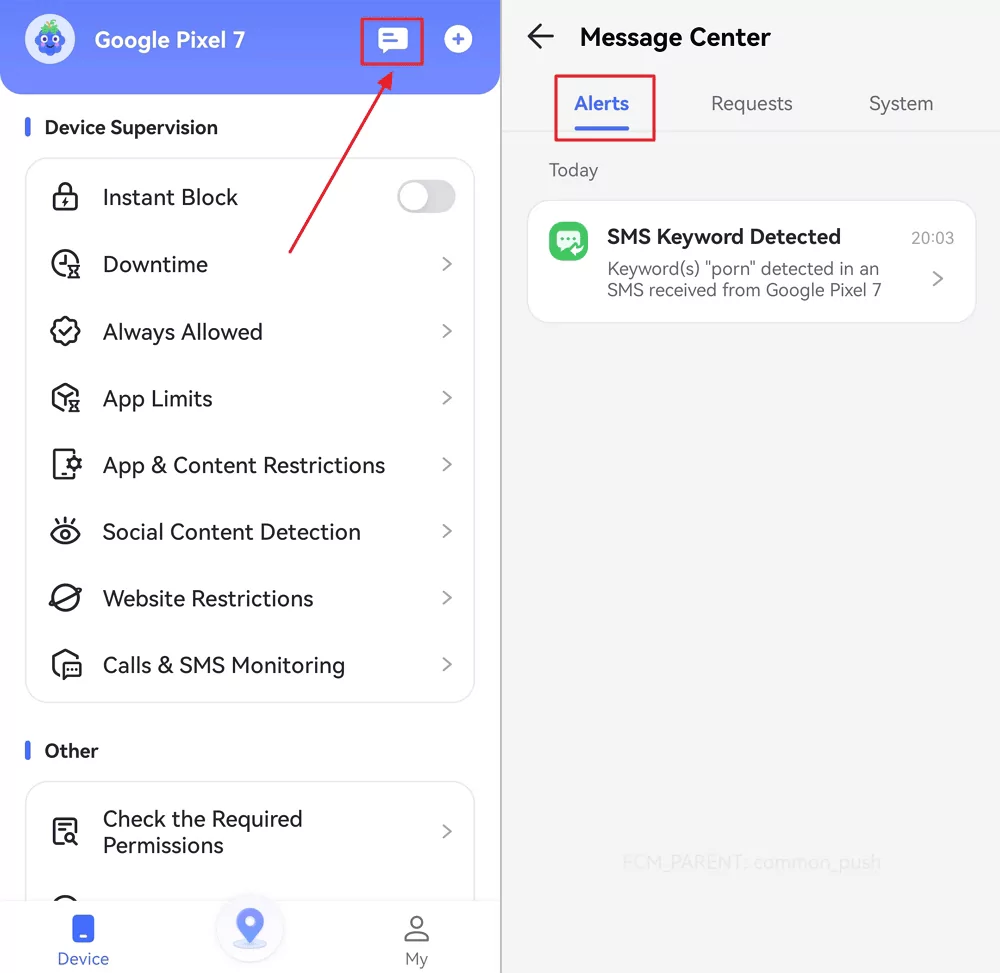

Tip: If you want to view all SMS your child received, go to the "Notifications" section and search for "Messages."
Sync App Notifications
Function
- Monitor your kid's incoming SMS and calls.
- Receive messages and notifications from your kid's social media, such as Snapchat, Discord, Instagram, etc.
- Get informed of positive or negative activities on your kid's Android phone.
How-to-Use
Tap on "Notifications" on the dashboard of AirDroid Parental Control on your phone.
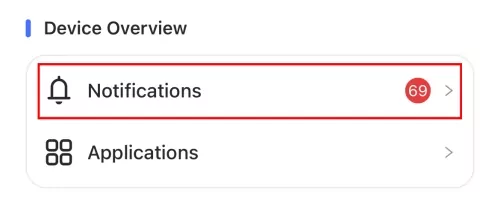
Then, you can see all notifications from your kid's phone. To locate notifications for a specific app, just type the app name in the search bar directly.
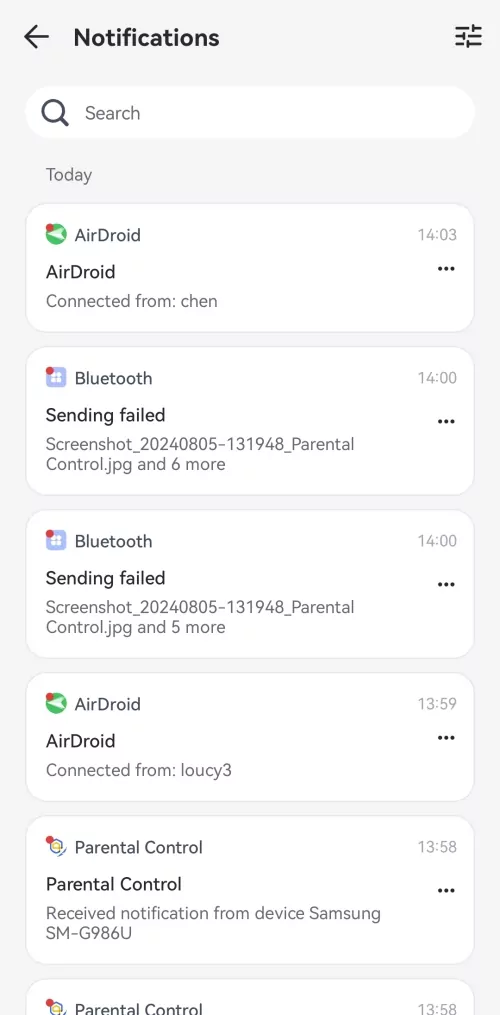
You are also allowed to customize which app you do or don't want to receive notifications for. Tap the "≡" icon at the upper right to access the "Notification Toggle" section. Then, turn the apps you want on or off.

Limit App Time
Function
- Set time limits or schedule downtime to restrict access to apps or categories within certain time frames.
How-to-Use
- Step 1.Scroll down the home page and select "App Limits." Then tap "Add Schedule."
- Step 2.Tick the apps or categories you want to limit, then tap "Next" in the upper right corner. You can also quickly find an app by searching its name.
- Step 3.Select "Time Limits" to set how long your child can use the app.
- Step 4.Select "Downtime" to set when you child can't access the app or category.
- Step 5.Tap "Done" in the upper right corner.
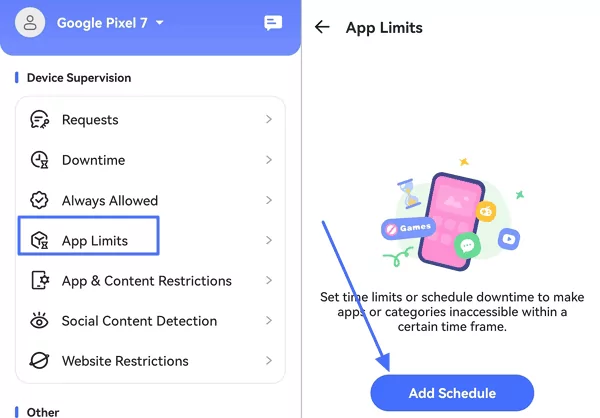
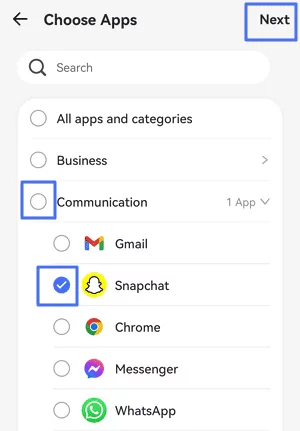
Set the same limits for every day by ticking "Every Day" > setting time limits > tapping "OK."
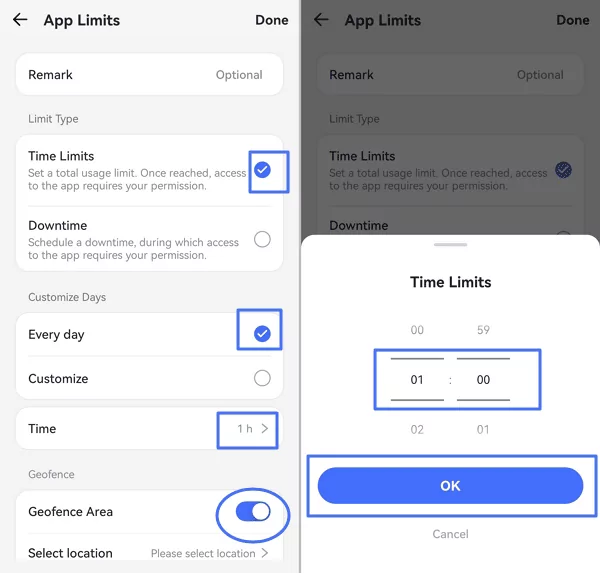
Set different limits by ticking "Customize" > selecting days from Sun to Sat > setting time limits > tapping "OK."
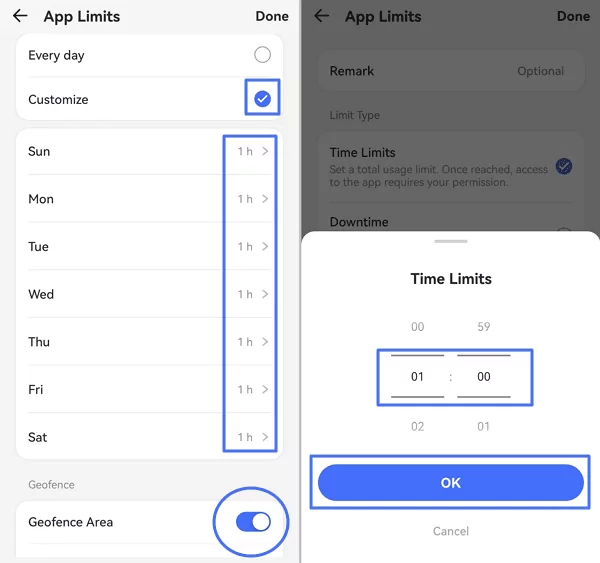
Set the same downtime for every day by ticking "Every Day" > setting downtime > tapping "OK."
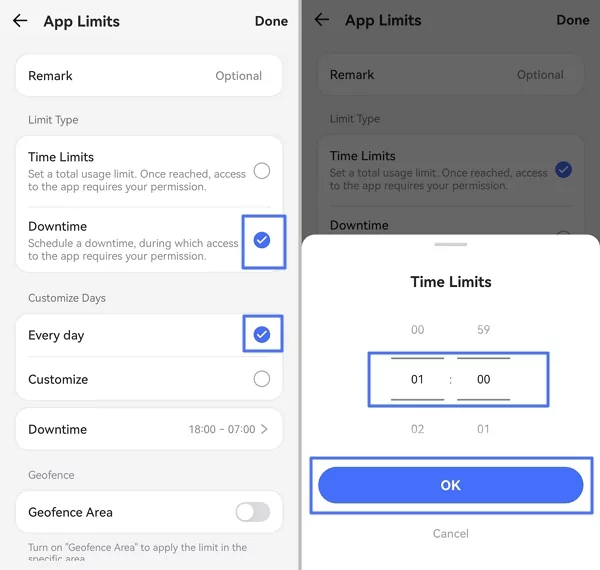
Set different downtime by ticking "Customize" > selecting from Sun to Sat > setting downtime > tapping "OK."
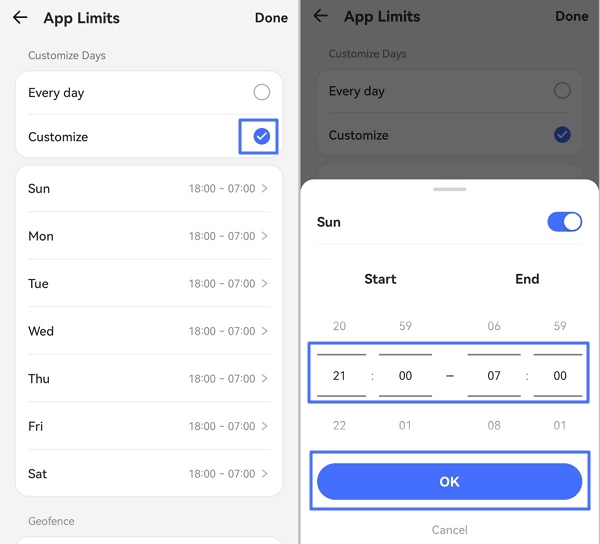
Block App
Function
- Know all apps installed on your kid's phone.
- View what app your kid has added recently.
- See whether the apps are safe for kids.
- Block the apps that you don't want your kids to access.
How-to-Use
- Step 1.Click on "App & Content Restrictions," and you'll have two options.
- Step 2.In the "Open Newly Installed Apps" section, you can choose whether your child can open newly installed apps or not.
- Step 3.In the "App Blocker" option, you can block all apps or individual apps with one-tap. If you choose to block all apps, all apps except those "Always Allowed" will be instantly blocked until you disable this feature.
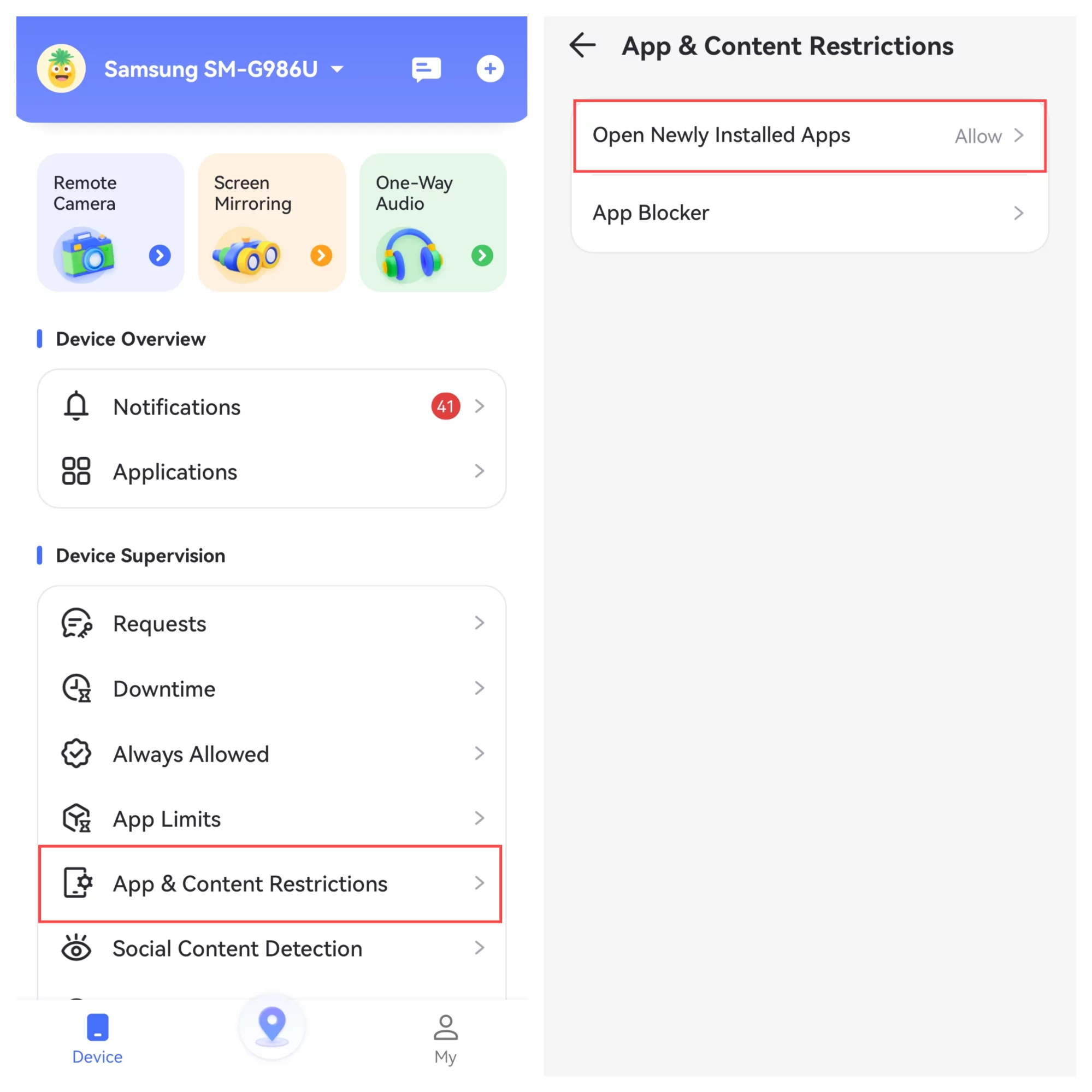
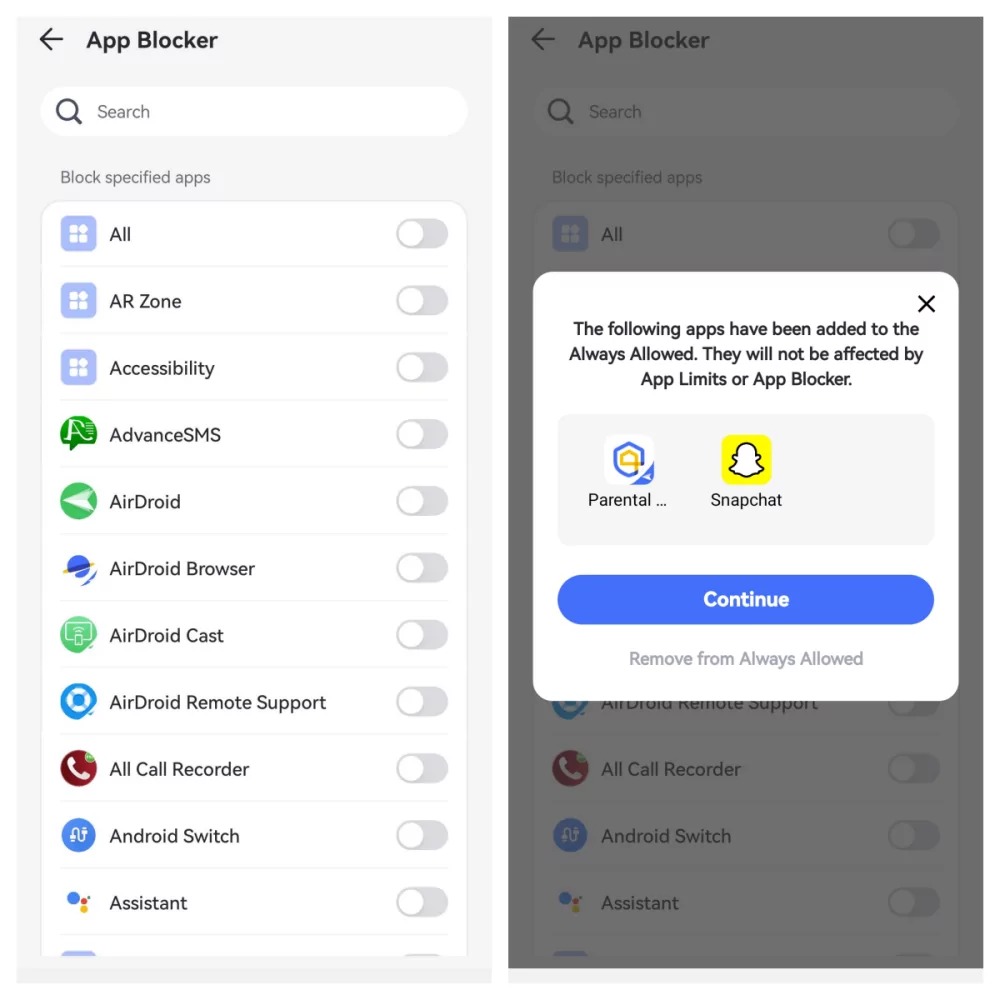
Limit Screen Time
Function
- Schedule downtime to decide when your child's device is not available.
How-to-Use
- Step 1.Scroll down the home page and select "Downtime." Then tap "Add Schedule."
- Step 2.Set the same downtime for every day or customize different downtime for each day. You can even set downtime to activate in specific areas.
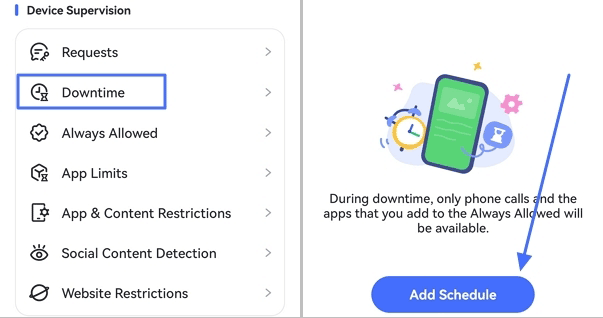
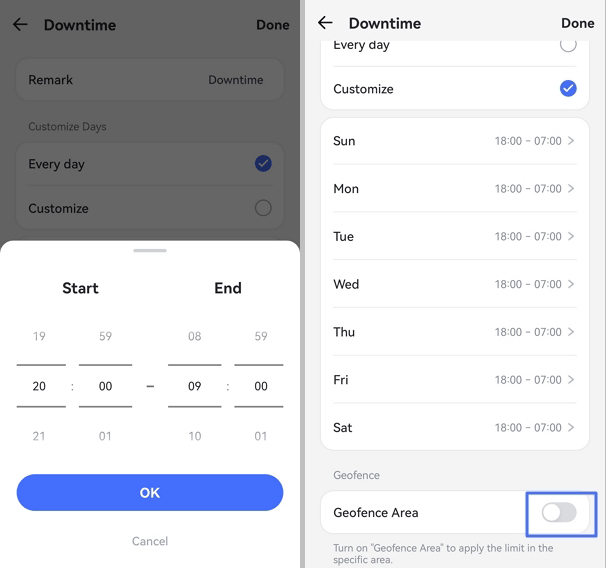
💡During downtime, phone calls and apps added to "Always Allowed" will be accessible. So, you can add apps and websites to the "Always Allowed" list to let your kid can always access them. Here's how:
- 1.Select "Always Allowed" under "Device Supervision" on the home page.
- 2.Tap to open it. You'll see all the apps on your child's device. Search for the app you want to add or scroll down to find it, then tap the "+" on the left of the app to add it to the allowlist.
- 3.Switch to "Websites" by tapping it. Then tap the "+" next to "Add URLs to the Whitelist" to enter the websites you will always allow your children to access.
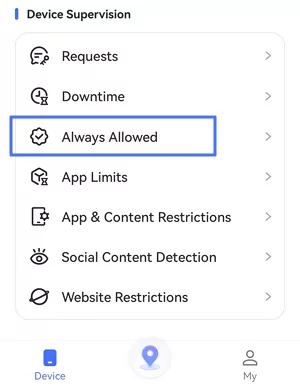

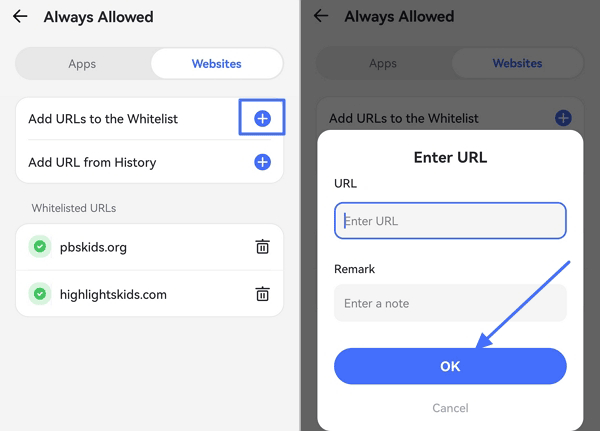
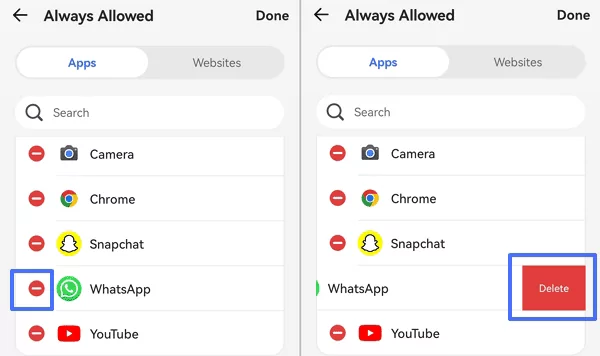
Restrict Device Access
Function
- Instantly block all apps except those always allowed until the set time ends or you disable this feature.
How-to-Use
- Step 1.Under "Device Supervision," locate and tap "Instant Block."
- Step 2.Choose to block all apps (except always allowed apps) for 1 hour, 2 hours, until midnight, or until manually turned off. Then, tap "OK."
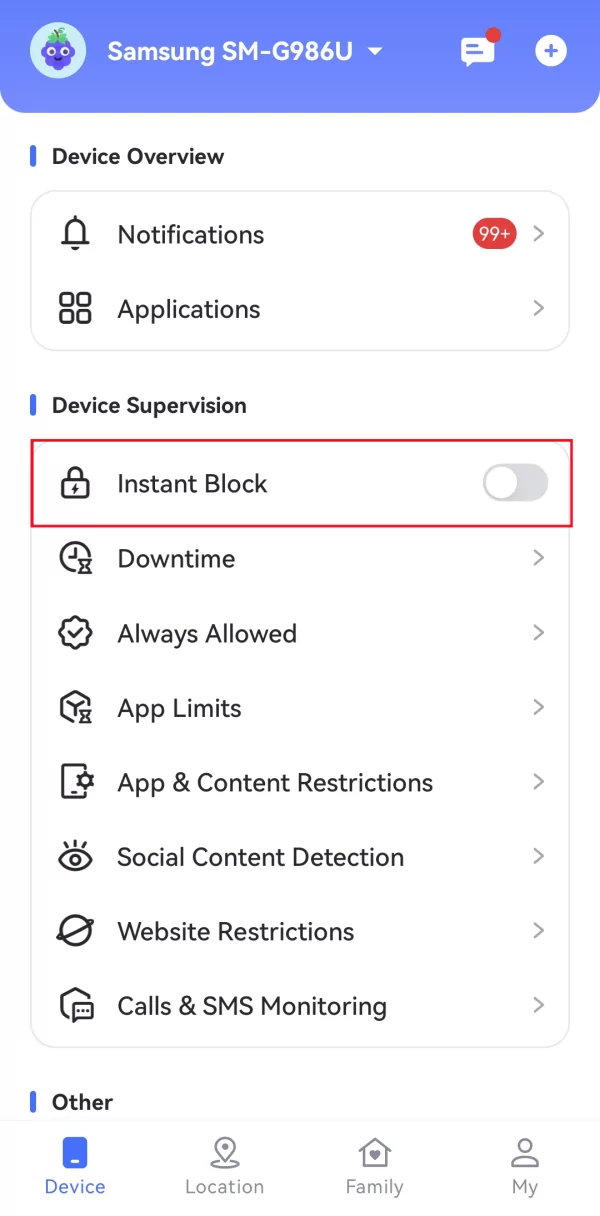
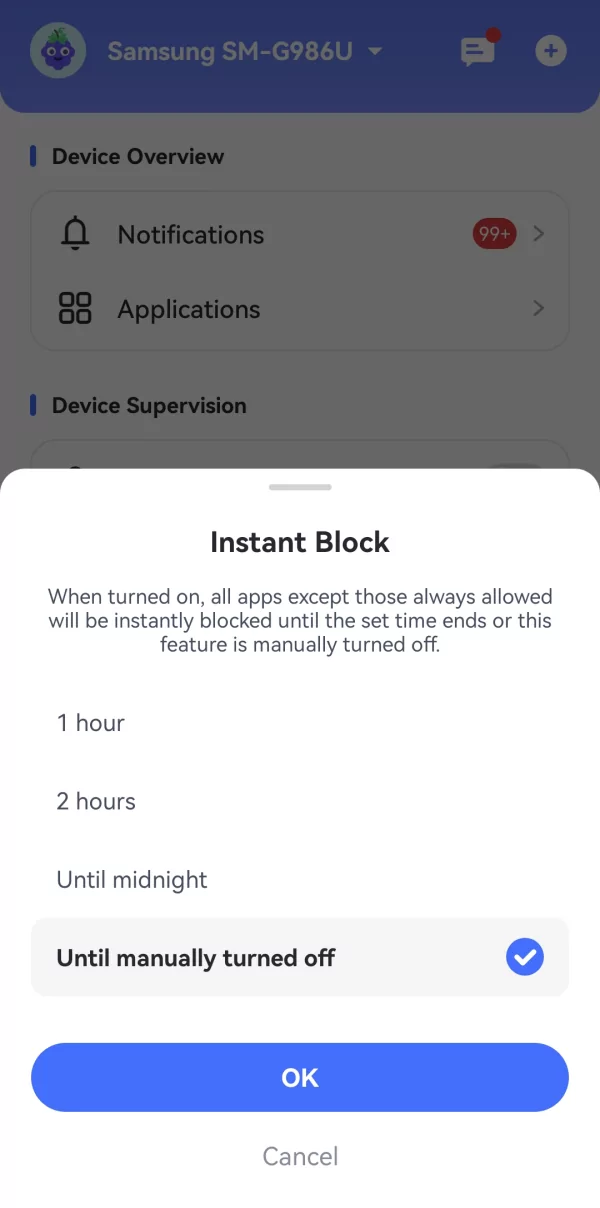
Filter Web Content
Function
- Allow or block any websites on kid's devices.
- Change web filtering levels flexibly.
- Filter websites one by one or by categories.
To activate this feature on your Android, you have to install AirDroid Browser on your kid's device first.
How-to-Use
- Step 1.Download AirDroid Browser on Kid's End
- Install AirDroid Browser on your child's Android phone. Launch it and click "Open AirDroid Kids" for binding.
- Check the account you want to bind. If yes, tap "OK".
- Set AirDroid Browser as the default browser to create a healthier internet environment.
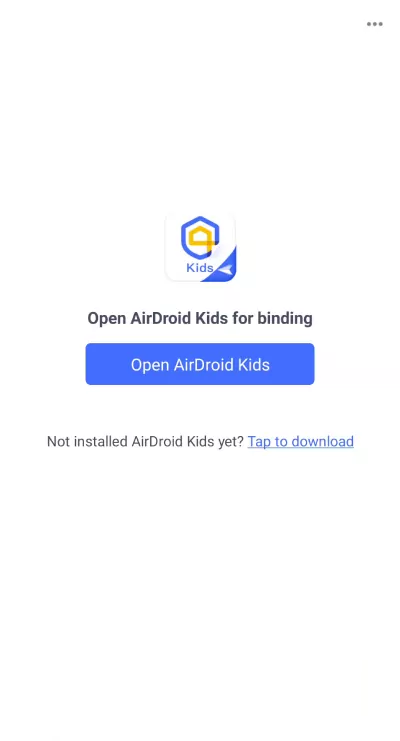 | 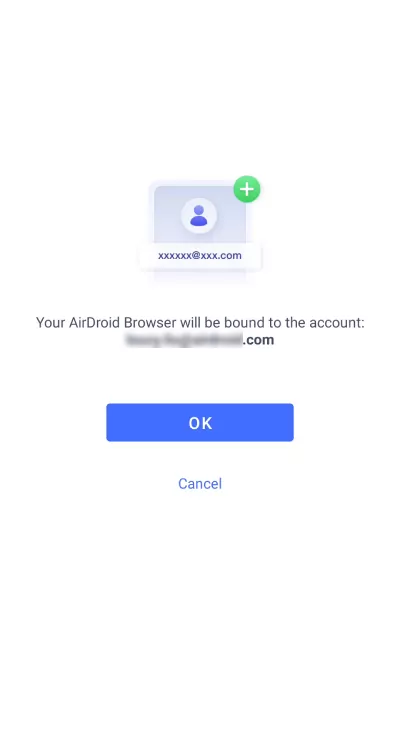 |
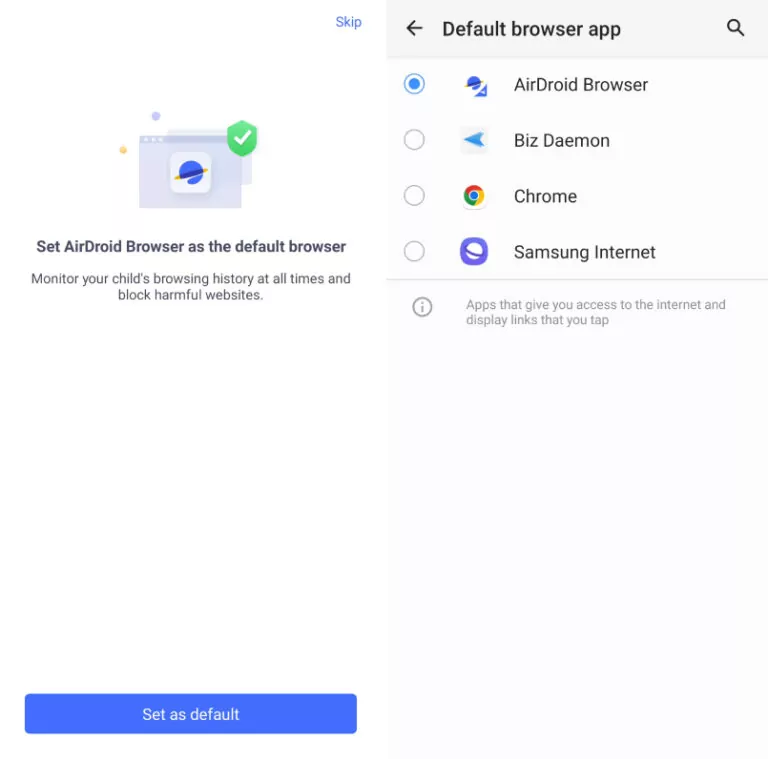
- Step 2. Choose Website Restriction Mode
- Unrestricted Mode: No restrictions for the websites your child can visit.
- Block Mode: Blocking the sites you added or the website types you choose to block.
- Whitelist Mode: Where your child can only access the sites you add.
In AirDroid Parental Control, go to "Website Restrictions" from the home page.
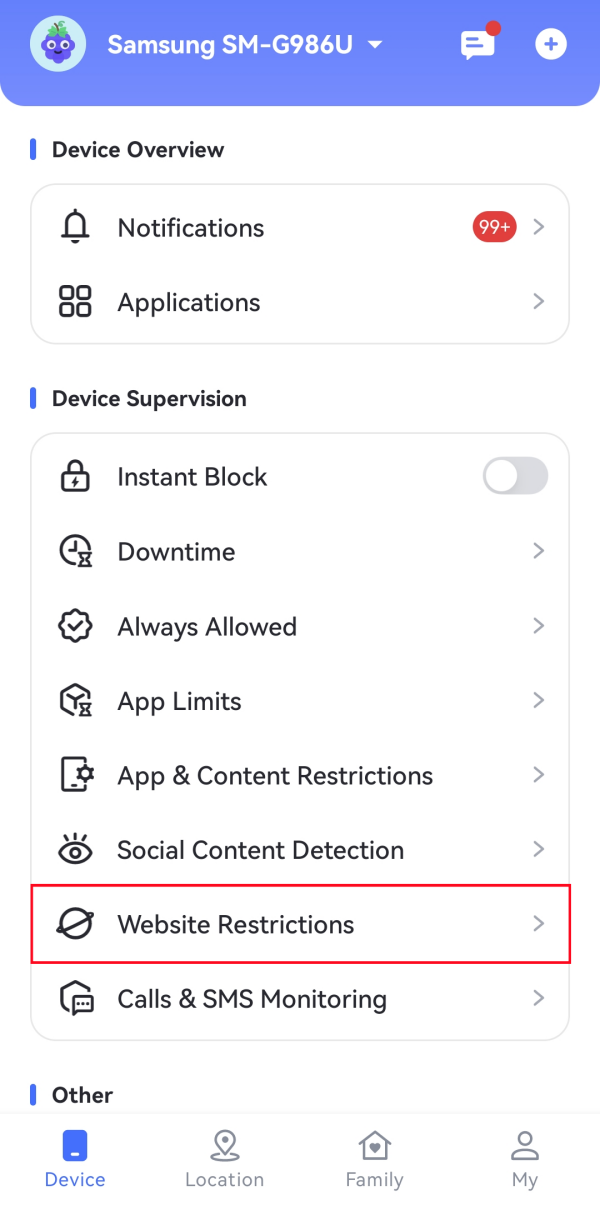
Then, tap "Mode" and you can manage your child's web activities in these 3 different modes:
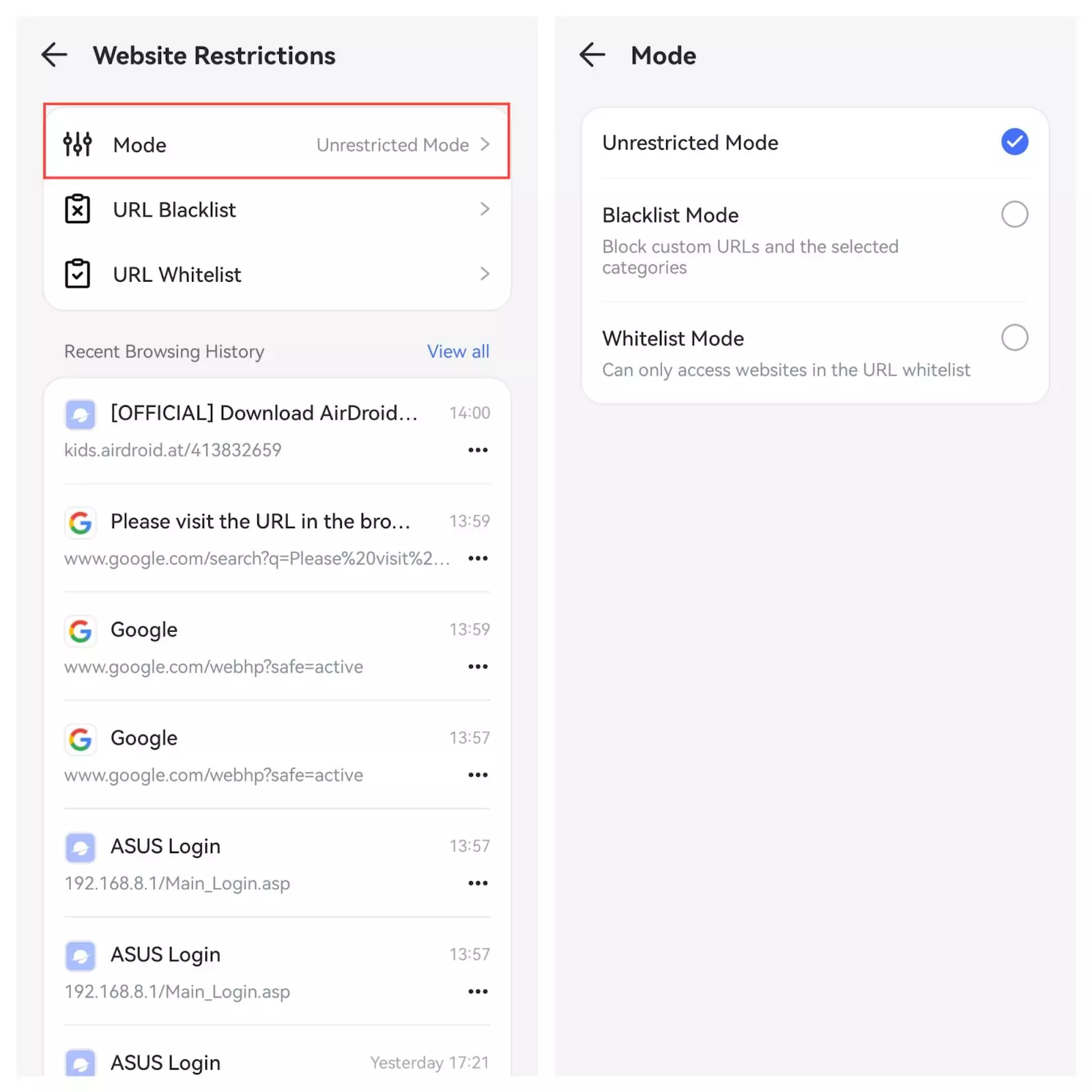
- Step 3. Set Website Blacklist for Your Kid
- In "URL Blacklist", tap "Add custom URLs to the Blacklist." Then, input the web address you don't want your child to visit.
- Surely, you can also add the blacklist URL from your child's browsing history.
- Or switch to the "Subscription" tab to block the website by categories for your kids. This includes common categories that aren't suitable for kids, such as adults, drugs, violence, gambling, and more.
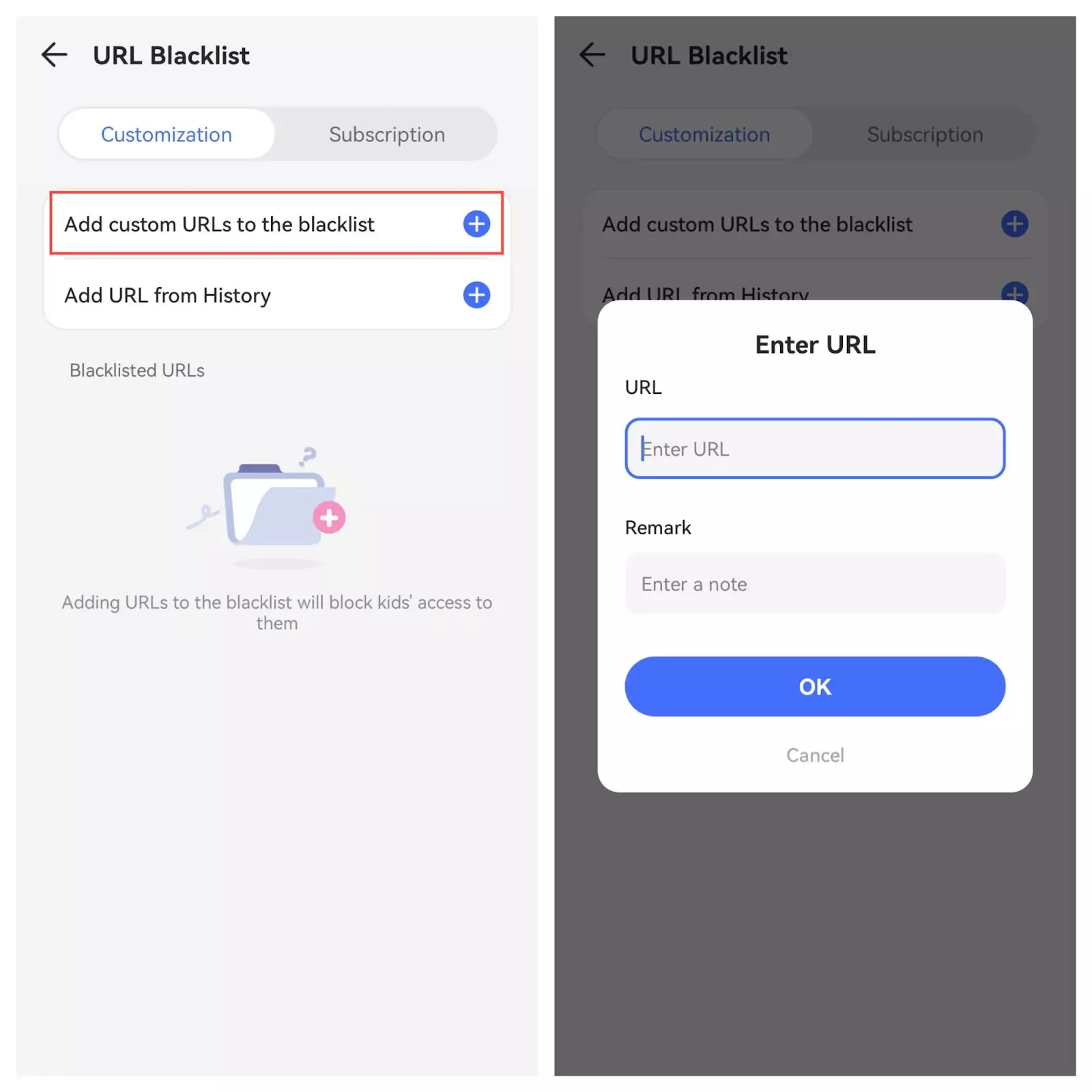
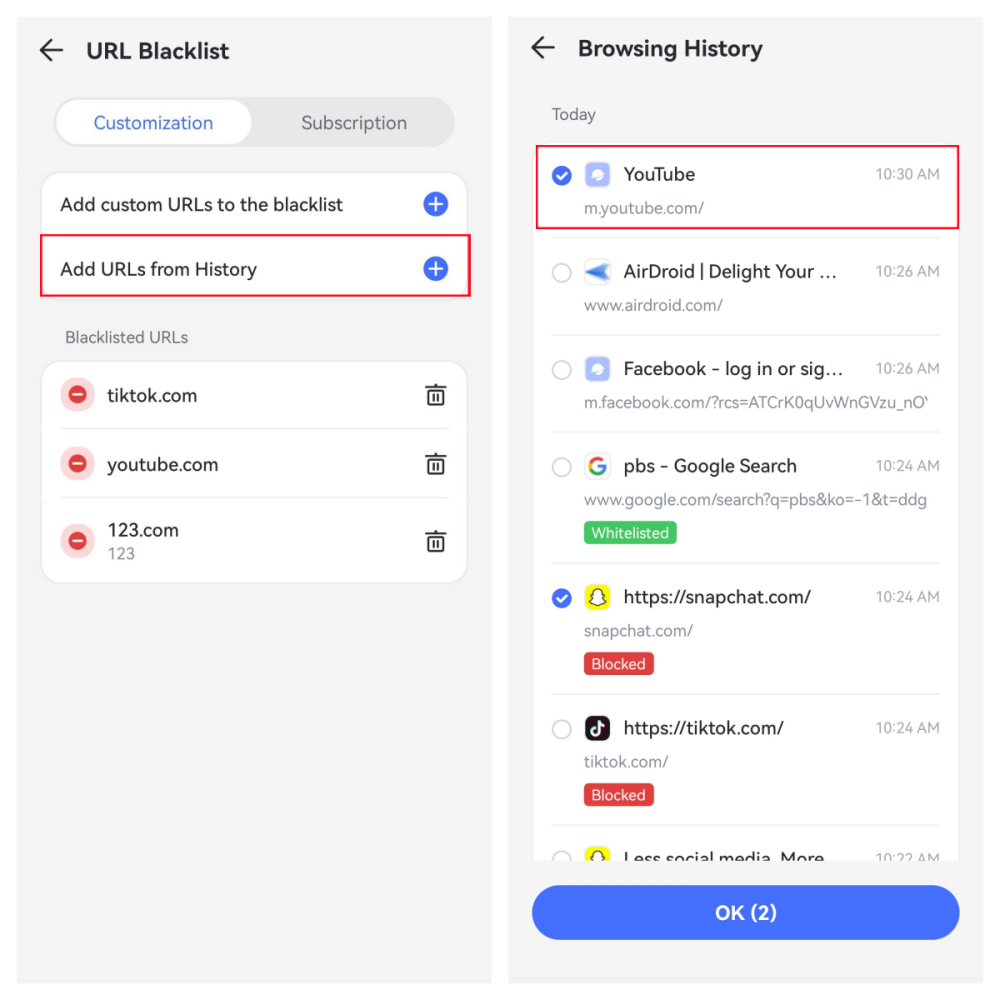
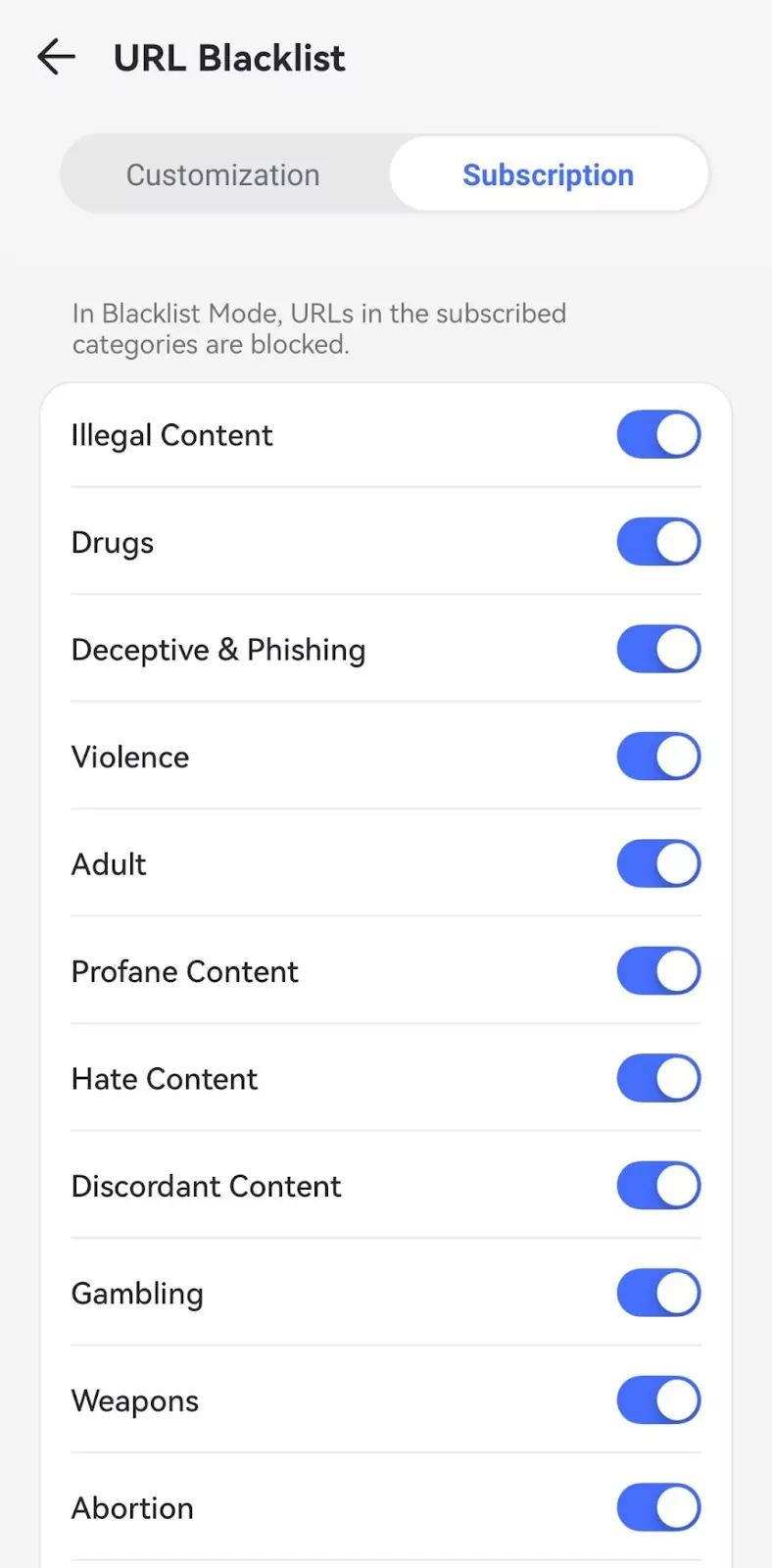
- Step 4. Set Website Whitelist for Your Kid
- In "URL Whitelist", tap "Add URLs to the Whitelist" to specify sites your child can visit or add allowed websites from their browsing history.
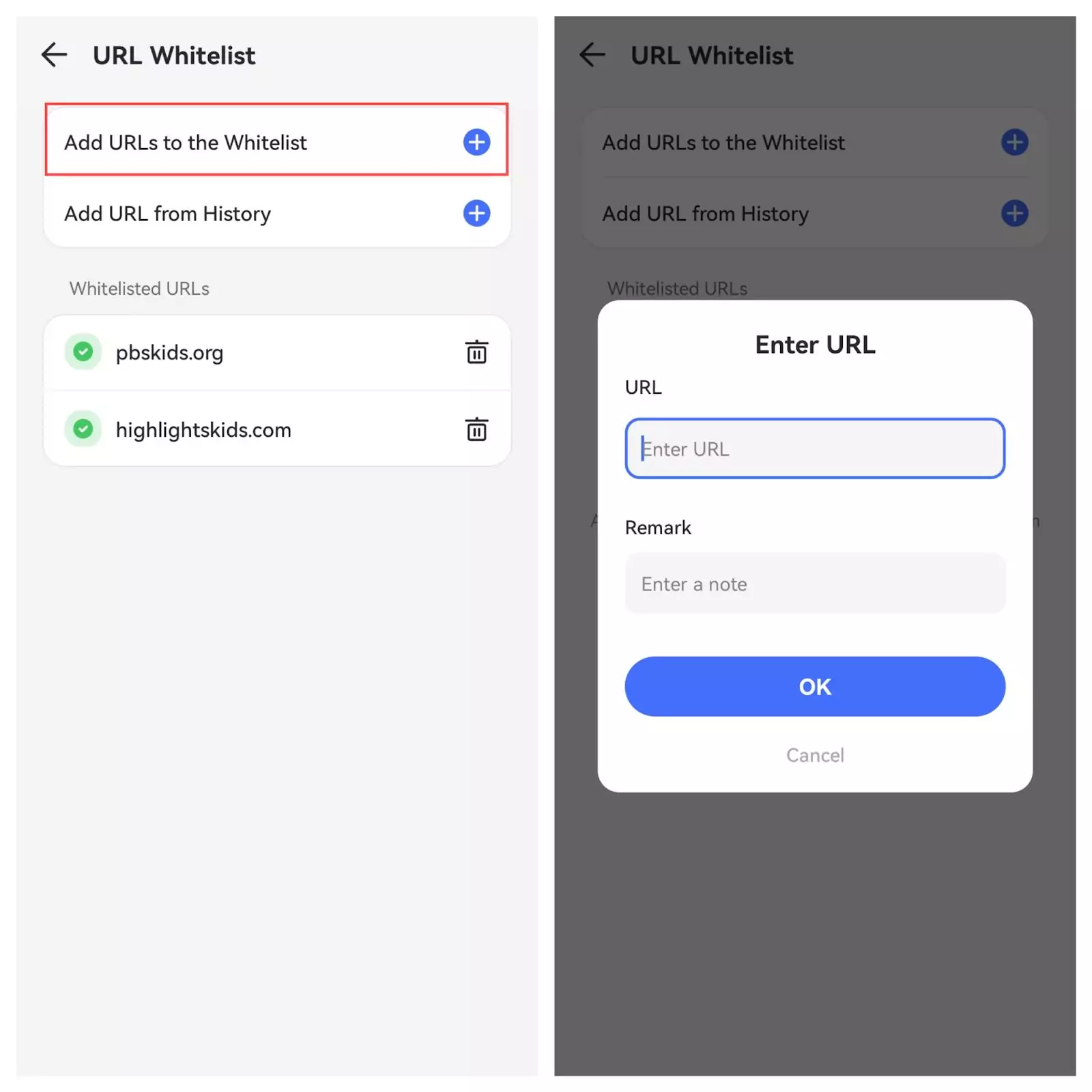
Track Browsing History
Function
- Keep a record of your child's browsing and searching history.
- Find out if your child visited blocked websites and get instant alerts.
How-to-Use
- Step 1.Go to "Website Restrictions" from the home page.
- Step 2.Click "View All" to see all entries. AirDroid also enables you to visit the website or add it to the blacklist directly by tapping the three-dot button next to the link.

You can also click "Blocked" to see the websites your child has been prevented from accessing when the "Blacklist Mode" or "Whitelist Mode" is activated.

Detect Social Content
Function
- Monitor content on the child's social media apps through keyword detection.
- Receive instant alerts when keywords are detected, activating the content filter.
- View details of detected keywords.
- View the activities about TikTok and YouTube for 30 days.
How-to-Use
- Step 1.Tap on "Social Content Detection" in AirDroid Parental Control.
- Step 2.Click on "App Detection Management" and turn on the button of the app you want to monitor. Once this is done, the content monitoring will begin, and the app will send alerts whenever keywords you've added are detected.
- Step 3.Tap the "Activity" option to view TikTok and YouTube activities for the past 30 days.
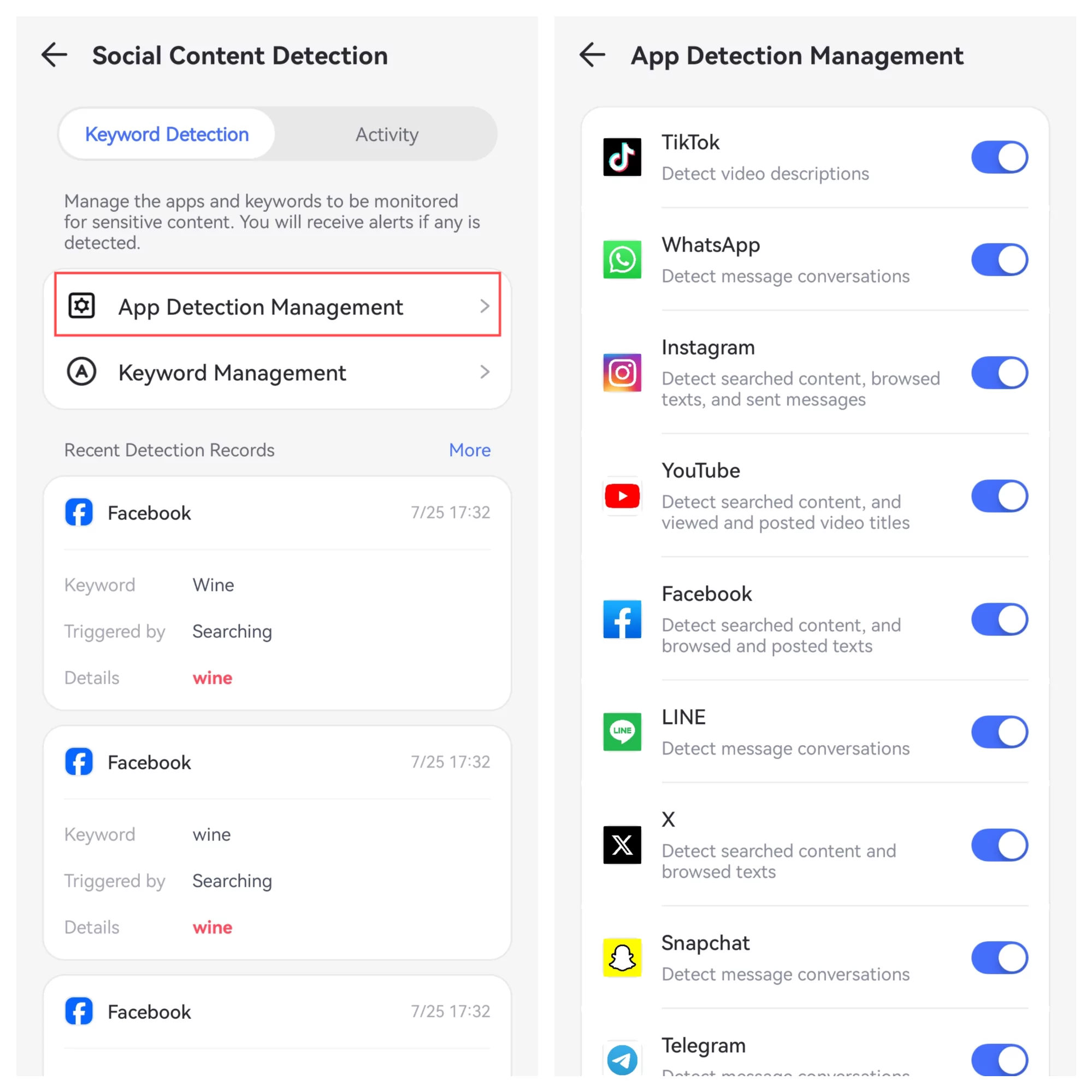
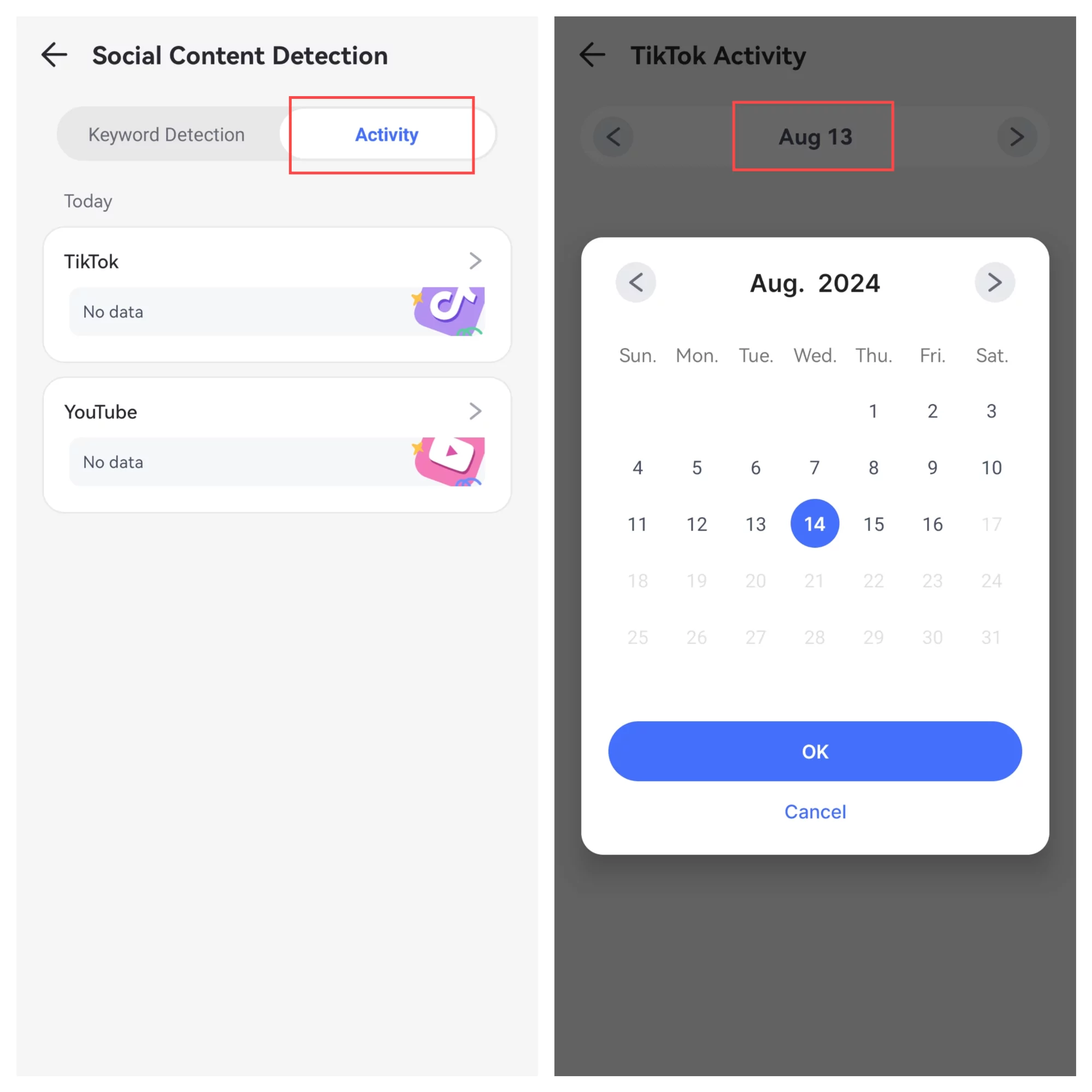
To set up keywords for content detecting and filtering, please follow:
- Step 1.Navigate to "Social Content Detection" and tap "Keyword Management".
- Step 2.Press "Create keyword category" enter the category name, add keywords you want the content filter to detect on your child's phone, and hit "Save".
- Step 3.Enable the categories that contain the keywords for the content filter.

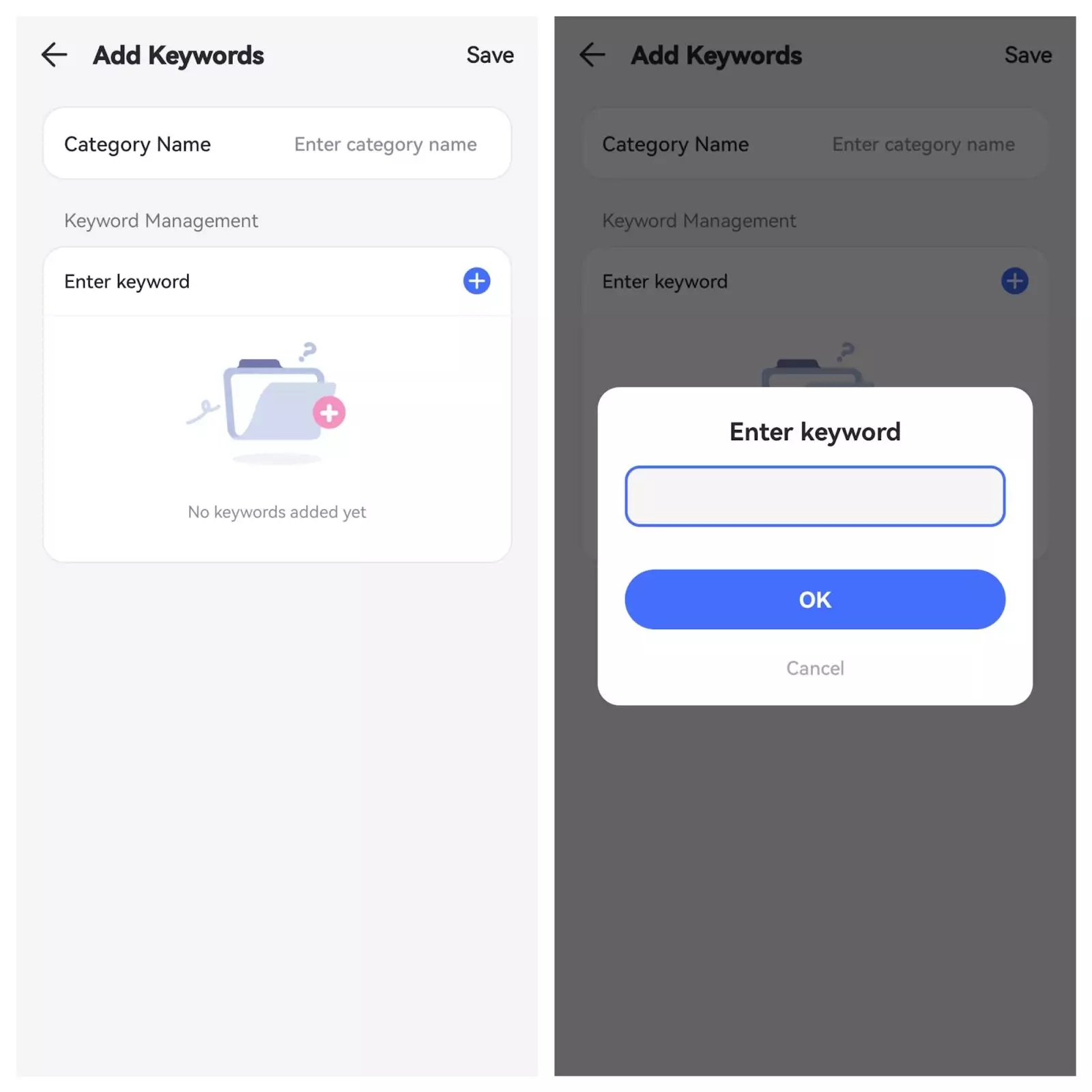
Part 4: Monitor Remotely
Remote Camera
Function
- Remotely open the kid's phone camera and switch between front and rear cameras.
- See the surroundings around kids with the cameras of your kids' mobile devices.
- Open the flashlight on kids' phones to get a brighter field of view.
- Enable the one-way audio to listen to the kid's phone surroundings.
How-to-Use
Click "Remote Camera" in the "Remote operations" section, and you can view the surroundings of your kid's phone.
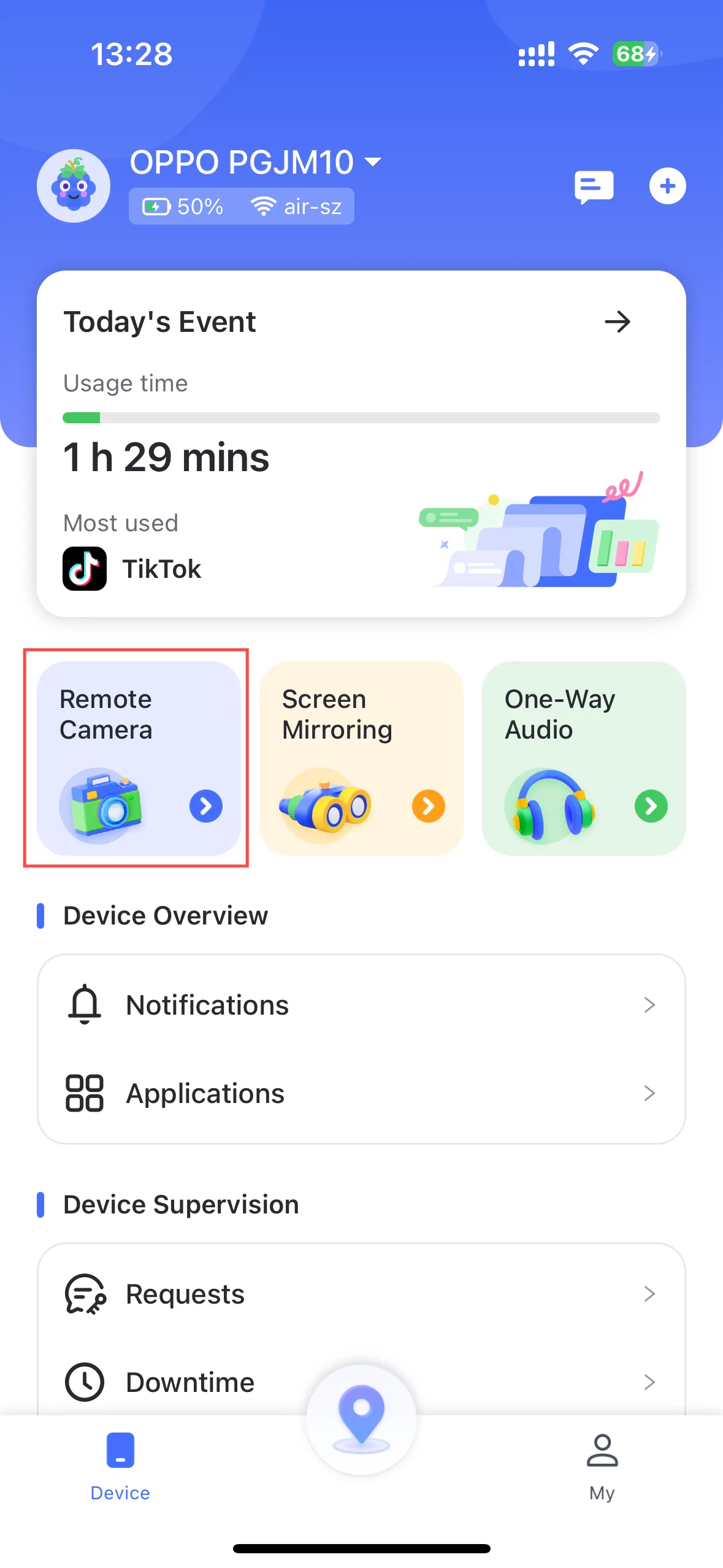
You can also rotate the screen, switch the webcam, full screen, remotely open the flashlight, and enable a one-way audio function.
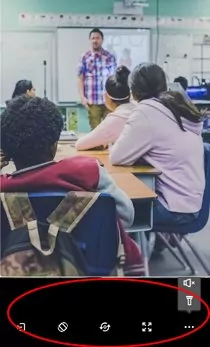
One-Way Audio
Function
- Listen to the ambient environment through the microphones of your kids' phones.
How-to-Use
Click the "One-Way Audio" button to listen to the kid's phone surroundings.
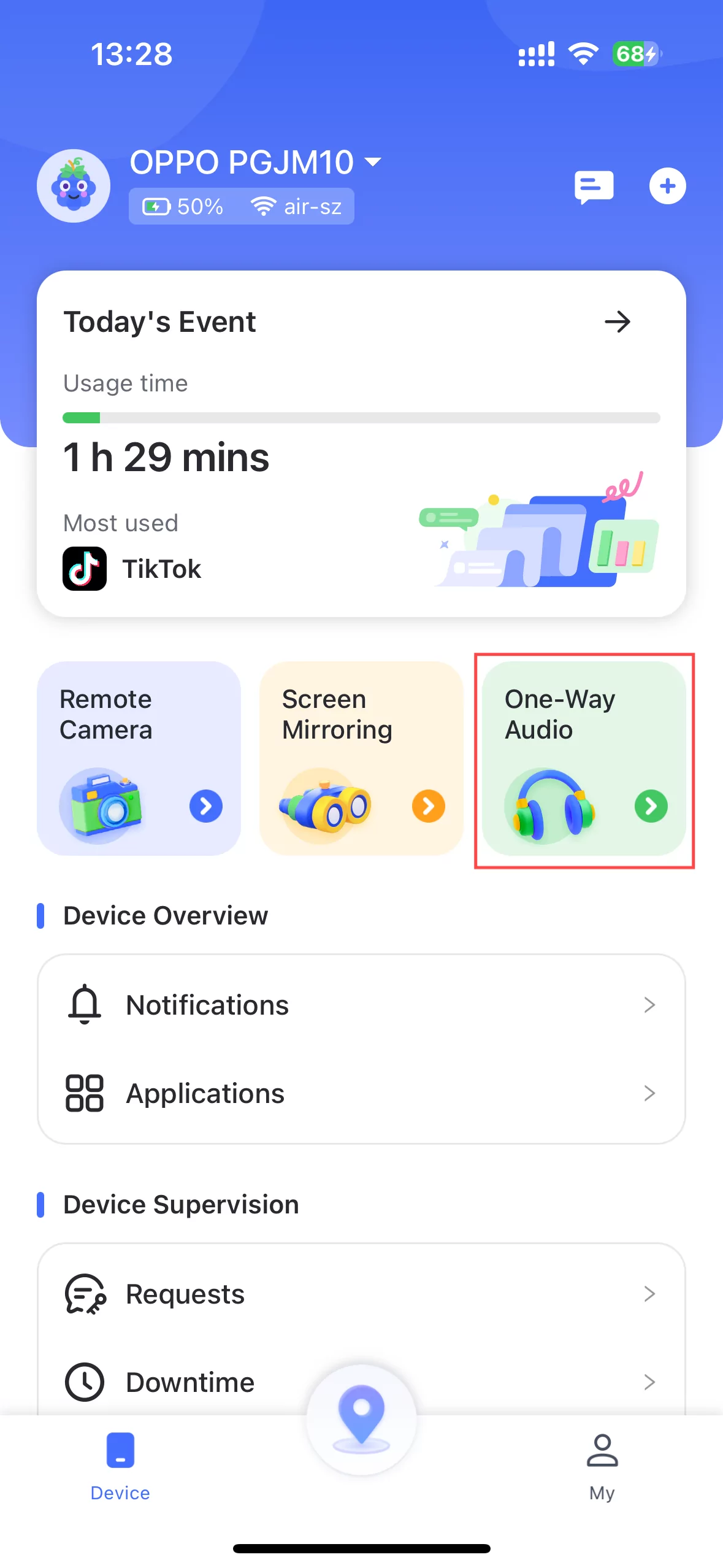
You can also make an audio recording if necessary.
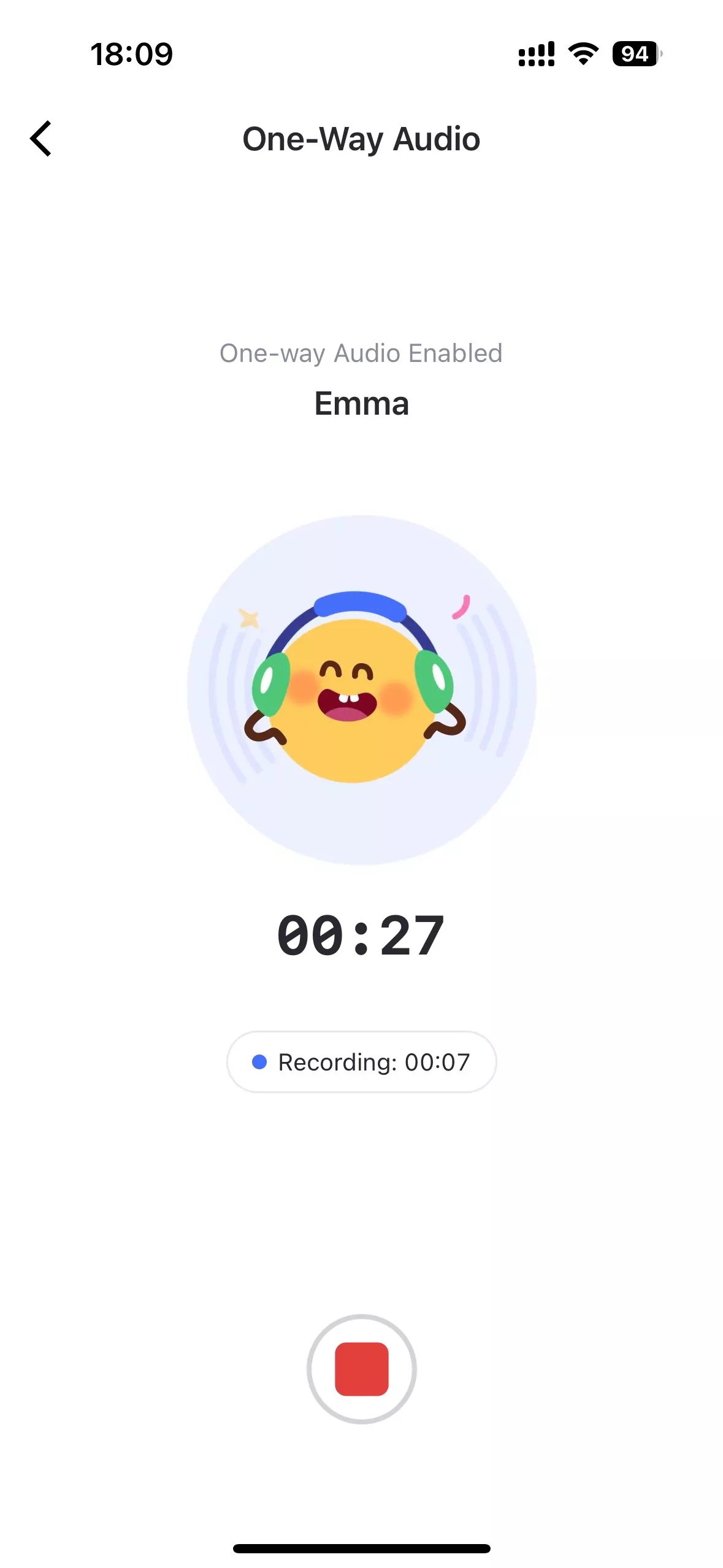
Screen Mirroring
Function
- Remotely monitor your kids' live screen.
- Ensure your child's digital activities are risk-free.
How-to-Use
Click "Screen Mirroring" in "Remote operations," and then you can mirror the kid's phone screen to your device.

You can also rotate the screen, turn on the one-way sound, and go full screen.
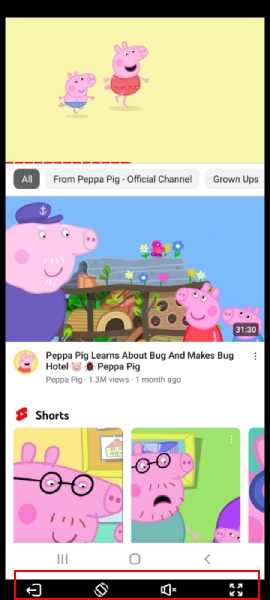
Part 5: Track Location
Live Location
Function
- Check the current location of your kid's device.
How-to-Use
- Step 1.Click the "Location" button at the bottom of the dashboard.
- Step 2.You will see the location of your child's device. To refresh the location, tap the Refresh icon in the bottom right corner.
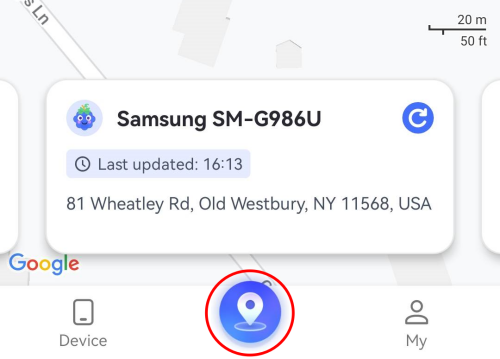
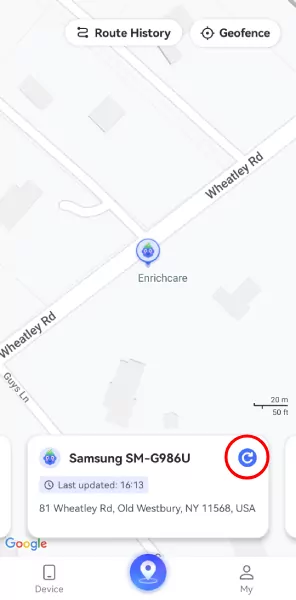
Route History
Function
- Check where your kids have been.
- View location history of the past 30 days.
How-to-Use
- Step 1.On the location section, tap "Route History" at the top.
- Step 2.You can check the location history in timeline form.


Step 3.Tap the calendar icon to view the location history for the past 30 days. You can also click "<" or ">" to see the previous or next day.
![]()
Geofencing
Function
- Set up a specific area to get notified when kids enter or leave the area.
How-to-Use
- Step 1.On the Location section, tap the "Geofence" button.
- Step 2.Tap "Add geofence."
- Step 3.Enter the geofence name, select the location, and set the radius. When you're done, tap "Save."
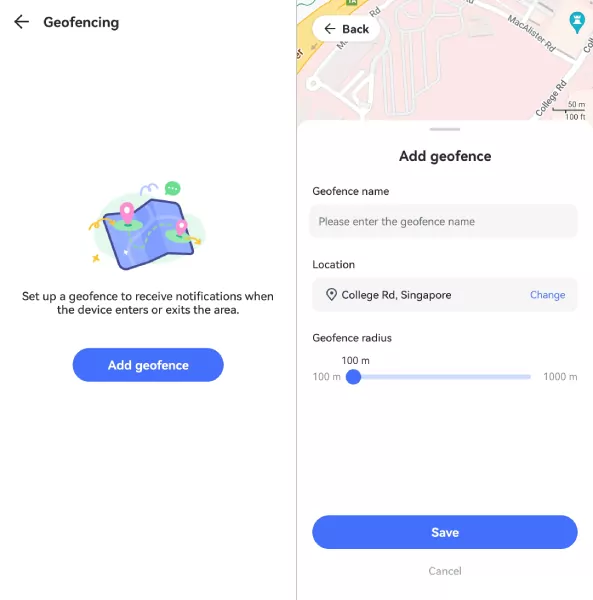
Part 6: Check Reports & Alerts
Activity Report
Function
- Check the daily and weekly phone usage details in a timeline format.
- Check information about the most used apps. You can also learn how long they were used and when they were used.
- See how many notifications each app has received.
- Learn which app has used the most data and how much it has used.
- Free to check the activity report of any date within 30 days.
How-to-Use
- Step 1.Tap "Today's Event" at the top of the dashboard.
- Step 2.Choose whether you want to see a "Daily" or a "Weekly" report. The "Daily" report is the default. You can also swipe the chart left and right to check the activity report from the previous day or the next day.
- Step 3.Scroll to view Screen Time Usage, Most Used Apps, Number of Notifications, or Cellular Data Usage.
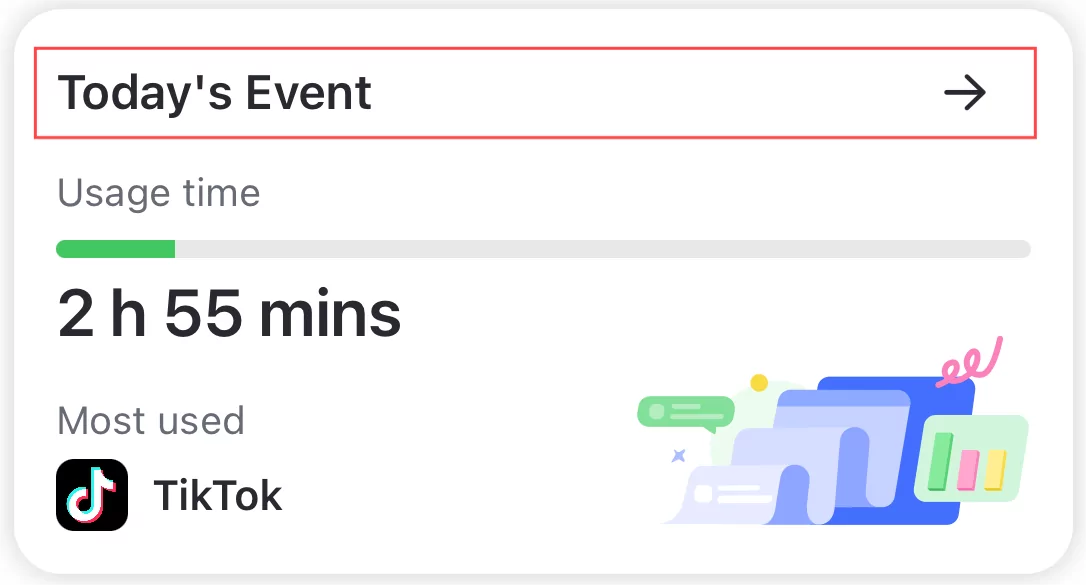
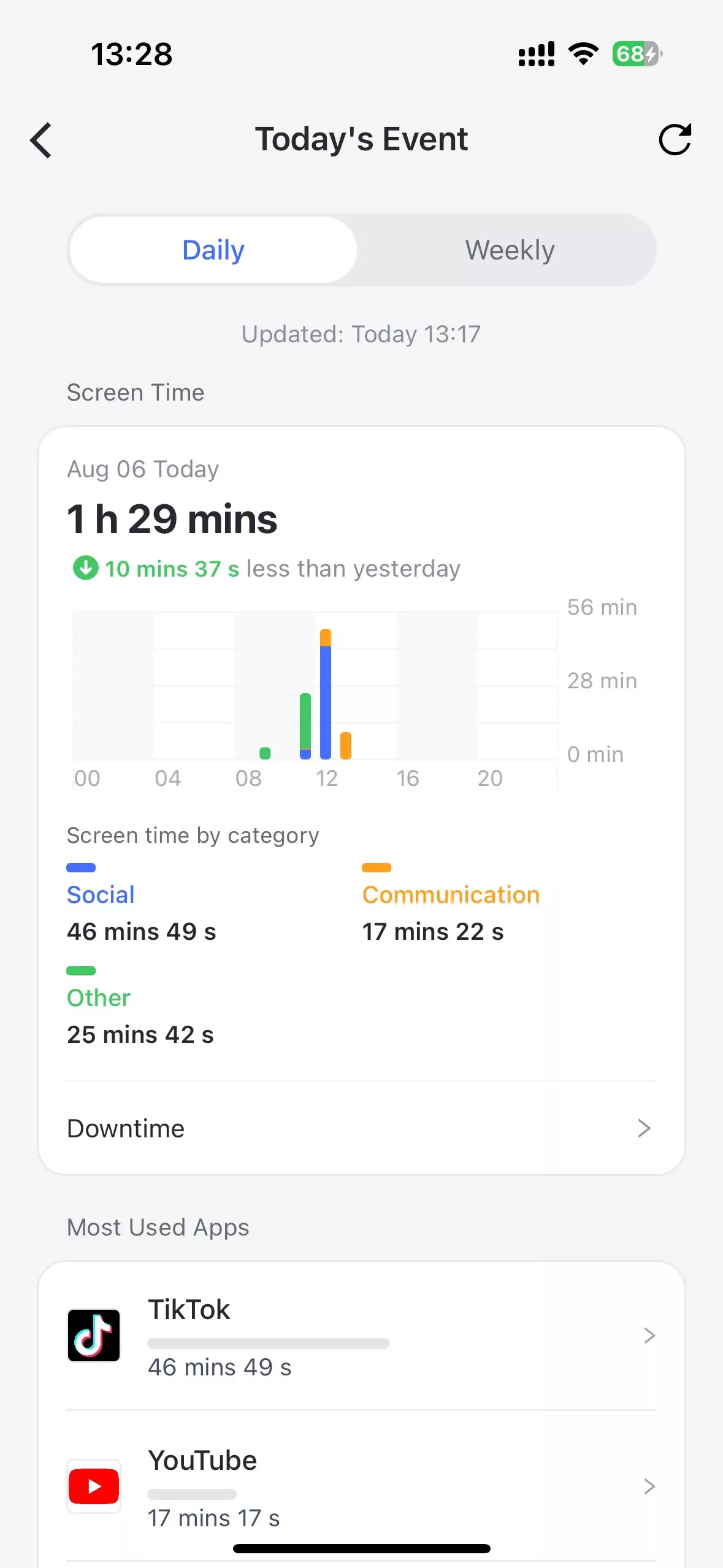
Screen Time Usage - Check when and how long the device has been used. You will know what kinds of apps have been used most. You can also directly set up downtime for kid's device here.
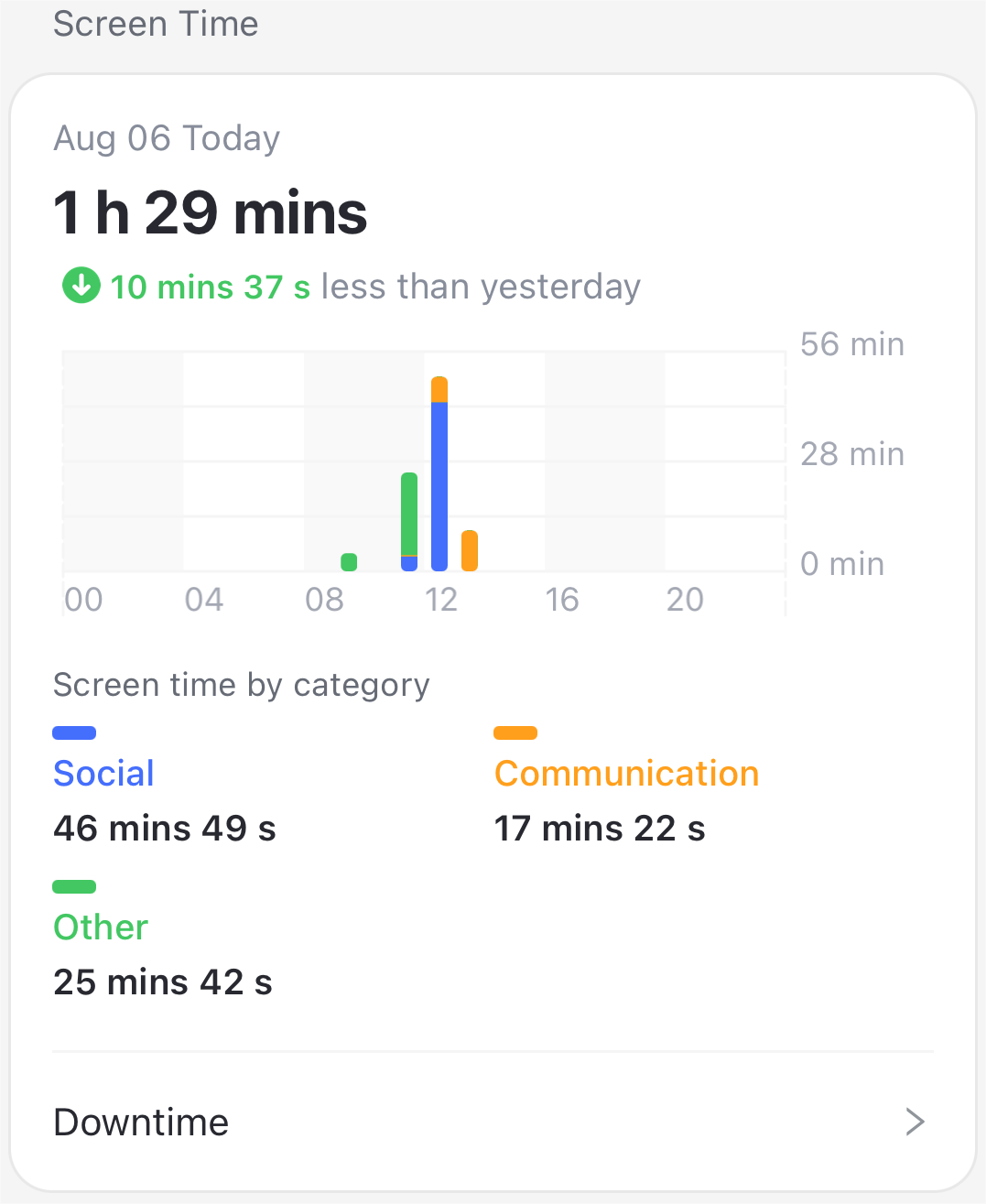
Most Used Apps - Learn more about your kid's most used apps, such as duration time, categories, and age ratings, making sure that your child uses appropriate apps and stays away from malware.

Number of Notifications - Check how many notifications the kid's phone has received. Know the name of frequently-notified apps and the times they received notifications. And read the notifications the app has received by tapping the app name.
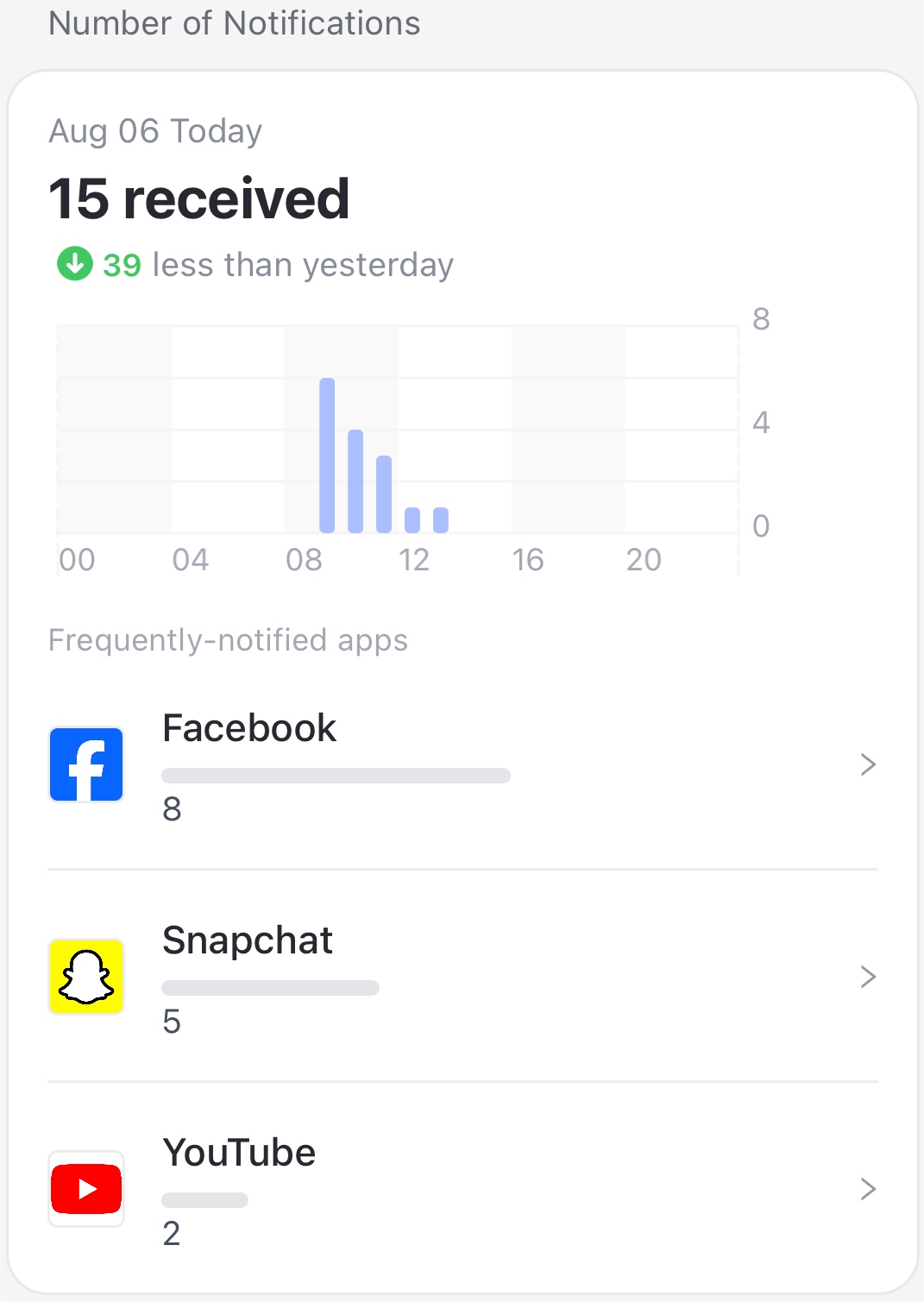
Cellular Data Usage - Find out the cellular data usage of a kid's phone on a specific day. Check which apps have used data and how much they have used.
Requests
Function
- Receive and respond to your child's requests for restricted apps.
- Get notified when your child tries to open a blocked app or installs a new one.
- Know whether your child is in or out of the Geofences.
- Stay aware of low battery and device offline.
- Share new Admin Code with other family members.
- Grab the latest and best deals.
How-to-Use
Press the "message" icon at the top or navigate into the "Request" section if any. Then, you will see three tabs - Requests, Alerts, and System.
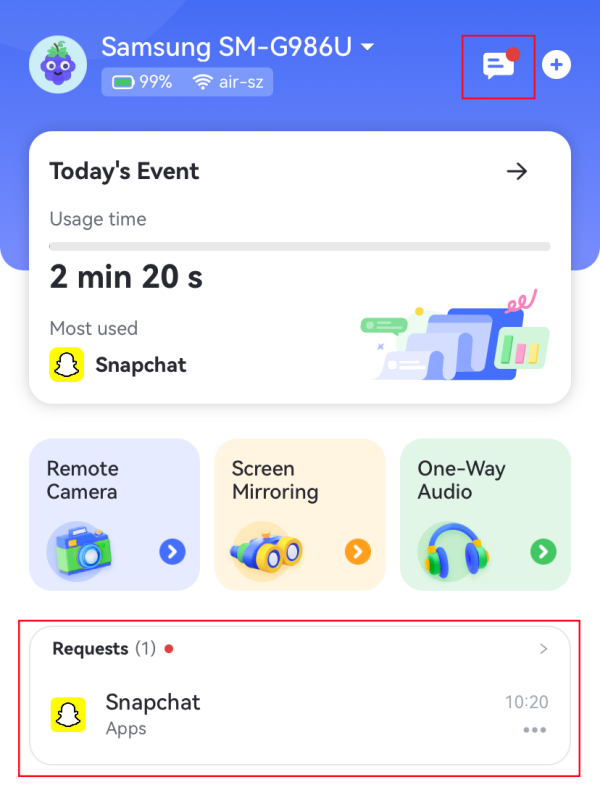
Requests - Check if your child requested to access the blocked application. Then, choose "Approve" or "Refuse" to decide whether to grant additional time for the restricted app.
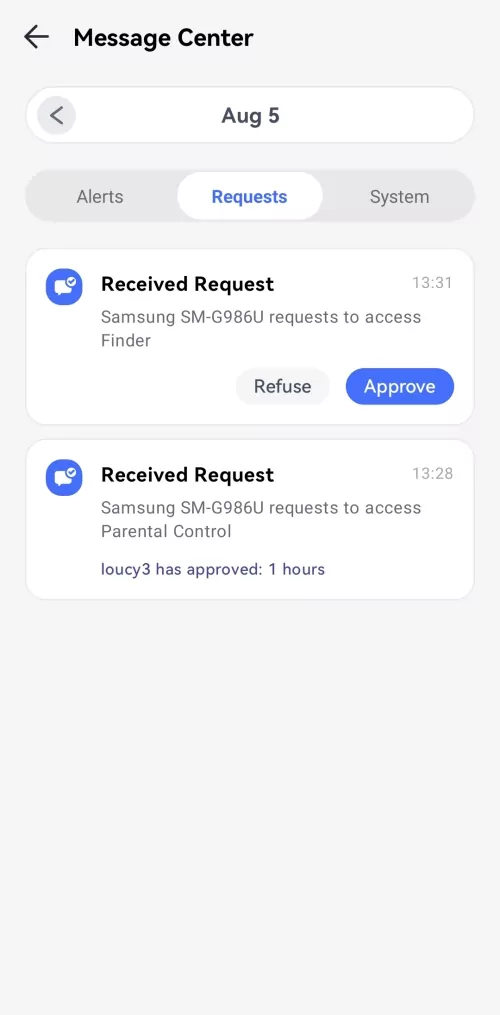
When approved, go to pick these options for your preferences: 5 minutes, 10 minutes, 15 minutes, 30 minutes, 1 hour, Available for today, and Always allowed.
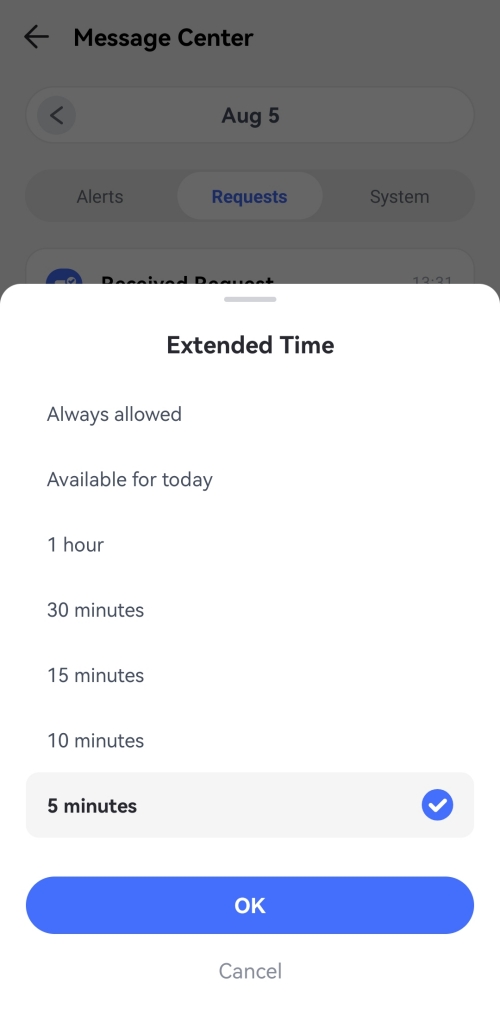
Alerts - Get immediate alerts of low battery, device offline, when your child tries to open blocked apps or install a new app, and reach or leave the geofencing area.
You can also choose to see the restricted app details or add it to the "Always Allowed" list directly. For the newly installed app, AirDroid Parental Control allows you to block it at the touch of a button.
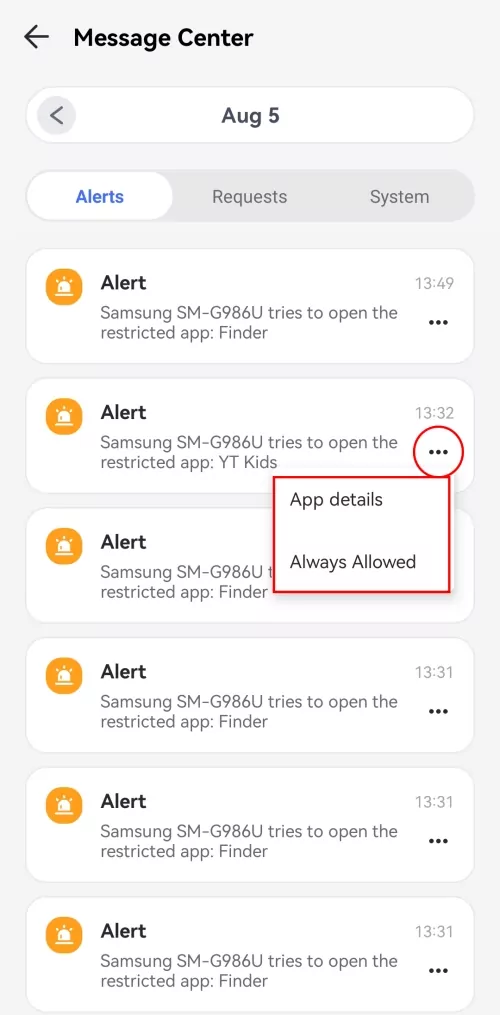
System - Whenever you or the family member change or remove the Admin code, you'll get notified. Plus, receive the latest notifications if there are discounts or sales on the app.

By tapping on the "<" or ">" button, you are able to check the alerts of the previous or next day.
Part 7: Family Chat
Function
- Invite family members to the Family Group
- Group or personal chat with all family members
- Send text messages, audio message, files, videos and photos or make calls
- Remove a child from the group and personal chat
Steps to Invite Family Members to Chat Group
The admin can invite up to 10 family members to the group. The steps are easy:
- Step 1.Tap "My" at the bottom of the parental dashboard and Select "Family Members".

- Step 2. Tap the Invite icon, and enter the member's email. Then, tap "Invite" to confirm.

- Step 3.Ask the family member to check their email to accept the invitation.

You can also tap the "+" icon at the upper-right corner to invite more family members.
![]()
Please kindly noted that all joined family members can also adjust parental control settings for child's device from the dashboard.
Chat with Family Members
If no child is hidden, the admin, all joined family members and supervised children are in the Family Group. From the Family tap, all of the members in the group can send personal messages to others.
You can send text messages, audio message, files, videos and photos in both group and personal chat.
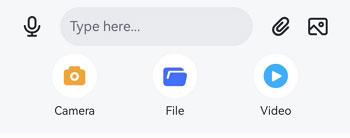
The call feature is only available in personal chat. Tap the call icon at the upper-right corner to call the other person.

Remove a Child from the Family Group
After binding a child’s device to your account, they will in the Family Group by default. However, the admin can remove a child from the chat.
- Step 1.Select "My" at the bottom of the dashboard.
- Step 2.Tap "Child’s Devices," find the child you want to hide, and tap the edit icon next to their name.

- Step 3.Select "Managed by me only."

Only the admin can chat with the hidden child, monitor and mange the child’s device.
Part 1: Get Started on Parent's End
Get started with AirDroid Parental Control by first installing and registering an AirDroid account on the parent's device.
- Step 1.Download AirDroid Parental Control
Directly search for AirDroid Parental Control on Google Play or App Store to download it. You can also download the app by clicking the download icon below.
- Step 2.Register an AirDroid Account
Install and launch AirDroid Parental Control on your devices. You will be directed to the sign-in page. If you haven't registered for an AirDroid account, please click "Create one" to sign up.

- Step 3.Select Device Owner
Follow the on-screen instructions to select "Mine" and click the "Agree" button to proceed to the next step.

Part 2: Connect Kid's Device
Below are the detailed steps to tie up your kid's iOS device.
We have also created a YouTube video to help you understand this guide better and faster.
Video Tutorial: How to Connect Kid's iOS Device in AirDroid Parental Control
- Step 1.Install AirDroid Kids and Bind Your Kid’s Device
- 1. After installing AirDroid Parental Control on your device, you will be directed to a binding page with a QR code and a URL.

- 2. Use your child's iOS device to scan the QR code or enter the URL in a browser to download AirDroid Kids onto the device. You can also search AirDroid Kids in the App Store of your child's iPhone or iPad.
- 3. Your child's iOS device will redirect to the App Store. Tap the download icon to complete the download and installation.

- 4. Tap “Accept” to continue, and then enter the binding code which shows on the parent’s end.

- 5. Follow the on-screen instructions to edit your child’s profile and enable the location permission.

- 6. You can now track your child's iPhone location from your account. To unlock all features, you will need to enable Supervision Mode.
- Step 2.Enable Supervision Mode
- 1. Enter the link apps.airdroid.com/connector in a browser to download AirDroid Parental Connector on your computer or Android device. On Android, you can also search AirDroid Parental Connector in Google Play Store directly.
- 2. After installation, open AirDroid Parental Connector and use a USB cable to link your child’s iPhone/iPad to your computer or Android device.

- 3. Tap "Trust" on the iOS device.
 Tips: If you are using Android to enable Supervision Mode, you’ll also need to tap OK on Android to let AirDroid Parental Connector access the USB device.
Tips: If you are using Android to enable Supervision Mode, you’ll also need to tap OK on Android to let AirDroid Parental Connector access the USB device.
- 4. Select "Enable Supervision Mode" on the AirDroid Parental Connector.

- 5. Enter the Pairing Code displayed on the screen of your child's iOS device in the pop-up window.

- 6. Click "Start" to begin the process. Your child's iOS device will restart, and once the restart is complete, you can supervise your child's iOS device from your phone.

Part 3: Start Supervising
Limit App Time
Function
- Set time limits or schedule downtime to restrict access to apps or categories within certain time frames.
How-to-Use
- Step 1.Select "App Limits" under "Device Supervision." Then tap "Add Schedule."
- Step 2.Tick the apps or categories you want to limit, then tap "Next" in the upper right corner. You can also quickly find an app by searching for its name.
- Step 3.Select "Time Limits" to set how long your child can use the app.
- Step 4.Select "Downtime" to set when you child can't access the app or category.
- Step 5.Tap "Done" in the upper right corner.
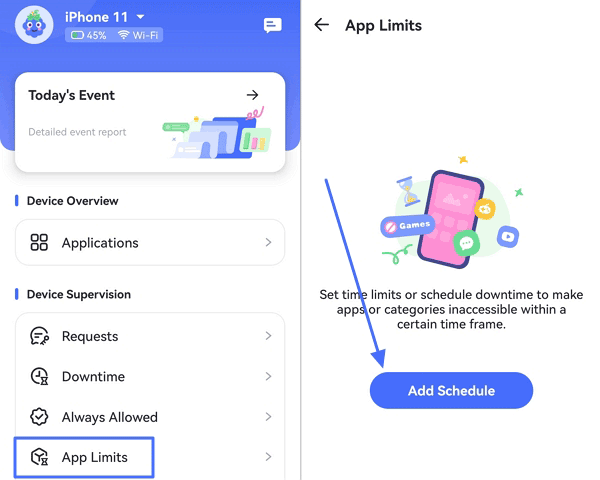

Set the same limits for every day by ticking "Every Day" > setting time limits > tapping "OK."

Set different limits by ticking "Customize" > selecting days from Sun to Sat > setting time limits > tapping "OK."

Set the same downtime for every day by ticking "Every Day" > setting downtime > tapping "OK."

Set different downtime by ticking "Customize" > selecting from Sun to Sat > setting downtime > tapping "OK."

Block App
Function
- Know all apps installed on your kid's phone.
- View what app your kid has added recently.
- See whether the apps are safe for kids.
- Block the apps that you don't want your kids to access.
How to Use
- Step 1.Click on "App & Content Restrictions," and you'll find some native iOS app and content restrictions.
- Step 2.Locate and tap "App Blocker." Then, you can block all apps or individual apps with one-tap. If you choose to block all apps, all apps except those "Always Allowed" will be instantly blocked until you disable this feature.
- Step 3.By tapping on "iTunes & App Store Purchases," you can allow or disallow your child's phone from installing, deleting, or making in-app purchases.
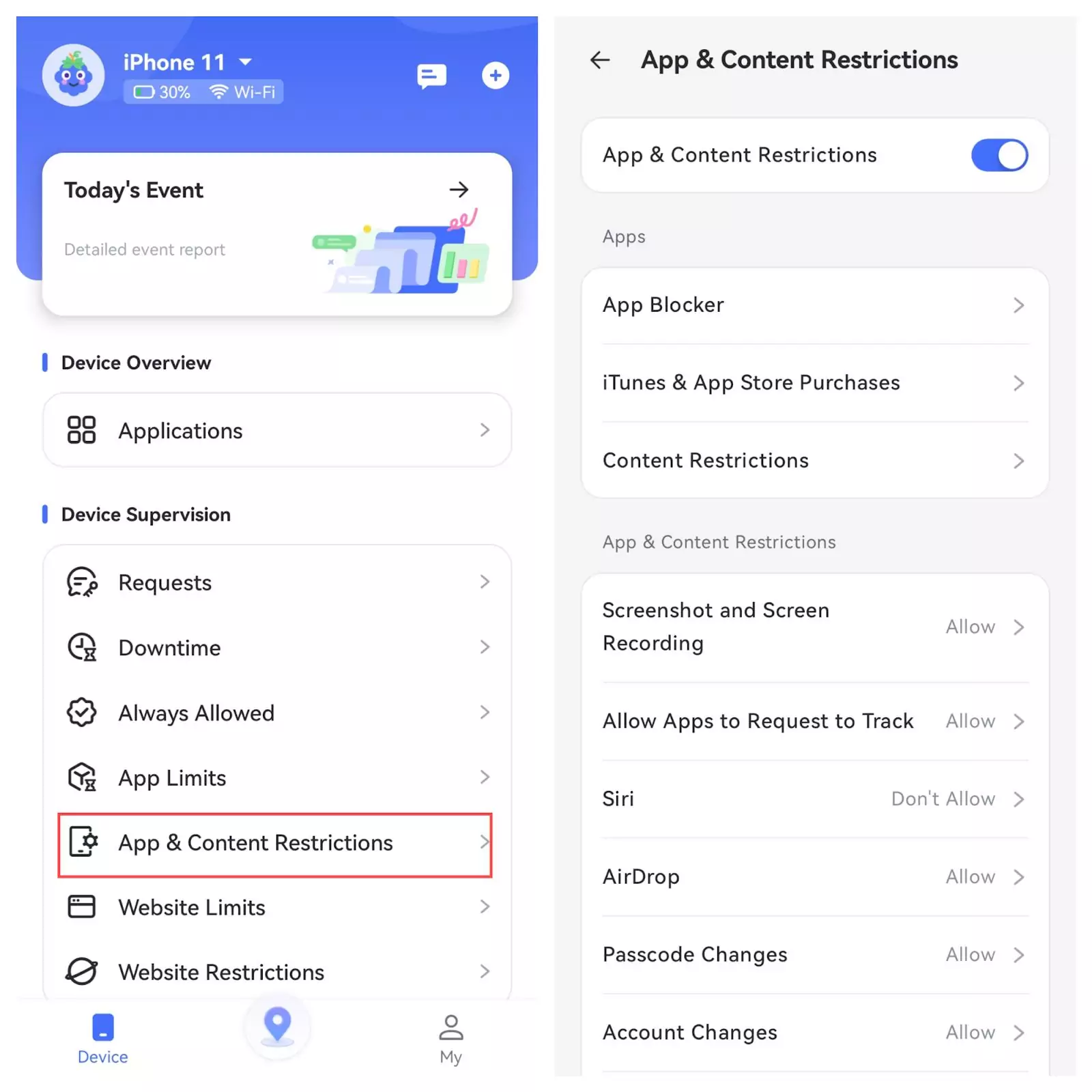
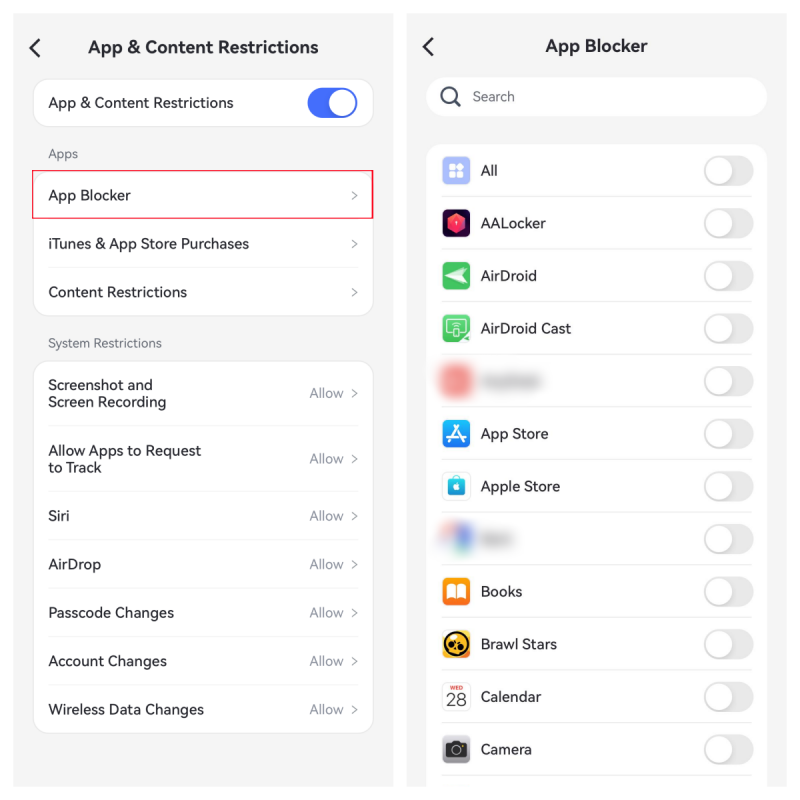
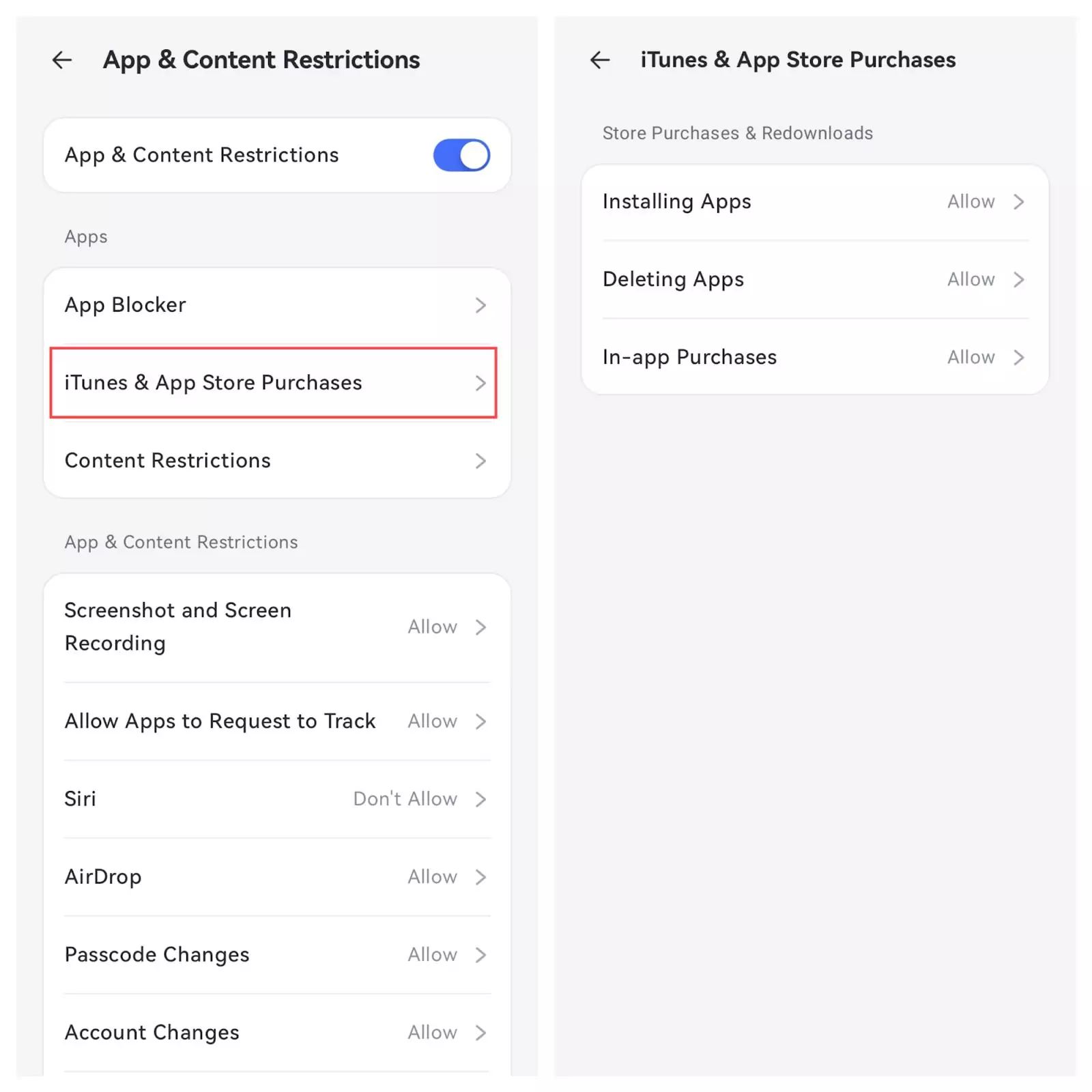
Limit Screen Time
Function
- Schedule downtime to decide when your child's device is not available.
How-to-Use
- Step 1.Scroll down the home page and select "Downtime." Then tap "Add Schedule."
- Step 2.Set the same downtime for every day or customize different downtime for each day. You can even set downtime to activate in specific areas.
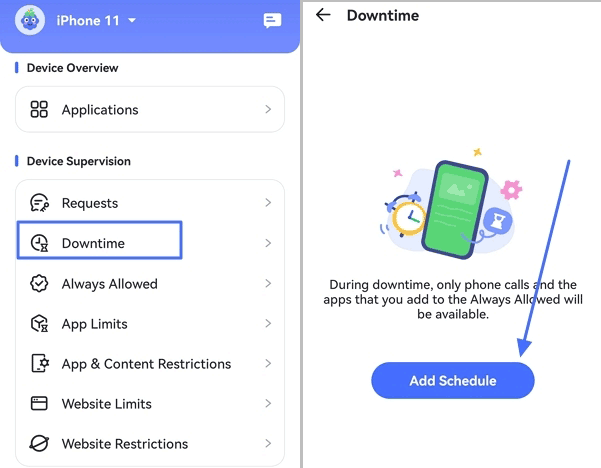

💡During downtime, phone calls and apps added to "Always Allowed" will be accessible. So, you can add apps and websites to the "Always Allowed" list to let your kid can always access them. Here's how:
- 1.Select "Always Allowed" under "Device Supervision" on the home page.
- 2.Tap to open it. You'll see all the apps on your child's device. Search for the app you want to add or scroll down to find it, then tap the "+" on the left of the app to add it to the allowlist.
- 3.Switch to "Websites" by tapping it. Then tap the "+" next to "Add URLs to the Whitelist" to enter the websites you will always allow your children to access.




Restrict Device Access
Function
- Instantly block all apps except those always allowed until the set time ends or you disable this feature.
How-to-Use
- Step 1.Under "Device Supervision," locate and tap "Instant Block."
- Step 2.Choose to block all apps (except always allowed apps) for 1 hour, 2 hours, until midnight, or until manually turned off. Then, tap "OK."
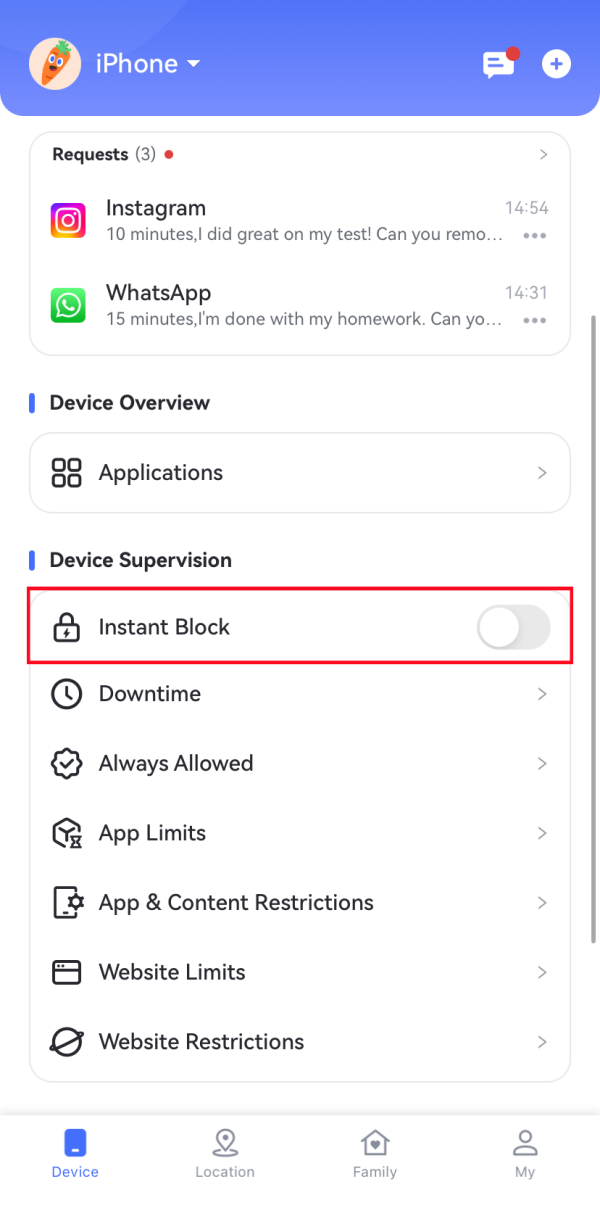
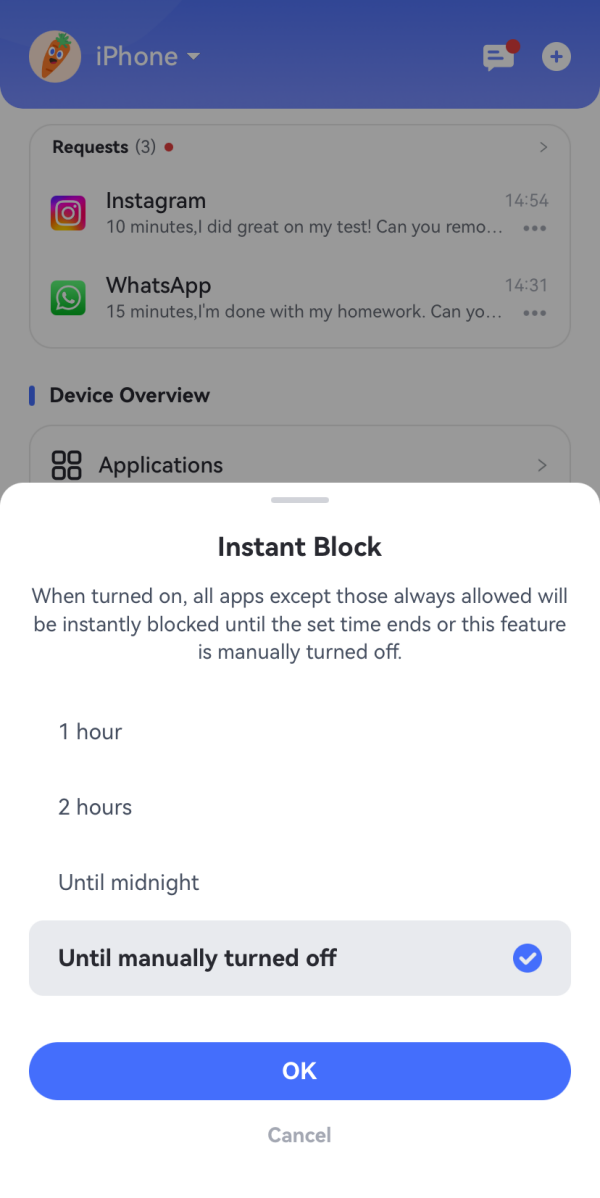
Filter Web Content
Function
- Allow or block any websites on kid's devices.
- Change web filtering levels flexibly.
- Filter websites one by one or by categories.
AirDroid Parental Control can manage all installed browsers on your child's iOS device, including Safari, Opera, Edge, Chrome, and more.
How-to-Use
- Step 1.Choose Website Restriction Mode
- Unrestricted Mode: No restrictions for the websites your child can visit.
- Block Mode: Blocking the sites you added or the website types you choose to block.
- Whitelist Mode: Where your child can only access the sites you add.
In AirDroid Parental Control, go to "Website Restrictions" from the home page.
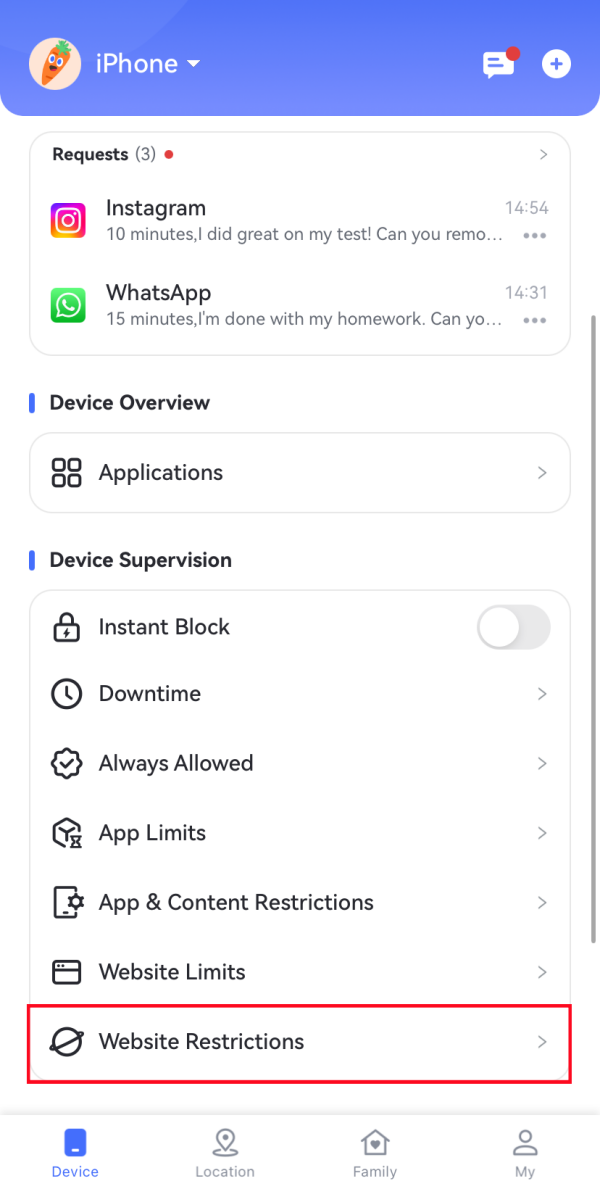
Then, tap "Mode" and you can manage your child's web activities in these 3 different modes:

- Step 2.Set Website Blacklist for Your Kid
- In "URL Blacklist", tap "Add custom URLs to the Blacklist." Then, input the web address you don't want your child to visit.
- Surely, you can also add the blacklist URL from your child's browsing history.
- Or switch to the "Subscription" tab to block the website by categories for your kids. This includes common categories that aren't suitable for kids, such as adults, drugs, violence, gambling, and more.



- Step 3.Set Website Whitelist for Your Kid
- In "URL Whitelist", tap "Add URLs to the Whitelist" to specify sites your child can visit or add allowed websites from their browsing history.

Limit Web Usage
Function
- Set a total time limit on websites.
- Or schedule downtime to limit access to websites during specific periods.
How-to-Use
- Step 1.Select "Website Limits" and then tap "Add Schedule."

- Step 2.Set how long your child can use the URL:
- Tap Add URL to enter the URL you want to limit. You can also add URLs from the browsing history.
- Select Time Limits.
- Choose if you want to set the same limits for every day or customize different limits.
- Tap Time to set the exact time limit.
- Confirm the limits by tapping OK
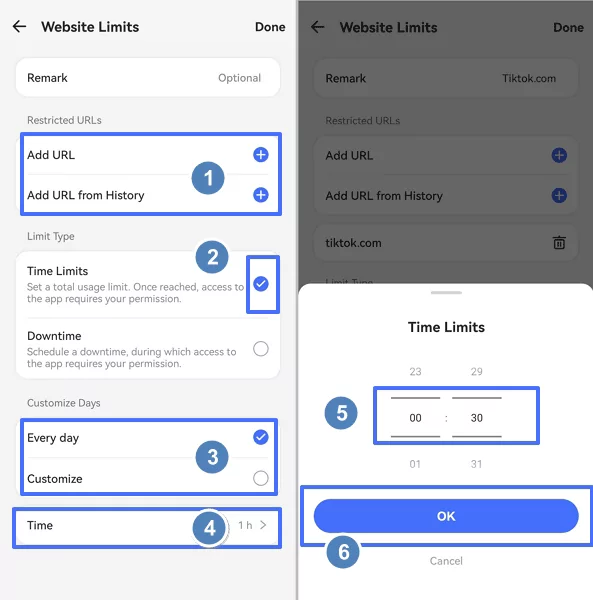
- Step 3.Set when you child can't access the URL:
- Tap Add URL to enter the URL you want to restrict. You can also add URLs from the browsing history.
- Select Downtime.
- Choose if you want to set the same downtime for every day or customize different downtime.
- Tap Downtime at the bottom to set the Start and End time.
- Confirm the downtime by tapping OK.
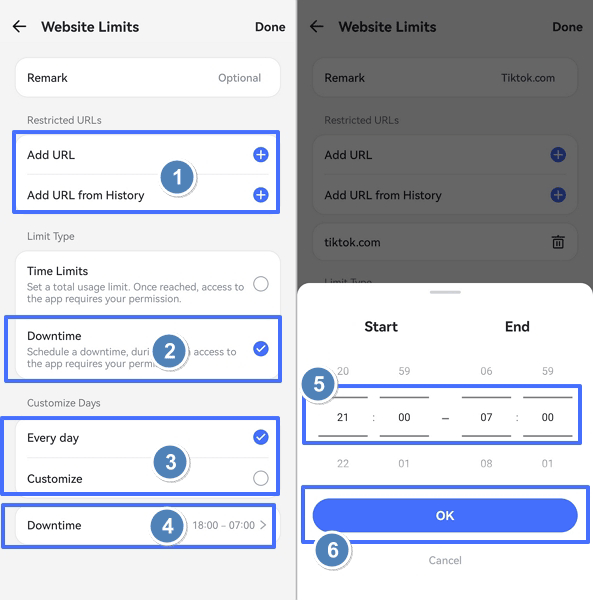
- Step 4.Tap Done in the upper right corner.
Track Browsing History
Function
- Keep a record of your child's browsing and searching history.
- Find out if your child visited blocked websites and get instant alerts.
How-to-Use
- Step 1.Go to "Website Restrictions" from the home page.
- Step 2.Click "View All" to see all entries. AirDroid also enables you to visit the website or add it to the blacklist directly by tapping the three-dot button next to the link.

You can also click "Blocked" to see the websites your child has been prevented from accessing when the "Blacklist Mode" or "Whitelist Mode" is activated.

Manage Content & Privacy
Function
- Prevent explicit content or control content ratings.
- Set restrictions for several types of content, such as movies, apps, books, Siri, games, etc.
- Allow or disallow privacy setting changes.
How-to-Use
- Step 1.Go to "App & Content Restrictions" from the home page.
- Step 2.Scroll down and you can choose to "Allow" or "Disallow" certain system features, such as screenshots and recordings, Siri, AirDrop, password changes, and account changes.
- Step 3.Or select "Content Restrictions" to manage the available content, Siri, or Game Center features for your kids' iPhone.
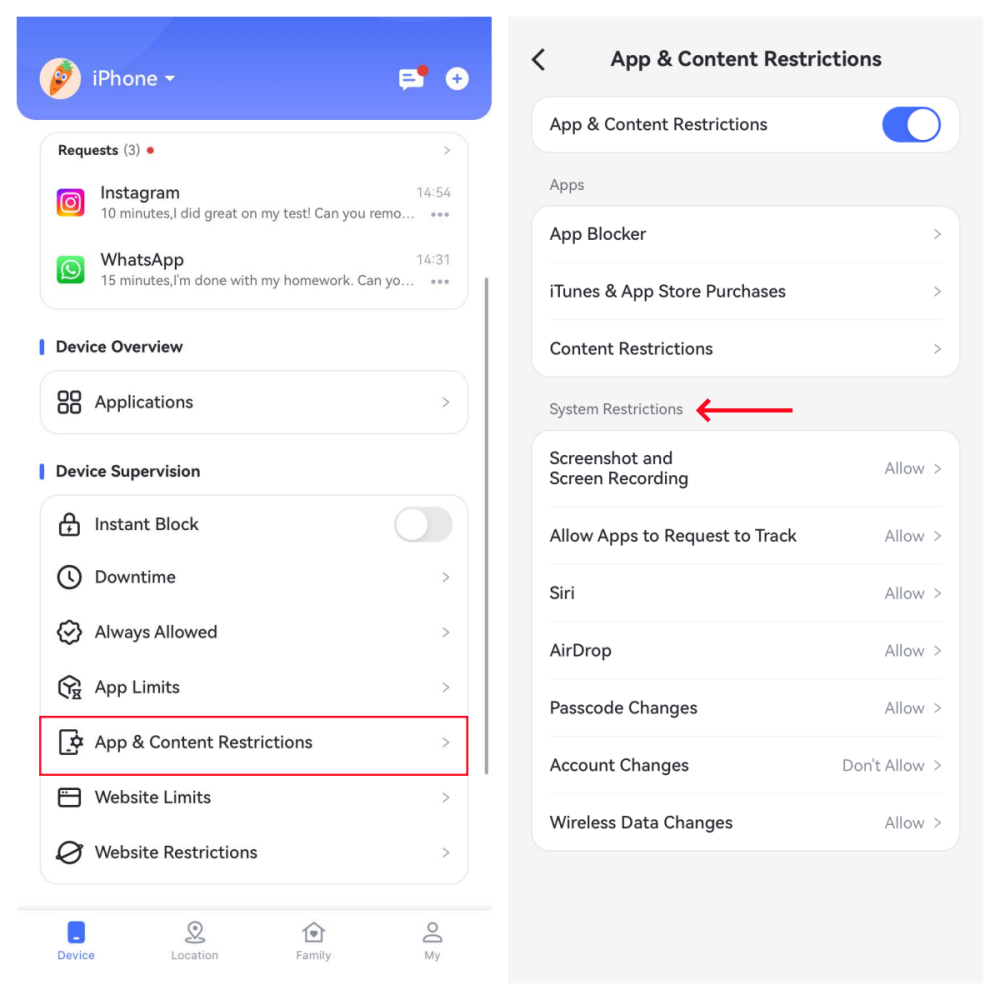
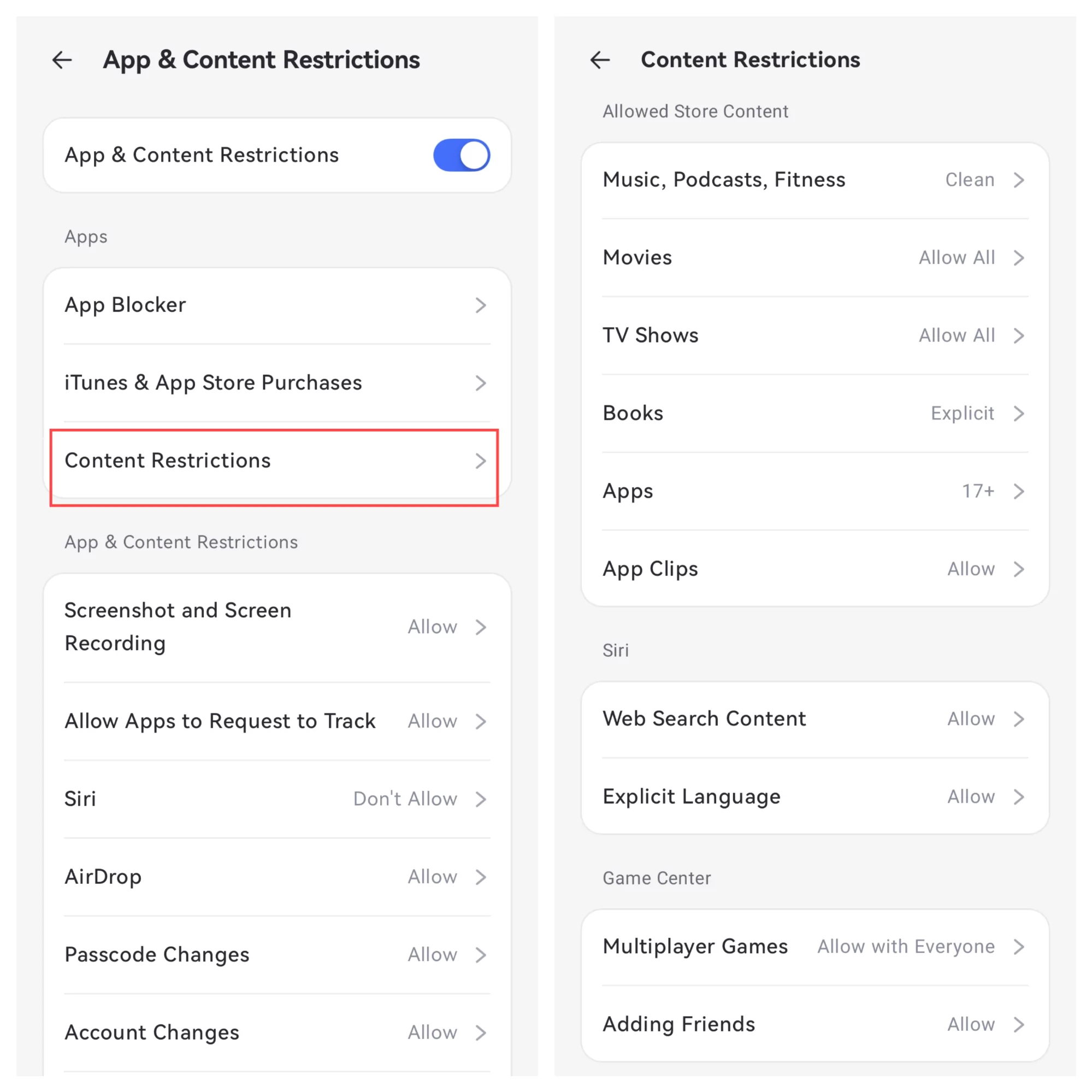
Part 4: Track Location
Live Location
Function
- Check the current location of your kid's device.
How-to-Use
- Step 1.Click the "Location" button at the bottom of the dashboard.
- Step 2.You will see the location of your child's device. To refresh the location, tap the "Refresh" icon in the bottom right corner.
![]()

Route History
Function
- Check where your kids have been.
- View location history of the past 30 days.
How-to-Use
- Step 1.On the location section, tap "Route History" at the top.
- Step 2.You can check the location history in timeline form.


Step 3.Tap the calendar icon to view the location history for the past 30 days. You can also click "<" or ">" to see the previous or next day.
![]()
Geofencing
Function
- Set up a specific area to get notified when kids enter or leave the area.
How-to-Use
- Step 1.On the Location section, tap the "Geofence" button.
- Step 2.Tap "Add geofence."
- Step 3.Enter the geofence name, select the location, and set the radius. When you're done, tap "Save."

Part 5: Check Reports & Alerts
Activity Report
Function
- Check the daily and weekly phone usage details in a timeline format.
- Check information about the most used apps. You can also learn how long they were used and when they were used.
- See how many notifications each app has received.
- Learn which app has used the most data and how much it has used.
- Free to check the activity report of any date within 30 days.
How-to-Use
- Step 1.Tap "Today's Event" at the top of the dashboard.
- Step 2.Choose whether you want to see a "Daily" or a "Weekly" report. The "Daily" report is the default. You can also swipe the chart left and right to check the activity report from the previous day or the next day.
- Step 3.Scroll to view Screen Time Usage, Most Used Apps, Number of Notifications, or Cellular Data Usage.


Screen Time Usage - Check when and how long the device has been used. You will know what kinds of apps have been used most. You can also directly set up downtime for your kid's device here.

Most Used Apps - Learn more about your kid's most used apps, such as duration time, categories, and age ratings, making sure that your child uses appropriate apps and stays away from malware.

Number of Notifications - Check how many notifications the kid's phone has received. Know the name of frequently-notified apps and the times they received notifications. And read the notifications the app has received by tapping the app name.

Cellular Data Usage - Find out the cellular data usage of a kid's phone on a specific day. Check which apps have used data and how much they have used.
Requests
Function
- Receive and respond to your child's requests for restricted apps.
- Get notified when your child tries to open a blocked app or installs a new one.
- Know whether your child is in or out of the Geofences.
- Stay aware of low battery and device offline.
- Share new Admin Code with other family members.
- Grab the latest and best deals.
How-to-Use
Press the "message" icon at the top or navigate into the "Request" section if any. Then, you will see three tabs - Requests, Alerts, and System.
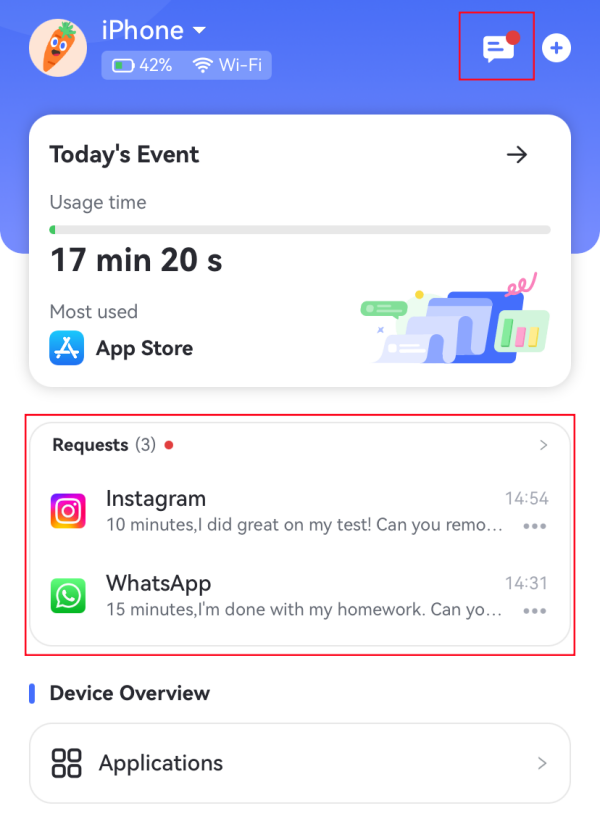
Requests - Check if your child requested to access the blocked application. Then, choose "Approve" or "Refuse" to decide whether to grant additional time for the restricted app.

When approved, go to pick these options for your preferences: 5 minutes, 10 minutes, 15 minutes, 30 minutes, 1 hour, Available for today, and Always allowed.

Alerts - Get immediate alerts of low battery, device offline, when your child tries to open blocked apps or installs a new app, and reach or leave the geofencing area.
You can also choose to see the restricted app details or add it to the "Always Allowed" list directly. For the newly installed app, AirDroid Parental Control allows you to block it at the touch of a button.

System - Whenever you or the family member change or remove the Admin code, you'll get notified. Plus, receive the latest notifications if there are discounts or sales on the app.

By tapping on the "<" or ">" button, you are able to check the alerts of the previous or next day.
Part 6: Family Chat
Function
- Invite family members to the Family Group
- Group or personal chat with all family members
- Send text & audio message, share files, videos & photos and make calls
- Remove a child from the group and personal chat
Steps to Invite Family Members to Chat Group
The admin can add up to 10 family members to the group. Here’s how:
- Step 1.Tap "My" at the bottom of the parental dashboard, and Choose "Family Members."

- Step 2. Tap the Invite icon, and input the member’s email. Then, tap "Invite" to confirm.

- Step 3.Request the family member to check their email and accept the invitation.

You can also tap the “+” icon in the upper-right corner to add more family members.
![]()
Note that all joined family members can modify parental control settings for a child’s device from the dashboard.
Chat with Family Members
If no child is excluded, the admin, all joined family members and supervised children are in the Family Group.
All of the members in the group can send personal messages to anyone in the Group. You can send text or audio messages, and share files, videos and photos in both group and personal chat.

In personal chat, you can even tap the call icon at the upper-right corner to make calls.

Remove a Child from the Family Group
Once a child’s device is linked to your account, they are automatically included in the Family Group. However, the admin can remove a child from the chat.
- Step 1.Tap "My" at the bottom of the dashboard.
- Step 2.Tap "Child’s Devices," locate the child you want to exclude, and tap the edit icon next to their name.

- Step 3.Select "Managed by me only."

Only the admin can communicate with the excluded child and manage the child’s device.

 For Kid's Android
For Kid's Android 
 For Kid's iOS
For Kid's iOS 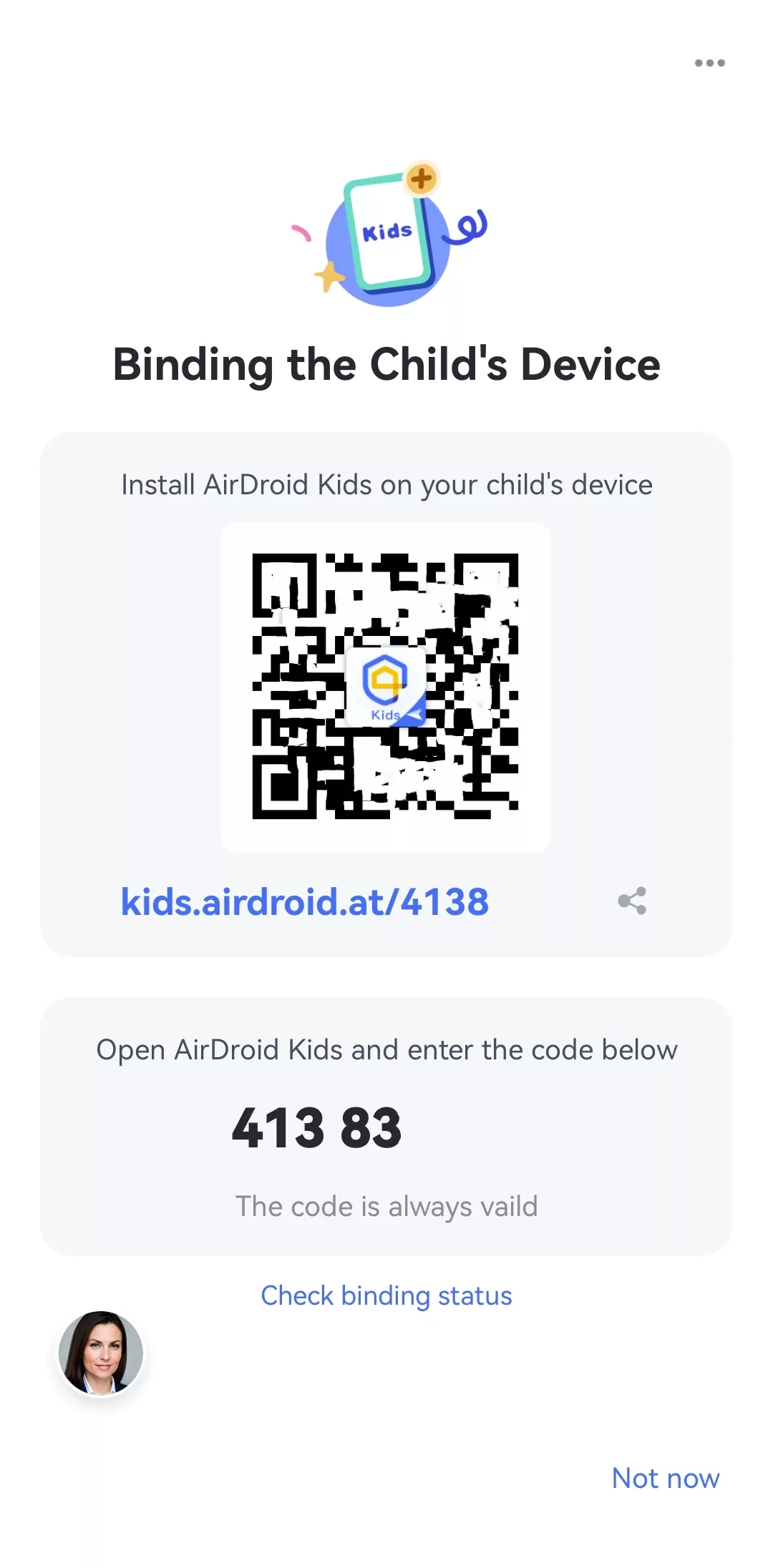
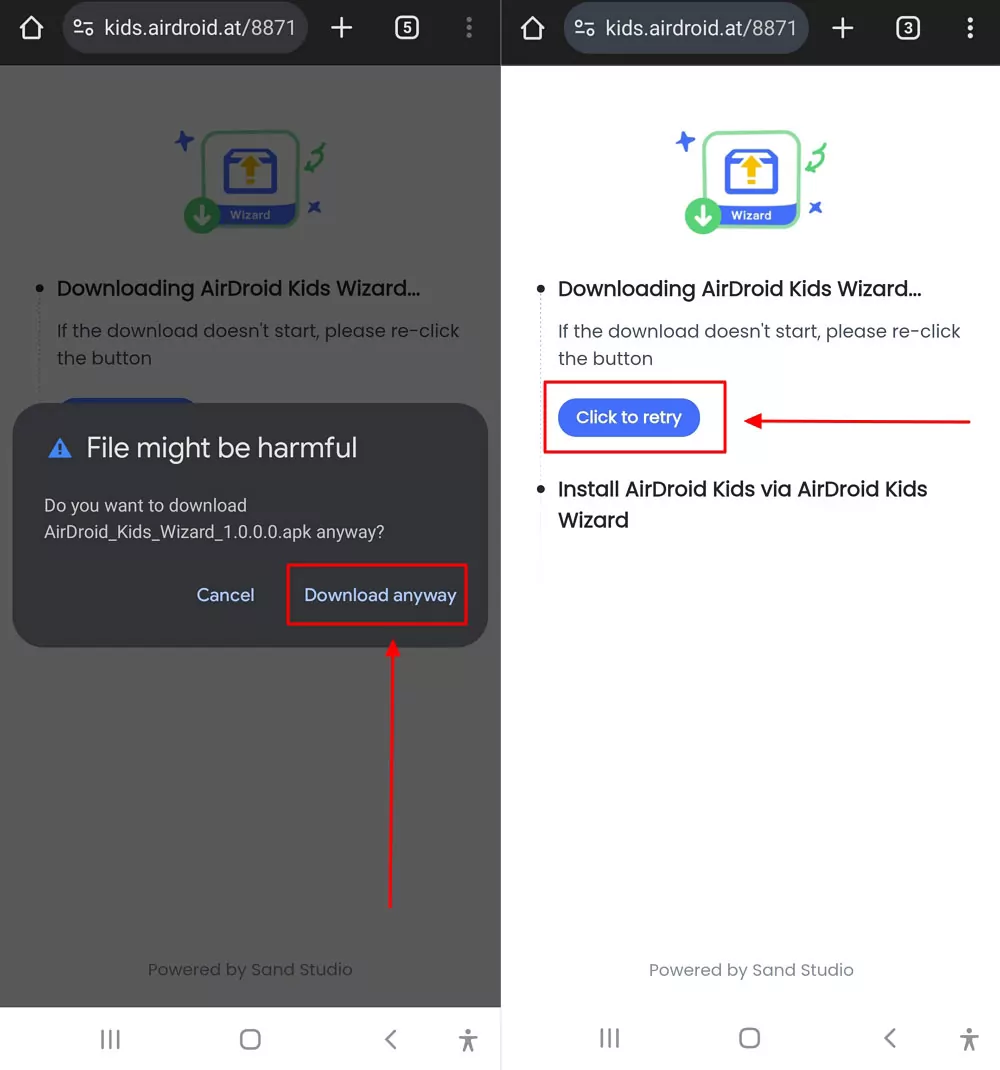
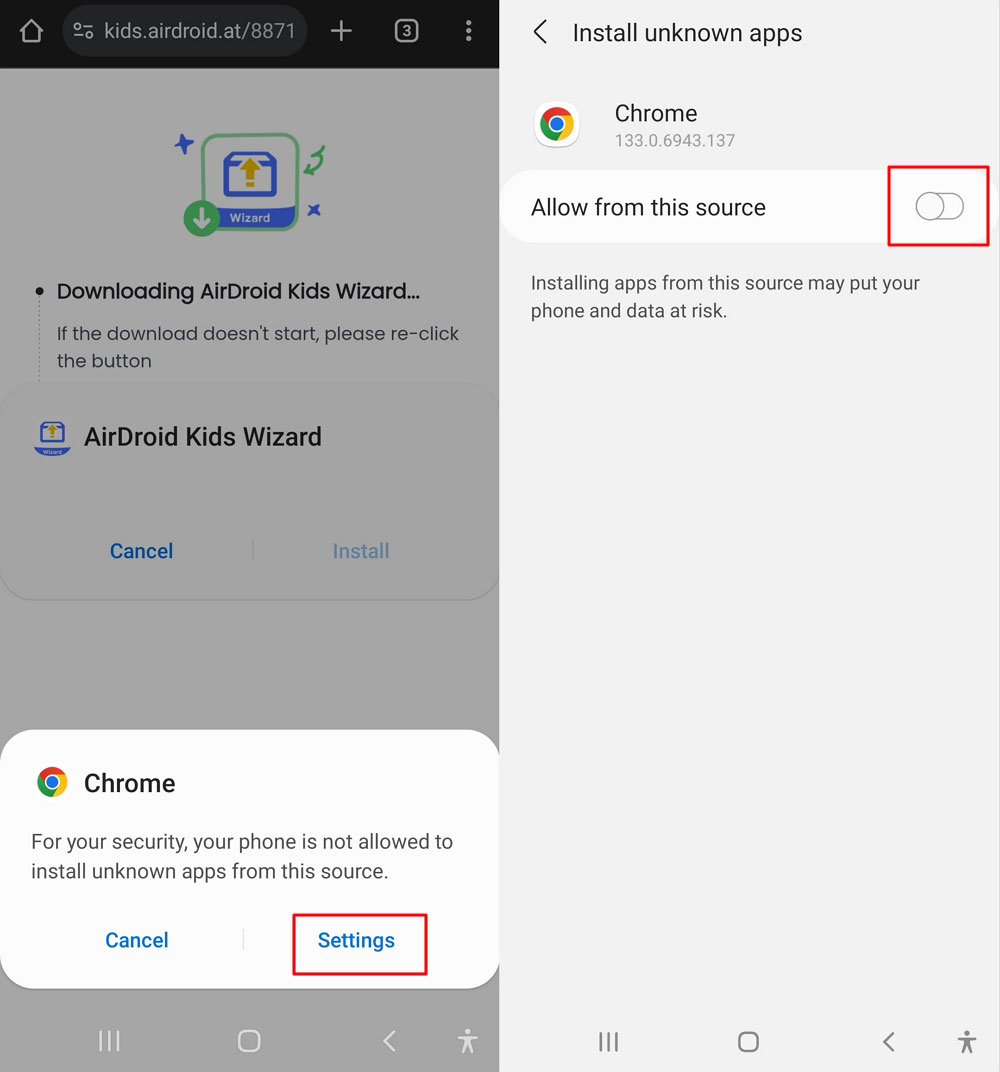
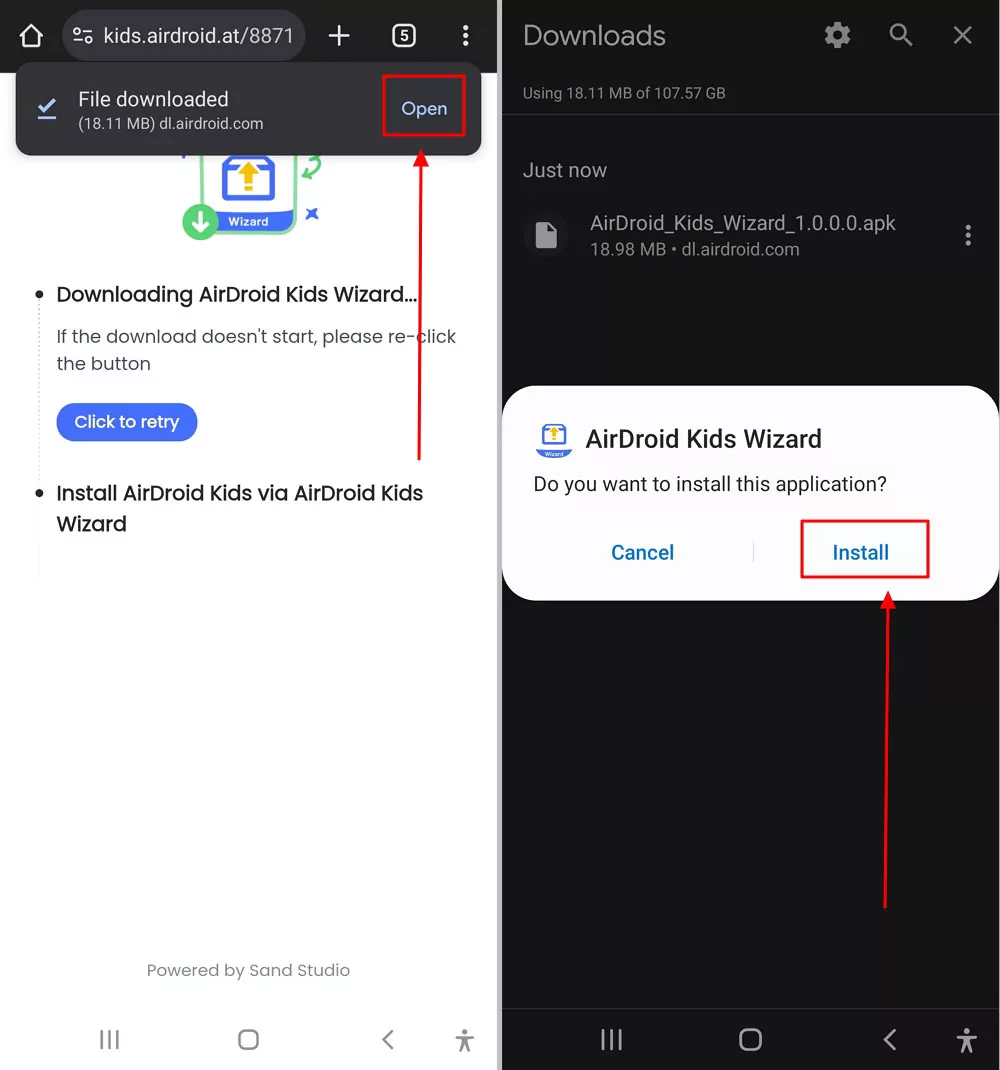
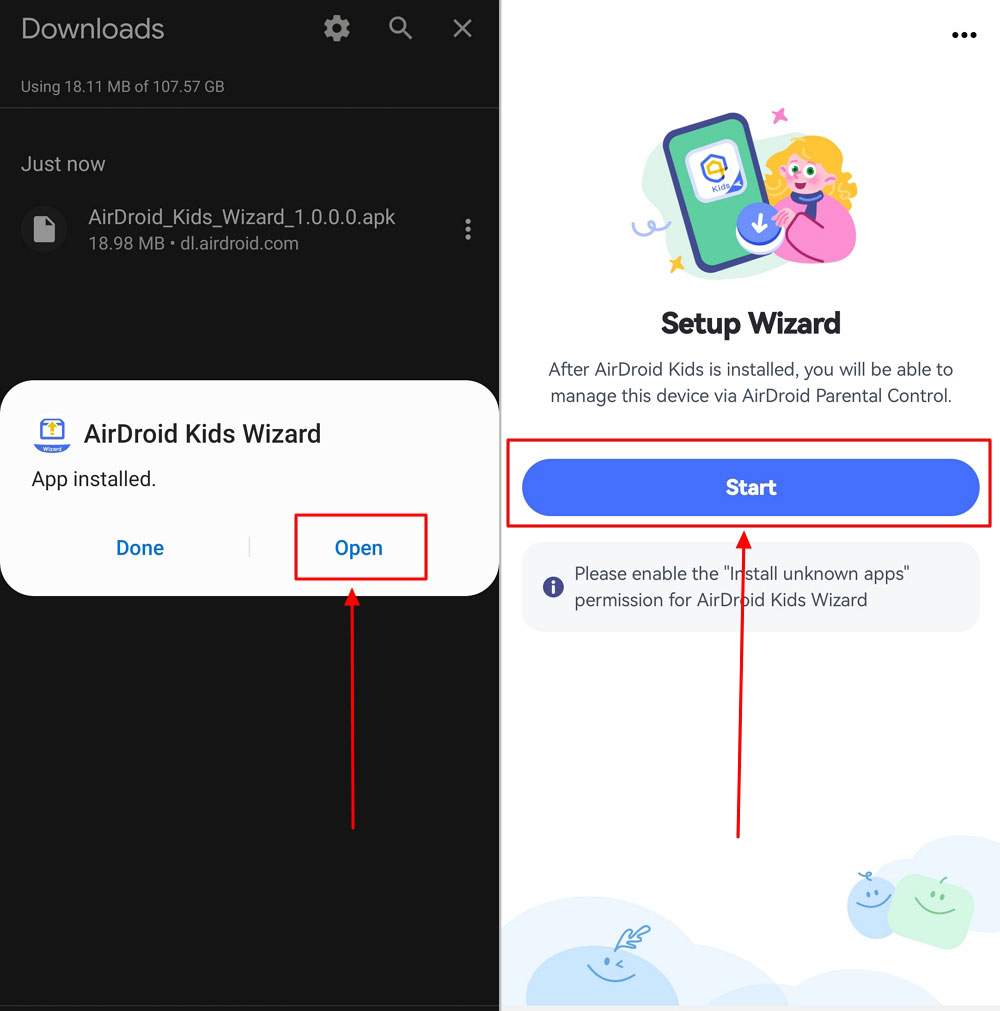
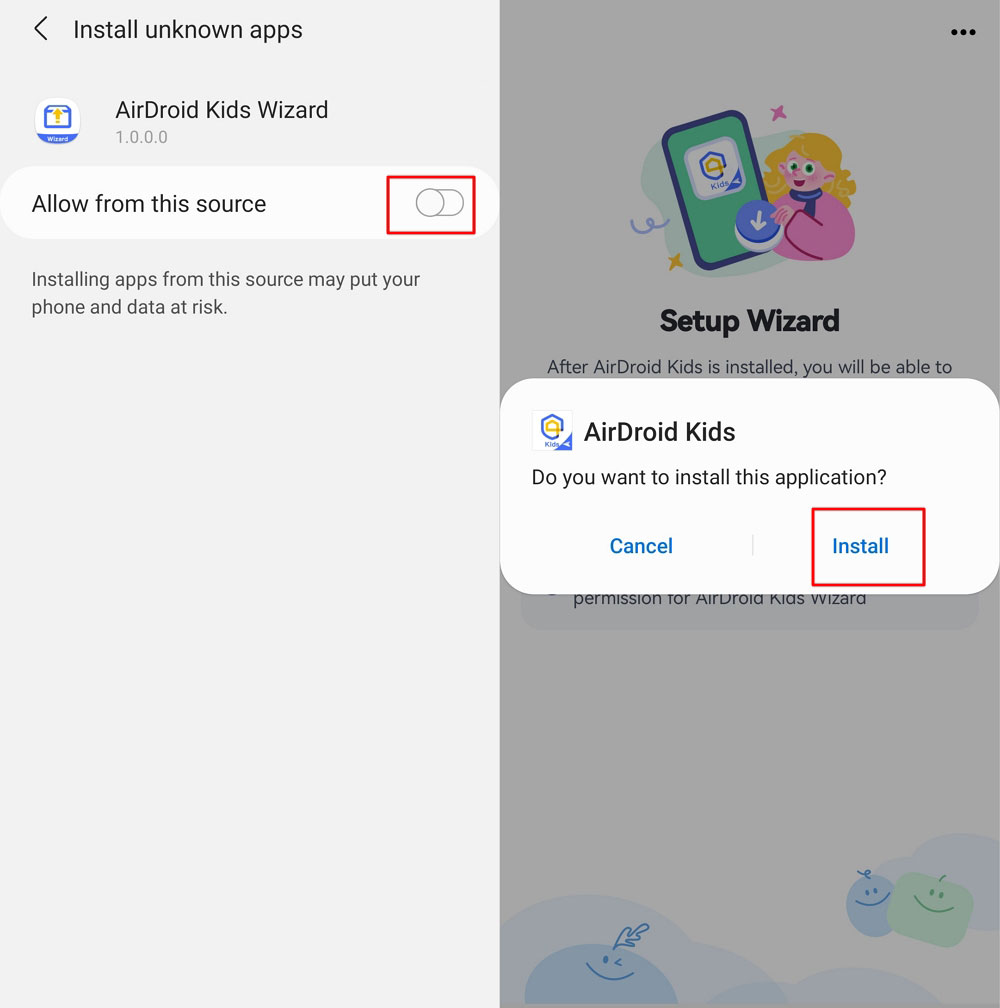
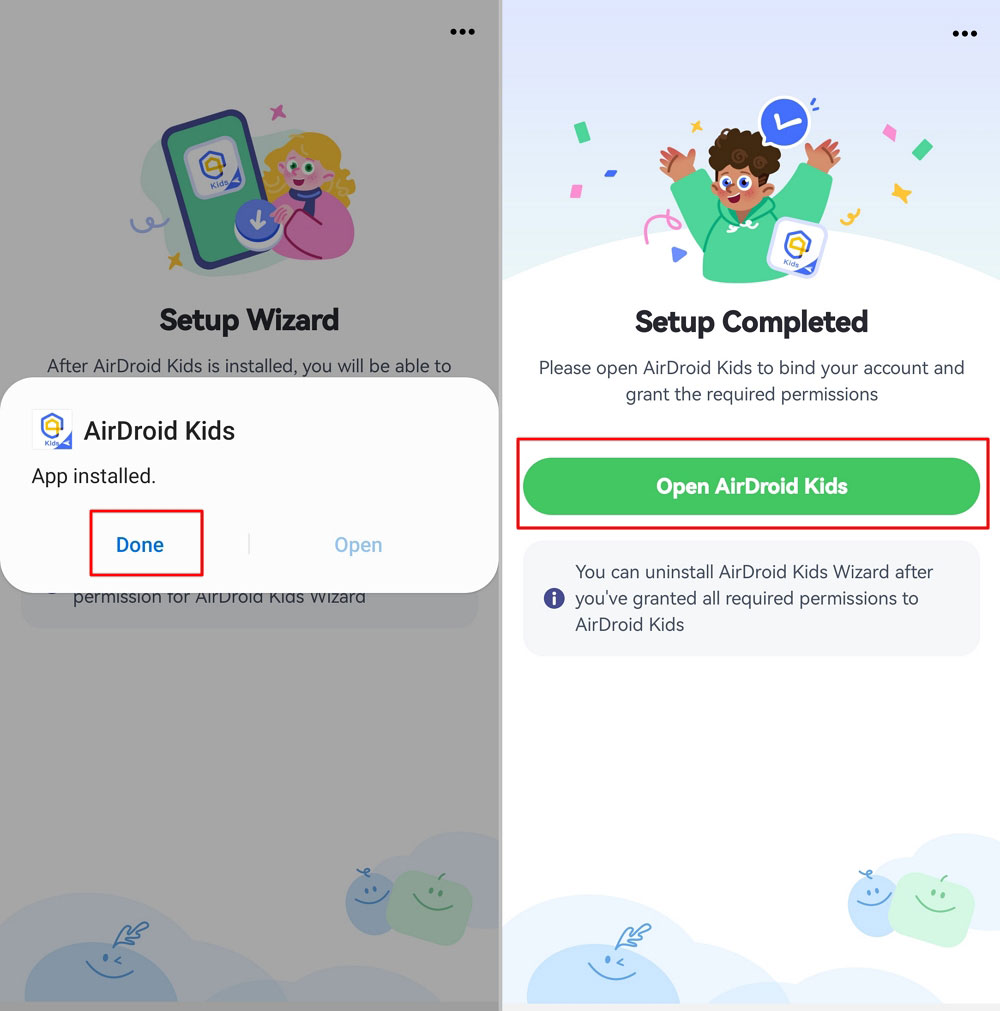
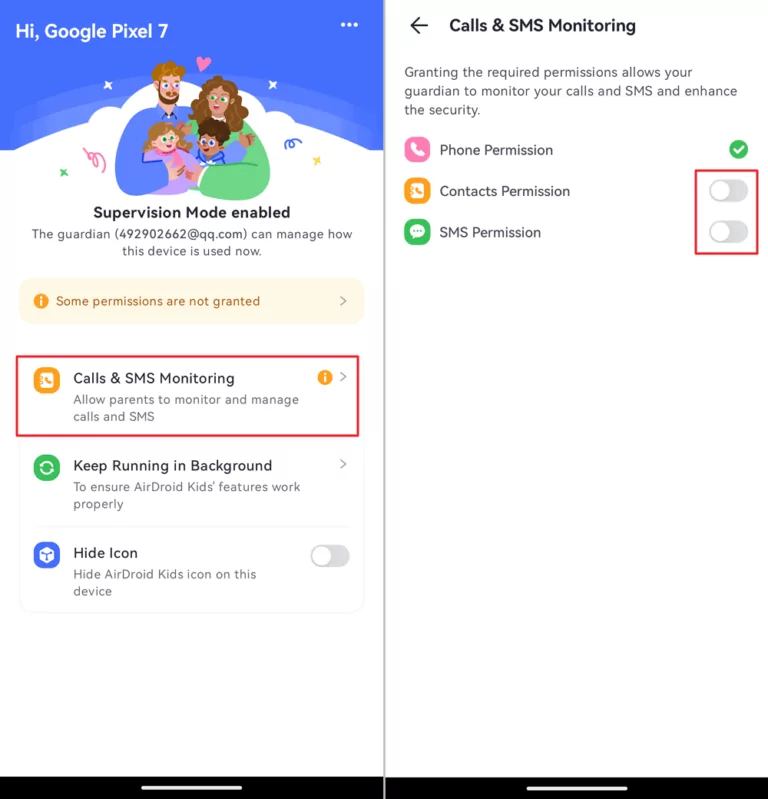
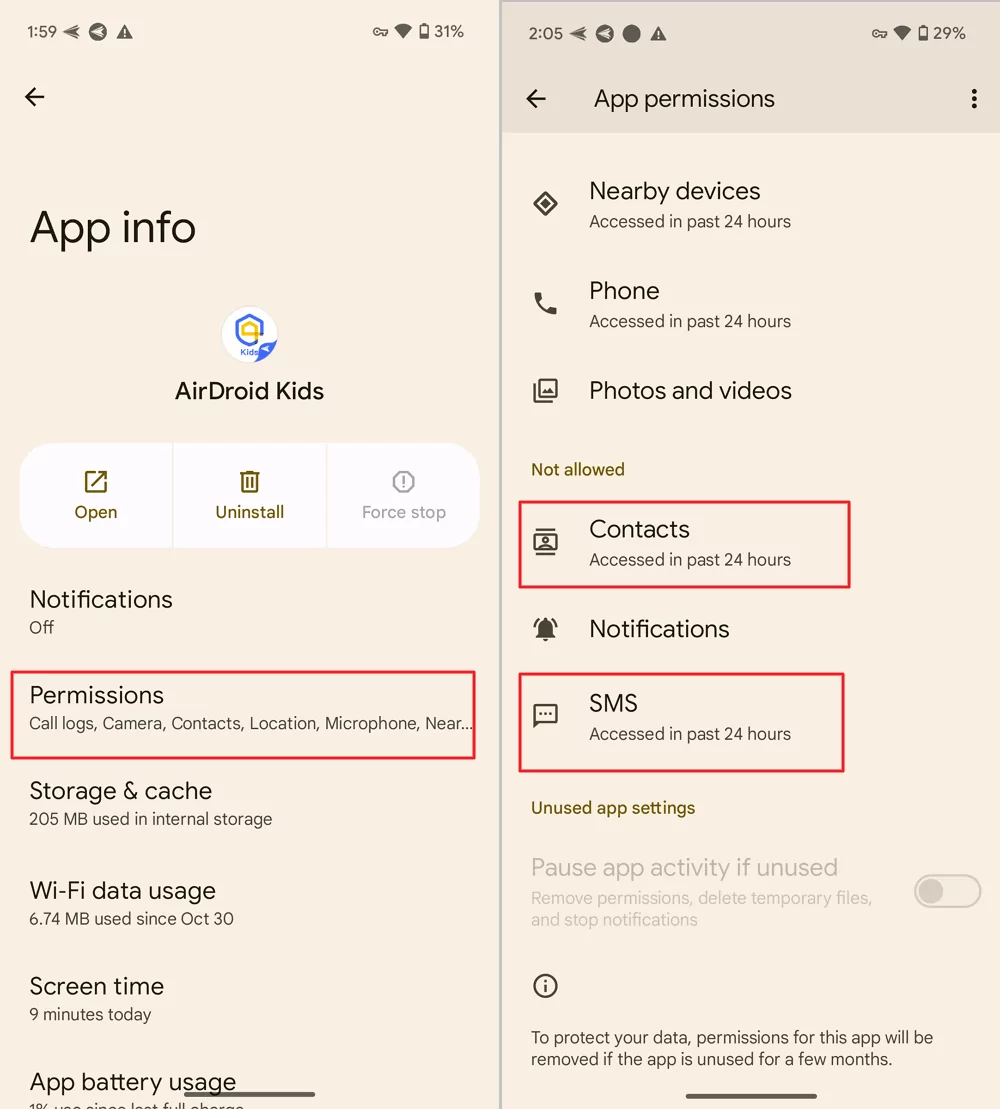
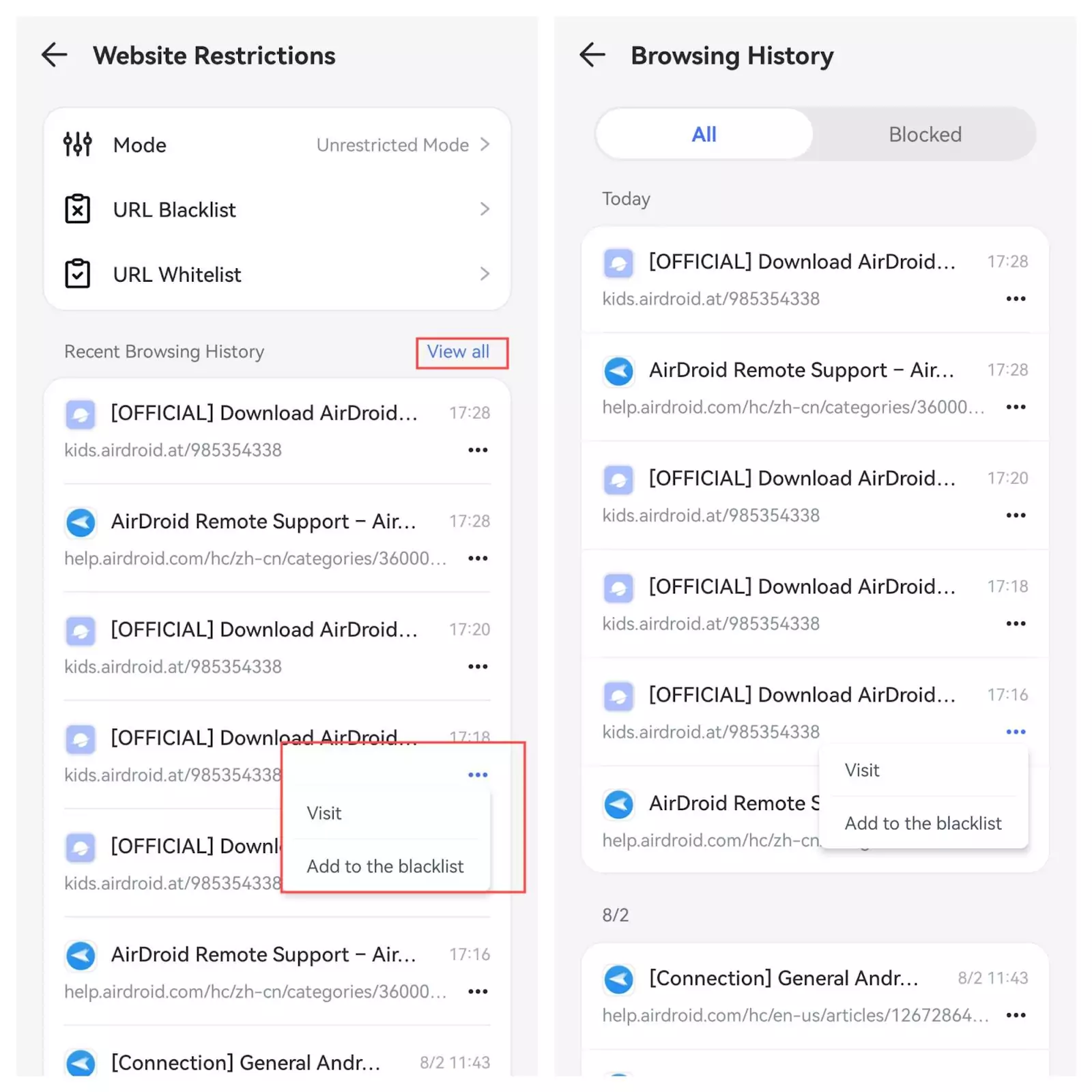
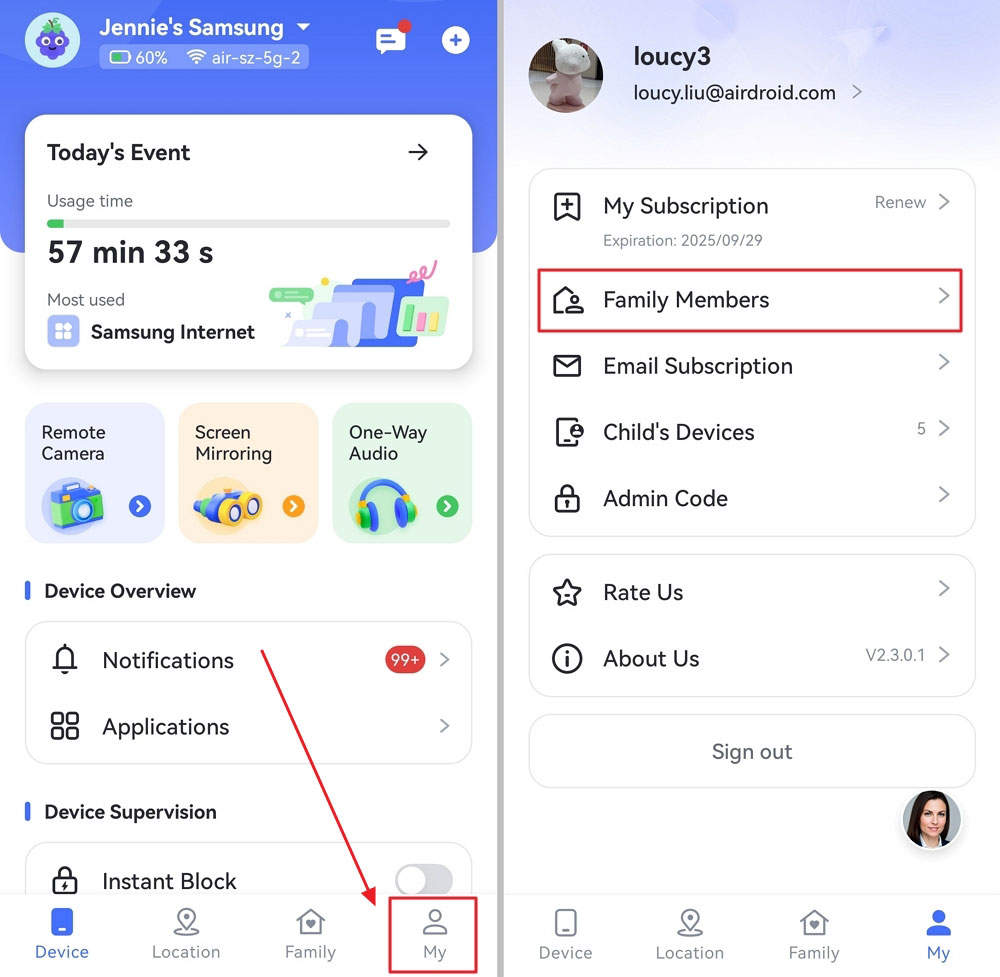
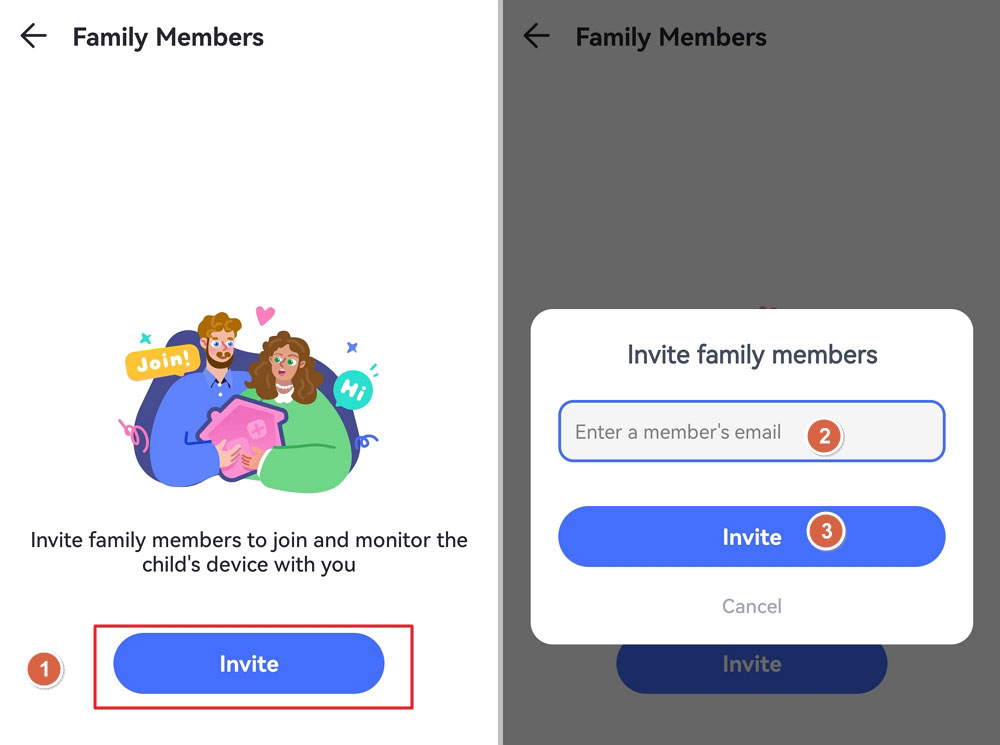


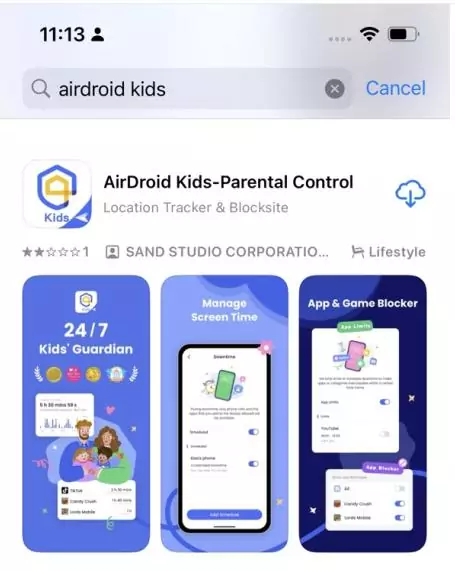
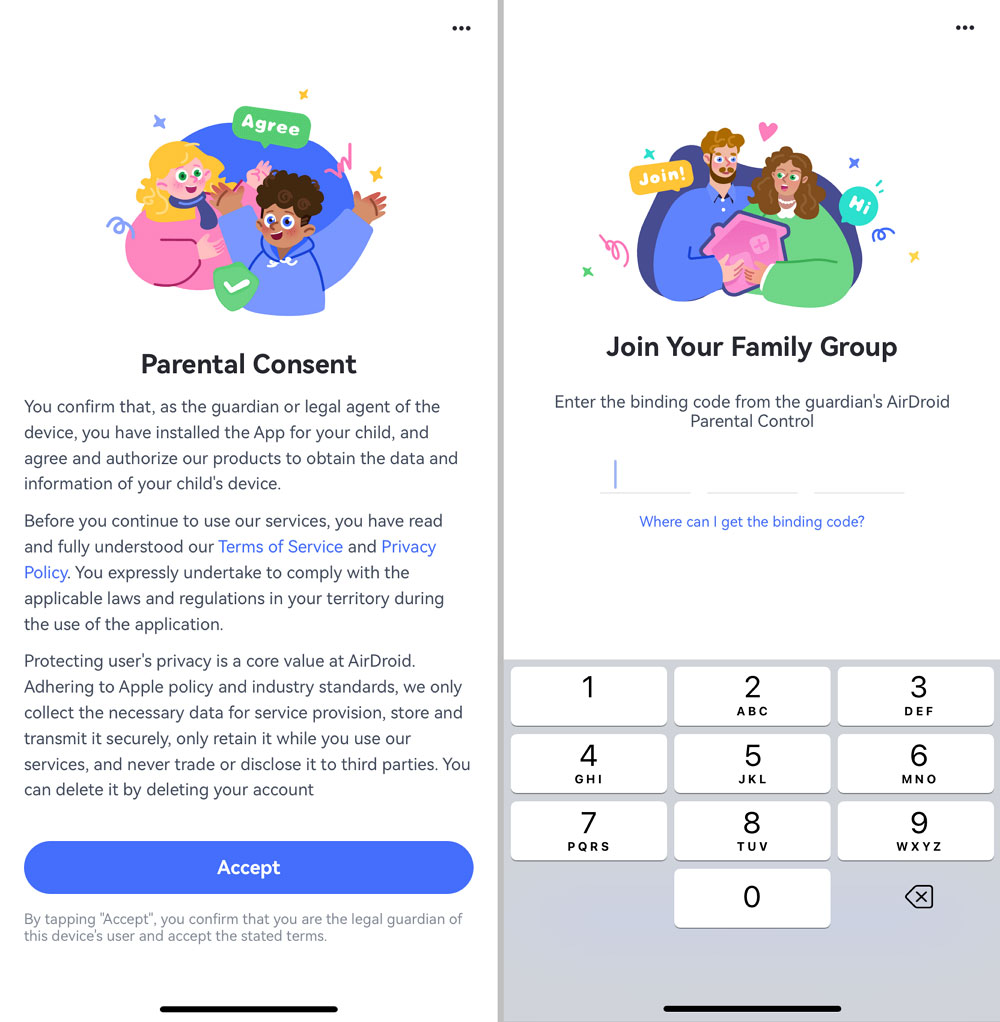
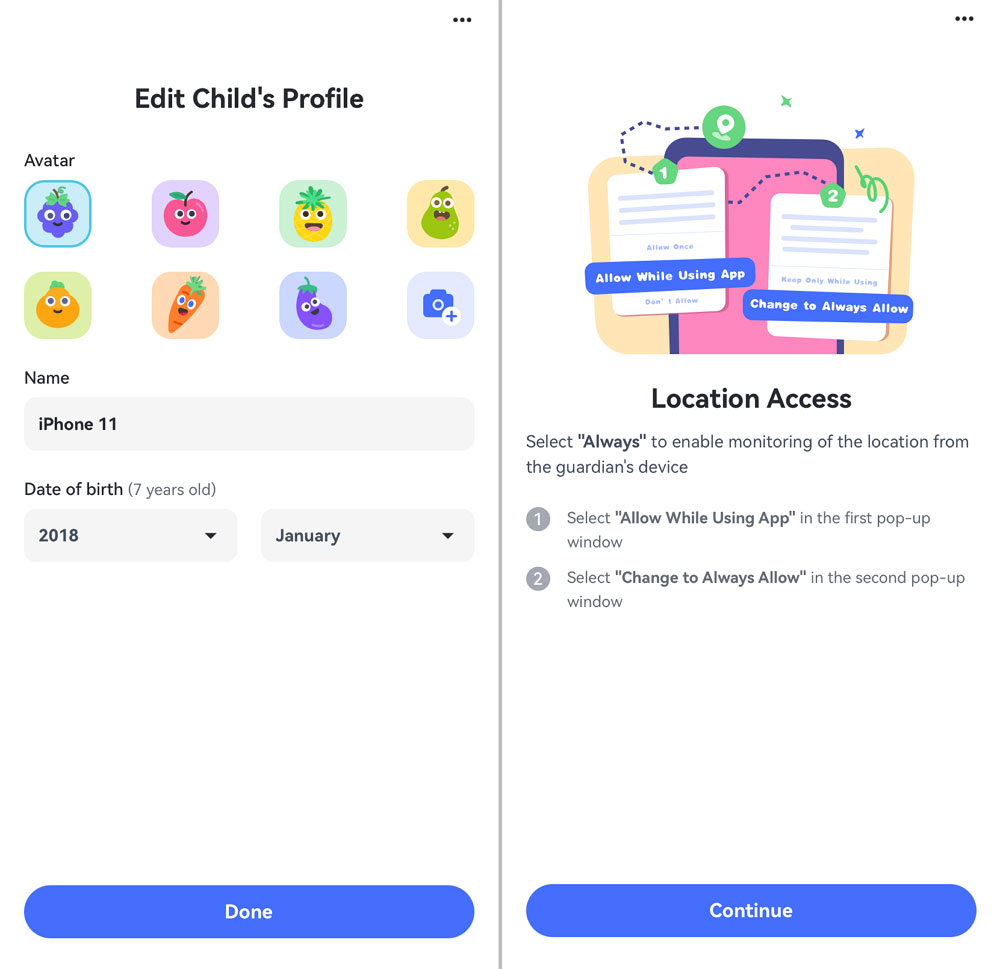
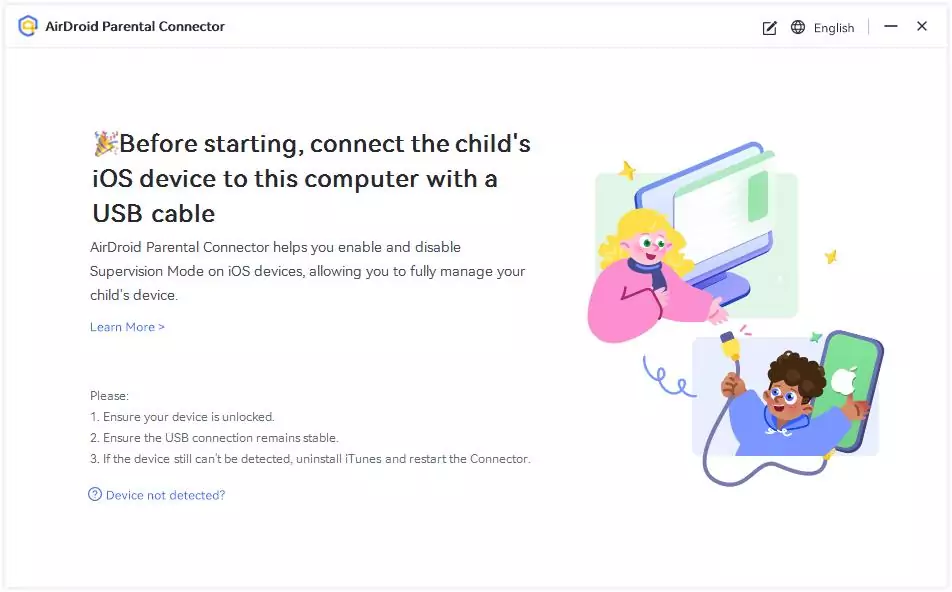
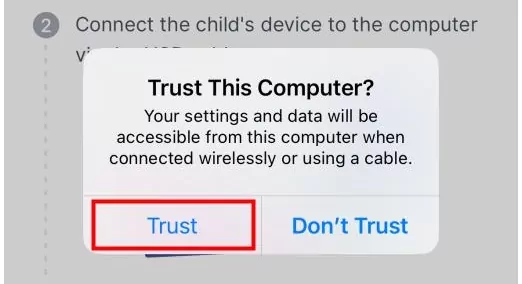
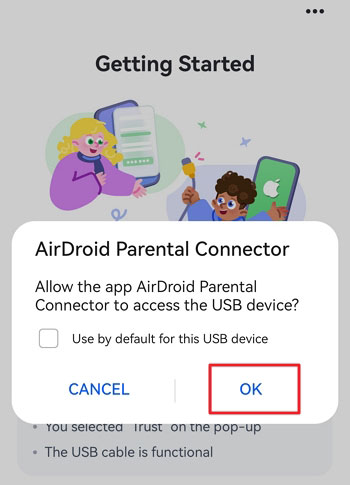
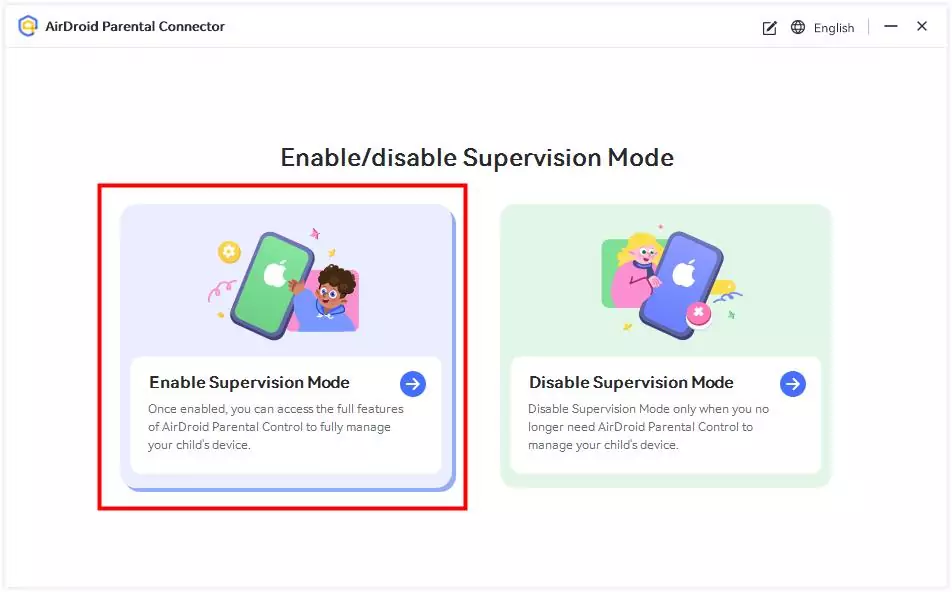

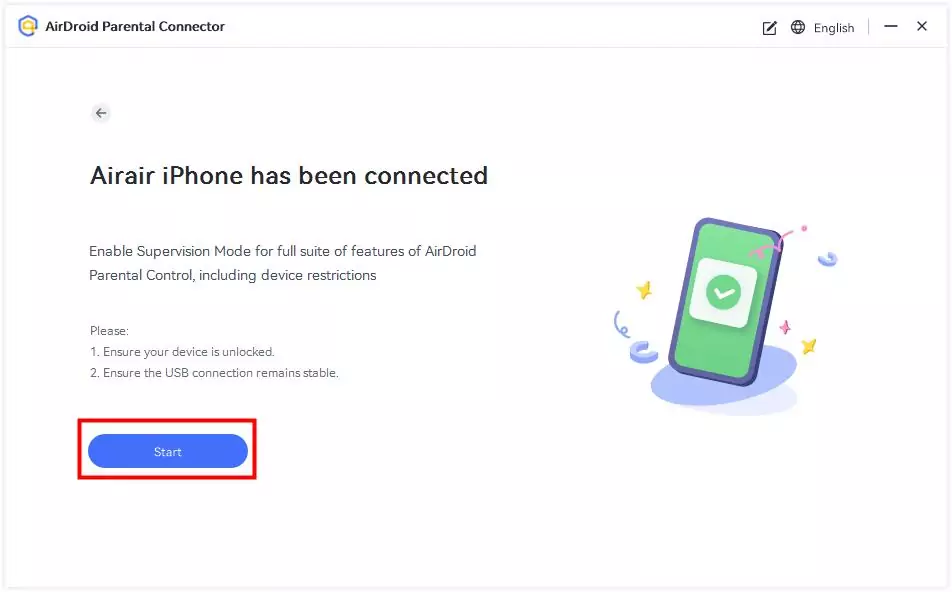
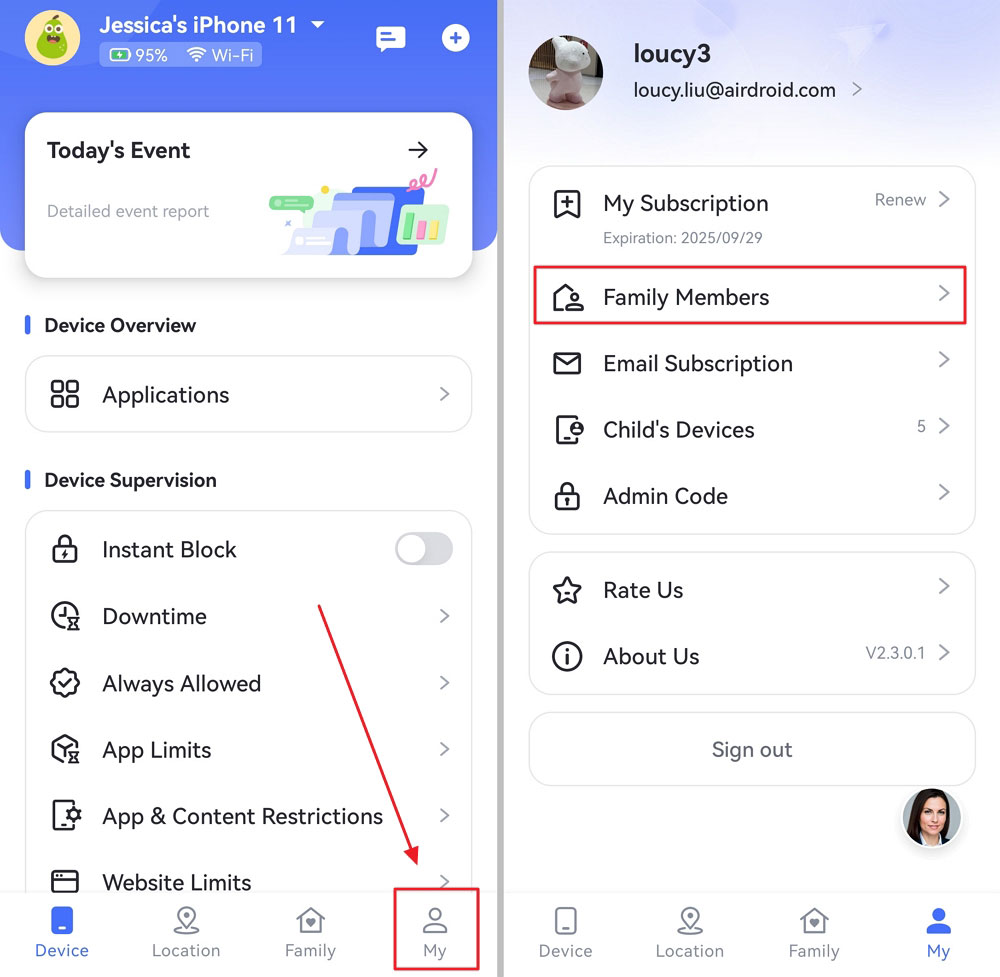
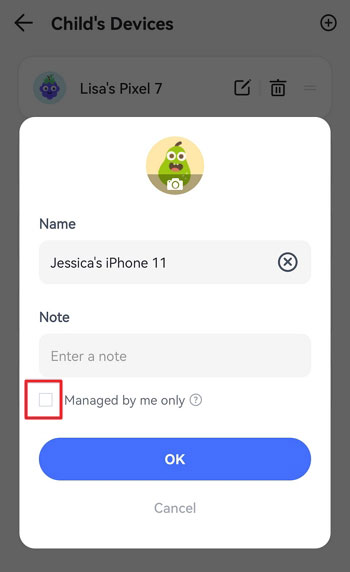
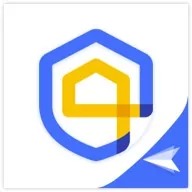
Leave a Reply.